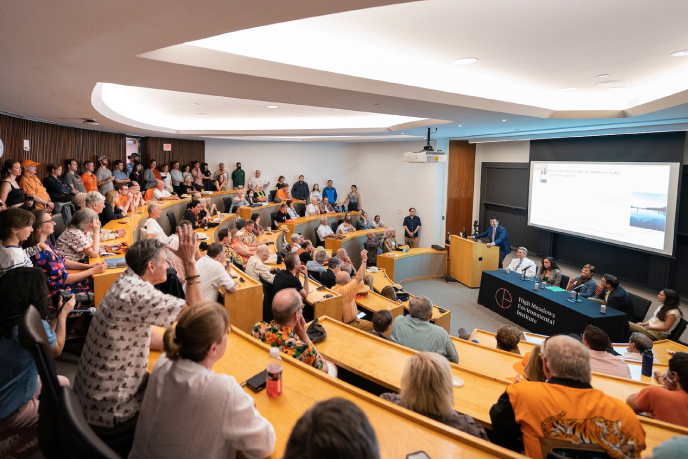Meet Our Past Interns - 2022
- Biodiversity and Conservation
-
Baidoo, Kojo ’24
Ecology and Evolutionary Biology PROJECT
PROJECTThe Role of Multiple Interacting Disturbances in Dictating Savanna Plant Community Composition
ORGANIZATION / LOCATIONPringle Lab, Department of Ecology and Evolutionary Biology, Princeton University - Gorongosa National Park, Mozambique; Kruger National Park, South Africa
MENTOR(S)Robert Pringle, Professor of Ecology and Evolutionary Biology; Joel Abraham, Ph.D. candidate, Ecology and Evolutionary Biology
SEE PRESENTATIONAfrican savannas are subject to a variety of ecological disturbances, including fire, flood, drought, and herbivory. Each of these processes structure plant community composition differently, yet their interactions are not often evaluated together and are difficult to predict. Gorongosa National Park is a conservation success story, with the amazing recovery of many animal species after populations were decimated because of the Mozambican Civil War, while Kruger National Park is a well-known tourism hotspot and is abundant in many archetypal savanna species. In Gorongosa, where fire/herbivory and fire/flooding are the prevailing interactions, I helped to collect and sieve soil samples for nutrient analyses. In Kruger, where drought/fire/herbivory are the prevailing interactions, I helped to conduct dung counts and samples for DNA metabarcoding to evaluate herbivore landscape use and diet. This internship gave me a view into a career path in ecology and academia, the chance to witness and study core processes I had previously learned about in the classroom, and a new appreciation for aspects of the natural world.
-
Baran, Rio ’25
Geosciences
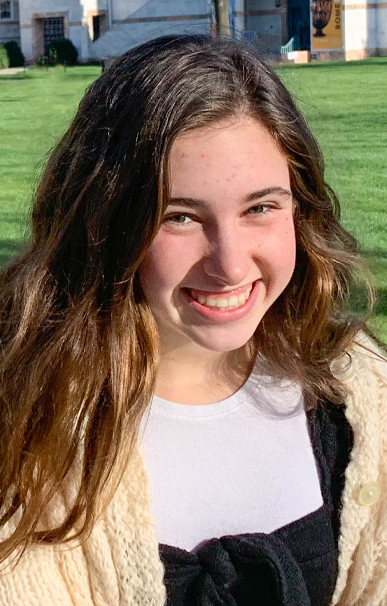 PROJECT
PROJECTTeaching Assistant for Conservation Clubs
ORGANIZATION / LOCATIONRubenstein Lab, Department of Ecology and Evolutionary Biology, Princeton University - Mpala Research Centre, Nanyuki, Kenya
MENTOR(S)Daniel Rubenstein, Class of 1877 Professor of Zoology, Professor of Ecology and Evolutionary Biology
SEE PRESENTATIONOver eight weeks, I brought conservation education to 16 after-school groups around Laikipia County, Kenya. Each day, I designed and delivered a lesson to answer a different ecological question. The lessons took different forms, for example using books or games to address questions like “How does energy move through an ecosystem?” During our travels to and from the club sites, I was inspired by elephants, baboons, and other wildlife along the way. When I wasn’t teaching, I helped organize an education fair where each school presented their club’s work in the form of displays, dioramas, dramas, poems, songs, and dances. Community Conservation Day was a success and brought together over 1,500 community members. I made new friends — colleagues, students, and teachers — and learned about a completely new environment; the grassland where I lived. I learned the importance of flexibility, took in the beauty that emerges from the combination of science and art, and realized that conservation is a community project. As an aspiring scientist and conservationist, I commit to grounding future research in the lives, needs, lessons, and expertise of the people around me.
-
Brush, Helen ’24
Ecology and Evolutionary Biology
 PROJECT
PROJECTSeasonality of Plant Interactions in a Changing Arctic
ORGANIZATION / LOCATIONLevine Lab, Department of Ecology and Evolutionary Biology, Princeton University - Toolik Field Station, Fairbanks, Alaska
MENTOR(S)Jonathan Levine, Professor of Ecology and Evolutionary Biology; Ruby An, Ph.D. candidate, Ecology and Evolutionary Biology
SEE PRESENTATIONCertificate(s): Applied and Computational Mathematics
I worked at Toolik Field Station in the Alaskan arctic to investigate how tundra plants use the growing season. This project is important both as a tool for better understanding plant ecology and in the context of the rapidly changing arctic climate. As growing seasons change, tundra plants may change how they use available time, potentially changing community interactions and composition, and this may in turn have important implications for global carbon cycling. I made frequent phenological measurements (i.e., measurements of different stages of a plant’s lifecycle) of 180 individually tagged plants from six common species. These data create a picture of when different plant species are active. I helped with preliminary data processing and used longer term datasets to explore weather patterns at Toolik. A better understanding of the seasonality of tundra plants will require integrating weather and ecological data. In addition to the work, I thoroughly enjoyed walking through the tundra with other members of the Toolik community and speculating about ecological and biological questions. I plan to carry the curiosity that I exercised this summer into the rest of my education and work, and I hope to pursue further research through both fieldwork and theoretical modeling projects. I am grateful to have had the privilege to spend my summer in awe inspiring wilderness with wonderful people.
-
Burghardt, Meera ’24
School of Public and International Affairs
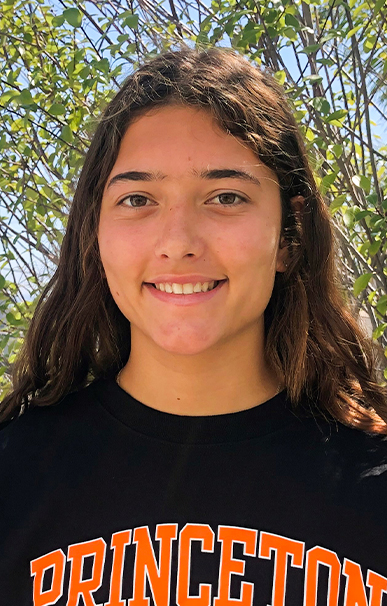 PROJECT
PROJECTInvestigating Water Use by Farmers in Laikipia County, Kenya
ORGANIZATION / LOCATIONRubenstein Lab, Department of Ecology and Evolutionary Biology, Princeton University - Mpala Research Centre, Nanyuki, Kenya
MENTOR(S)Daniel Rubenstein, Class of 1877 Professor of Zoology, Professor of Ecology and Evolutionary Biology
SEE PRESENTATIONI analyzed water use and water-related conflicts by farmers in Laikipia County, Kenya. Laikipia County has been in a severe drought, which has left many households and farmers without water during the dry season as well as during some of the wet season. Farming is one of the most common lifestyles in Kenya and this practice further exacerbates the drought because of how much water farmers use to irrigate their crops. The project aimed to find a solution to this problem that would ensure that farmers use less water while still maintaining crop quality. The majority of farmers use flood irrigation which uses a lot of water. Drip irrigation, the proposed solution, was expected to use significantly less water. We studied farms that used drip and flood irrigation and compared their crop yield, water usage, and water-related conflicts. We found that drip irrigation uses significantly less water than flood irrigation, and that this was associated with fewer water-related conflicts for farmers.
-
Burton, Casey ’24
Ecology and Evolutionary Biology
 PROJECT
PROJECTDeveloping Metrics for Community-scale Biodiversity Restoration and Management
ORGANIZATION / LOCATIONFriends of Princeton Open Spaces (FOPOS) - Princeton, New Jersey
MENTOR(S)Anna Corichi, Director, Natural Resources and Stewardship, FOPOS; Andy Dobson, Professor of Ecology and Evolutionary Biology, Princeton University; Annarie Lyles, Trustee, FOPOS
I interned as a land steward for Friends of Princeton Open Spaces (FOPOS). My co-interns and I worked to increase pollinator habitats and remove invasive plant species. We also collected data that FOPOS needs to apply for the Natural Climate Solutions Grant, which would be used to work on restoring a part of the park called Community Park North. For my own research, I laid the groundwork for future studies on how turtle and insect biodiversity are changing at the Princeton Mountain Lakes Nature Reserve following significant invasive species removal. I collected trial data and tested various methods of data retrieval so that this data could be compared to past and future studies pertaining to species abundance and diversity in comparison to the health of the restoration site. I also planned multiple public engagement events including an “iNaturalist BioBlitz Insect” event, a nighttime moth-sighting event, and I created routes for future turtle sighting events that will include the public.
-
Dominguez, Dominic ’25
Ecology and Evolutionary Biology
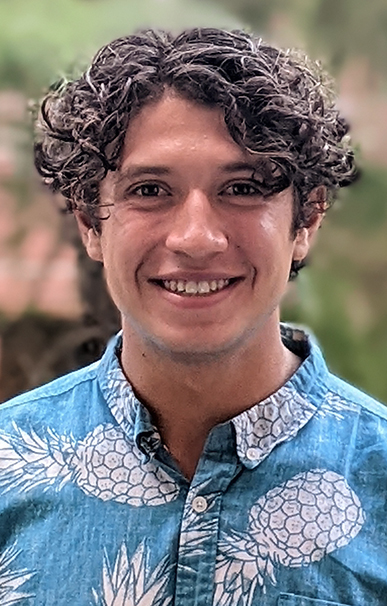 PROJECT
PROJECTClimate Change and Hummingbird Sensory Ecology in the Rocky Mountains
ORGANIZATION / LOCATIONStoddard Lab, Department of Ecology and Evolutionary Biology, Princeton University - Rocky Mountain Biological Laboratory
MENTOR(S)Mary Caswell Stoddard, Associate Professor of Ecology and Evolutionary Biology
SEE PRESENTATIONI studied the impact of Toxoplasma gondii, an introduced parasite, on small carnivores in Madagascar. I used field and laboratory methods to investigate how the parasite is transmitted between domestic and endemic species and then used these results to produce a model of disease transmission. I set up and checked traps for rodents and small carnivores, and tracked captured animals after release. I also assisted another team that was studying mosquitos at the field site. I worked in the laboratory to isolate DNA from samples collected in the field and then identified whether they were positive for the parasite. I gained valuable field and lab skills through this project, including radio telemetry and how to process samples in the field. I was also able to work in a laboratory setting for the first time. This research was fascinating, especially looking at the intersection of a parasite between humans, domestic, and endemic species. It has reinforced my desire to perform field research in the future, and also opened up the possibility of pursuing disease ecology in animals as a future career.
* This internship is connected to the HMEI Climate and Energy Grand Challenges project, “Investigating the Effects of Climate Change on Hummingbird Sensory Landscapes.”
-
Dorini, David ’25
Ecology and Evolutionary Biology
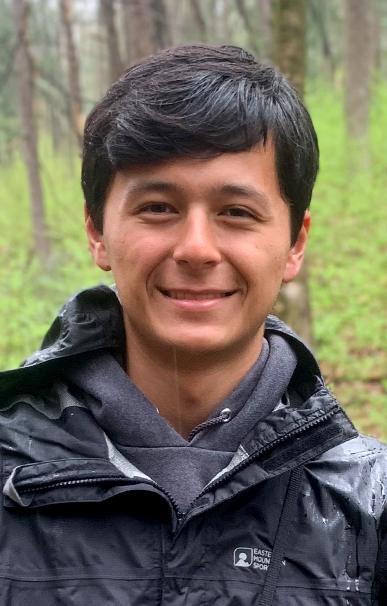 PROJECT
PROJECTPhenology of Bird Migration: The Brown-wave Hypothesis
ORGANIZATION / LOCATIONWilcove Lab, Department of Ecology and Evolutionary Biology, Princeton University - Princeton, New Jersey
MENTOR(S)David Wilcove, Professor of Ecology and Evolutionary Biology and Public Affairs and the High Meadows Environmental Institute; Fengyi Guo, Ph.D. candidate, Ecology and Evolutionary Biology
SEE PRESENTATIONThe brown-wave hypothesis predicts that fall bird migration across the Eastern United States follows the timing of defoliation and subsequent depletion of available food resources. Defoliation patterns are impacted by climate change, so studying nocturnal bird migration over multiple decades allows us to analyze the long-term impacts of climate change. I screened nightly fall radar data from dozens of sites across the Eastern United States from 1995-2014 to enable the testing of the brown-wave hypothesis and its interactions with climate change. For each available night, I first screened the data to determine whether there was sufficient uncontaminated landbird migration to use, as many nights were too contaminated for further analysis. I learned to use various radar data analysis tools to identify these different contaminations, including reflectivity measurements, correlation coefficient measurements, and the direction and speed of different biological movements. If I identified a night as having sufficient uncontaminated landbird migration, I noted the approximate time of that night’s migratory bird takeoff. These nights will be analyzed further in the coming months. I learned a great deal about radar science and modern research in ecology, and I look forward to following the Wilcove Lab’s further inquiry into this subject.
-
Dugan, Christopher ’23
Chemical and Biological Engineering



 PROJECT
PROJECTReserve and Forest Stewardship at The Watershed Institute
ORGANIZATION / LOCATIONThe Watershed Institute - Pennington, New Jersey
MENTOR(S)Allison Jackson, Stewardship Coordinator, The Watershed Institute; Erin Stretz, Assistant Director of Science and Stewardship, The Watershed Institute
SEE PRESENTATIONCertificate(s): Materials Science and Engineering
I worked to improve biodiversity and ecological sustainability at The Watershed Institute while also furthering community involvement and education. I helped remove invasive plants and planted native plants that are resistant to invasive insects. I also worked with volunteers from a variety of local companies, and taught school-aged children about our work and its importance at The Watershed Nature Camp. I learned about a wide variety of native and introduced plants: how to identify them, their roles in and effects on the ecosystem, and how they can be properly managed to support native animals. I also had the chance to experience and observe the intricacies of working in forest management, for example how new developments and approaches are communicated, and how disagreements in the field are discussed and resolved. I now plan to take a course in forest ecology this spring and to apply to jobs in the field of forest management. I enjoyed working on the reserve even with the heat of the summer and would be happy doing more work like this in the future.
-
Farrell, Katie ’25
Undeclared
 PROJECT
PROJECTThe Carolina Wren in Princeton, New Jersey
ORGANIZATION / LOCATIONRiehl Lab, Department of Ecology and Evolutionary Biology, Princeton University - Princeton, New Jersey
MENTOR(S)Christina Riehl, Associate Professor of Ecology and Evolutionary Biology; Trey Hendrix, Ph.D. candidate, Ecology and Evolutionary Biology
I investigated the evolved traits of the Carolina wren, a songbird native to New Jersey that exhibits several unique social behaviors more commonly found in the tropics: monogamous mating with long-term mating pairs; duetting (joint participation in song); and collaborative, year-round territory defense. An understanding of these climate-atypical behaviors and their evolution is critical as the range of the Carolina wren continues to expand northwards, and as the climate continues to change. As part of this study, I tracked the locations and mating habits of several birds of interest, noting especially their chosen nesting sites, their current number of fledglings, and their mating partner. I helped apply color bands to birds, and obtained blood samples from both adults and nestlings. I also photographed specific individuals, which aided identification of individual birds by way of their bands and the presence of radio transmitters on their backs. Working with living subjects was challenging at first but was ultimately an extremely rewarding experience. I learned a number of technical fieldwork skills, and I gained a much more intimate understanding of Princeton’s local ecosystems and the world of evolutionary biology research.
-
Glenetske, Bailey ’25
Geosciences
 PROJECT
PROJECTDeveloping Metrics for Community-scale Biodiversity Restoration and Management
ORGANIZATION / LOCATIONFriends of Princeton Open Spaces (FOPOS) - Princeton, New Jersey
MENTOR(S)Anna Corichi, Director, Natural Resources and Stewardship, FOPOS; Andy Dobson, Professor of Ecology and Evolutionary Biology, Princeton University; Annarie Lyles, Trustee, FOPOS
Certificate(s): Environmental Studies, Journalism
I worked closely with community members to develop strategies for protecting the biodiversity and accessibility of parks in the Princeton-Montgomery Township area. My responsibilities included assessing areas of the Billy Johnson Mountain Lakes Nature Preserve for biodiversity and performing restoration work, such as removing invasive species and planting natives. I also had the opportunity to work closely with the staff and board members of Friends of Princeton Open Spaces (FOPOS). My research specialization for the internship was geographic information system (GIS) mapping. I collected GPS data from various areas of the park in order to create custom, geo-referenced maps for ongoing use by FOPOS. I used a Garmin GPS device to collect the updated data and then cross-checked it with the existing data using geo-referenced maps through the Avenza Maps app on my iPhone. Then, I transferred the GPS data onto my computer, where I used the software Garmin BaseCamp and ArcGIS Pro to design and export the maps for use. With my new mapping skills and experiences, I am excited to research the expanding applications of GIS mapping in the fields of climate science and its intersection with biodiversity conservation.
-
Gong, Connie ’25
Anthropology
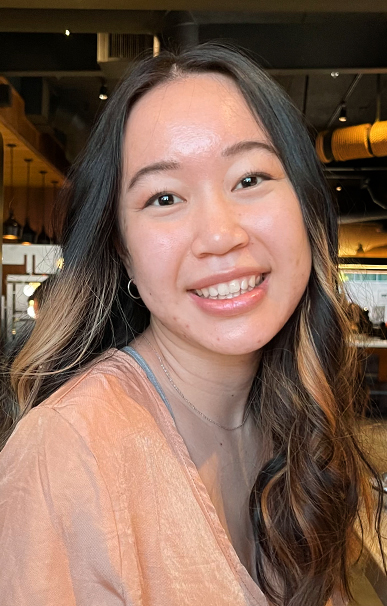 PROJECT
PROJECTTeaching Assistant for Conservation Clubs
ORGANIZATION / LOCATIONRubenstein Lab, Department of Ecology and Evolutionary Biology, Princeton University - Mpala Research Centre, Nanyuki, Kenya
MENTOR(S)Daniel Rubenstein, Class of 1877 Professor of Zoology, Professor of Ecology and Evolutionary Biology
SEE PRESENTATIONCertificate(s): African Studies, Environmental Studies
The Northern Kenya Conservation Clubs (NKCC) use experiential learning to foster awareness of environmental problems, and empower students to lead community conservation projects. As an intern for the NKCC, I worked as a teacher, community organizer, and graphic designer. I developed and facilitated lessons that taught local students about basic ecological concepts and conservation issues through games and art making. I also worked with fellow interns to organize Community Conservation Day, a showcase of the club’s accomplishments achieved over the past year. Community Conservation Day brings together students, teachers, and community members from across Laikipia. Working with the NKCC exposed me to a wealth of ecological knowledge. I was humbled by and fascinated with the origins of this knowledge and the stories that accompany it. For my senior thesis work, I am interested in returning to Kenya to write an ethnography about such stories and how they interact with Laikipian communities’ perceptions of climate change. My experiences have also inspired me to pursue a certificate in African Studies.
-
Gottfried , Julian ’24
Ecology and Evolutionary Biology
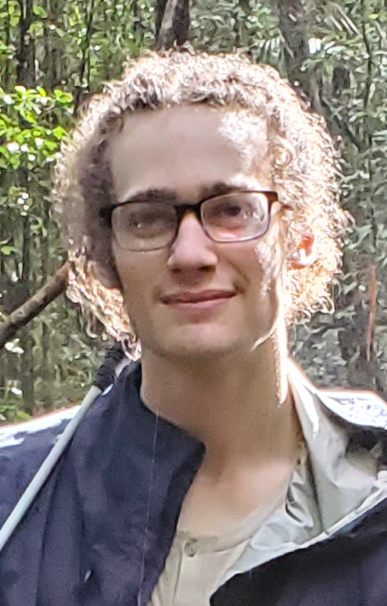 PROJECT
PROJECTHealth and Conservation at the Human-Domestic Animal-Wildlife Interface in Madagascar
ORGANIZATION / LOCATIONMetcalf Lab, Department of Ecology and Evolutionary Biology, Princeton University - Antananarivo, Madagascar; Betampona Natural Reserve, Madagascar
MENTOR(S)C. Jessica Metcalf, Associate Professor of Ecology and Evolutionary Biology and Public Affairs; Fidisoa Rasambainarivo, Postdoctoral Research Associate, High Meadows Environmental Institute; Benjamin Rice, Associate Research Scholar, High Meadows Environmental Institute
SEE PRESENTATIONCertificate(s): Applications of Computing
I studied the spread of an introduced parasite, Toxoplasma gondii, among endemic animals to Madagascar. Village encroachment on the jungle is changing the dynamics of disease by mediating interactions between native wildlife and domestic and invasive species. The disease, toxoplasmosis, has as yet unknown health implications for endemic Madagascan animals, but it presents a major human health risk. This project sought to more fully understand the spread and impact of toxoplasmosis. As a field and lab tech, I checked traps, maintained camera traps, collected biological samples, tracked animals, and collected parasite samples. I also extracted DNA from blood, tissue, and soil samples, and prepared samples for polymerase chain reaction analysis. Additionally, I assisted in the development of a mathematical model of toxoplasmosis transmission. I gained practical skills in field work and knowledge of how to navigate field conditions. I now have a better understanding of how to design research projects. The interdisciplinary nature of this project was by far the most rewarding aspect. I look forward to exploring the complicated world of disease ecology further and using the skills I’ve gained in future field projects.
* This internship is connected to the HMEI Biodiversity Grand Challenges project, “Biodiversity Conservation and Health at the Human-Domestic Animal-Wildlife Interface in Madagascar.”
-
Gotts, Max
Ecology and Evolutionary Biology
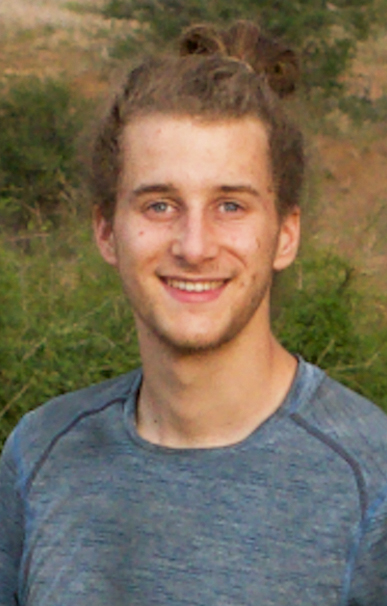 PROJECT
PROJECTRiver Crossings and Wildlife Connectivity in the Laikipia Plateau
ORGANIZATION / LOCATIONMpala Research Centre -Mpala Research Centre, Nanyuki, Kenya
MENTOR(S)Kimani Ndung’u, Researcher and Field Instructor, Mpala Research Centre; Dino Martins, Chief Executive Officer, Turkana Basin Institute; Daniel Rubenstein, Class of 1877 Professor of Zoology, Professor of Ecology and Evolutionary Biology, Princeton University
SEE PRESENTATIONCertificate(s): Applied and Computational Mathematics
I investigated the role of rivers in impeding megafauna traffic along wildlife corridors to understand the potential impacts of the proposed Crocodile Jaws Dam in Laikipia County, Kenya on wildlife migrations and ambulation. Wildlife corridors allow animals to move between protected land based on seasonal patterns, weather variation, and prey abundance. The Crocodile Jaws Dam will back up to the Ewaso Ngiro River to create a large lake; since animals cannot comfortably cross lakes, this construction may pose major problems for animals that presently cross the river. We used a mixture of fieldwork and modeling to investigate this problem. We collected field data on wildlife usage of key river crossings using animal tracks, and determined whether individuals crossed or not. We also collected data on environmental variables such as river speed and depth, physical geography of the surrounding area, grass cover, and substrate type. Then, we used these variables to create a model to determine whether or not Crocodile Jaws Dam will limit animals from moving across Laikipia’s landscape. Performing this research provided me the opportunity to contribute to a scientific project, to enjoy Kenya’s incredible savanna ecosystems, and to work with knowledgable colleagues to protect key megafauna in a changing world.
-
Gregory, Alliyah ’25
Ecology and Evolutionary Biology
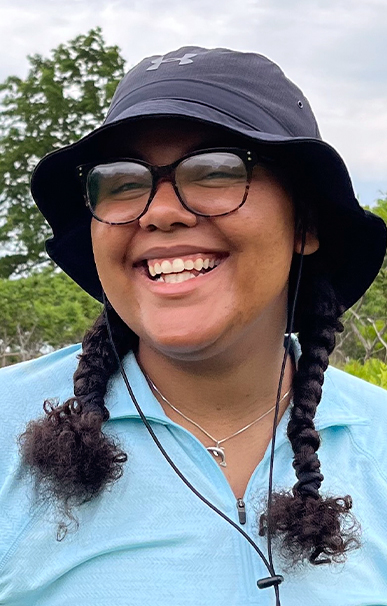 PROJECT
PROJECTPlant Conservation in the Natural Areas of New York City Parks
ORGANIZATION / LOCATIONNatural Resources Group, New York City Department of Parks and Recreation (NYC Parks)
MENTOR(S)Clara Holmes, Plant Ecologist, NYC Parks; Desiree Yanes, Vegetation Monitoring Technic, NYC Parks
SEE PRESENTATIONCertificate(s): Environmental Studies
I developed conservation assessments for two plant species of local conservation concern in New York City: Amelanchier nantucketensis (Nantucket juneberry) and Sanguisorba canadensis (Canadian burnet). To produce these conservation assessments, I researched basic information on their biology, habitat, and ecology, in addition to specific threats that these species face within New York City. I also researched methods that could be implemented to help save them. Conservation assessments are important because they provide a comprehensive resource for conservationists with all of the information they need to execute conservation measures. I also participated in fieldwork to monitor rare, threatened, and endangered species within the natural areas of New York City parks. This was insightful for me because I had no prior knowledge of conservation efforts in urban areas. I learned about the wide variety of ecosystems that exist in these areas, from forests, to beaches, to salt marshes. My time with NYC Parks cemented my interest in conservation and introduced me to fieldwork. I am now hoping to include these aspects in my future career.
-
Heine, Alex ’24
Ecology and Evolutionary Biology
 PROJECT
PROJECTHealth and Conservation at the Human-Domestic Animal-Wildlife Interface in Madagascar
ORGANIZATION / LOCATIONMetcalf Lab, Department of Ecology and Evolutionary Biology, Princeton University - Antananarivo, Madagascar; Betampona Natural Reserve, Madagascar
MENTOR(S)C. Jessica Metcalf, Associate Professor of Ecology and Evolutionary Biology and Public Affairs; Fidisoa Rasambainarivo, Postdoctoral Research Associate, High Meadows Environmental Institute; Benjamin Rice, Associate Research Scholar, High Meadows Environmental Institute
SEE PRESENTATIONCertificate(s): Archaeology, Environmental Studies
I studied the impact of Toxoplasma gondii, an introduced parasite, on small carnivores in Madagascar. I used field and laboratory methods to investigate how the parasite is transmitted between domestic and endemic species and then used these results to produce a model of disease transmission. I set up and checked traps for rodents and small carnivores, and tracked captured animals after release. I also assisted another team that was studying mosquitos at the field site. I worked in the laboratory to isolate DNA from samples collected in the field and then identified whether they were positive for the parasite. I gained valuable field and lab skills through this project, including radio telemetry and how to process samples in the field. I was also able to work in a laboratory setting for the first time. This research was fascinating, especially looking at the intersection of a parasite between humans, domestic, and endemic species. It has reinforced my desire to perform field research in the future, and also opened up the possibility of pursuing disease ecology in animals as a future career.
* This internship is connected to the HMEI Biodiversity Grand Challenges project, “Biodiversity Conservation and Health at the Human-Domestic Animal-Wildlife Interface in Madagascar.”
-
Hirschman, Wes ’24
Operations Research and Financial Engineering
 PROJECT
PROJECTImpact of Grazing Regimes on Rangeland Quality and Wildlife and Livestock Use
ORGANIZATION / LOCATIONRubenstein Lab, Department of Ecology and Evolutionary Biology, Princeton University - Mpala Research Centre, Nanyuki, Kenya
MENTOR(S)Daniel Rubenstein, Class of 1877 Professor of Zoology, Professor of Ecology and Evolutionary Biology
SEE PRESENTATIONCertificate(s): Finance, Optimization and Quantitative Decision Science
I interned at the Mpala Research Centre as part of Princeton’s multiyear Zebra Project. Our work was primarily focused on understanding the impacts that grazing cattle herds have on zebra populations. We are seeking to understand whether the relationship between cattle and zebras is competitive or mutualistic. To answer this, we collected large amounts of data on zebra behavior (by mapping their locations every day and creating heatmaps of their distribution across the landscape), cattle patterns (with GPS tracking tags placed on each cattle herd), and vegetation data (via vegetation transects and satellite imaging). This internship gave me the opportunity to learn much more about the environment, environmental research, animal behavior, and human-animal interactions. I now have a better understanding of how data science and research is conducted in a real-world environment, the many added challenges that come with such an environment, and I have a much greater appreciation for the important role the environment plays in our everyday lives. This opportunity has shown me the value of applying my Princeton education beyond topics strictly within my field of study, and I intend to continue to diversify my work experiences.
-
Hosny, Noreen ’25
Molecular Biology
 PROJECT
PROJECTAnalysis of Climate-driven Body-size Changes in the Marine Fossil Record
ORGANIZATION / LOCATIONDeutsch Research Group, Department of Geosciences, Princeton University - Princeton, New Jersey
MENTOR(S)Curtis Deutsch, Professor of Geosciences and the High Meadows Environmental Institute
SEE PRESENTATIONCertificate(s): Environmental Studies, Visual Arts
As ocean temperatures rise, dissolved oxygen decreases. Yet, marine life requires more oxygen in warmer environments. This inconsistency may shape organisms’ adaptations by causing them to mature at smaller body sizes. I sought to quantify and understand how climate-driven changes to temperature and oxygen affect the body size of benthic (bottom-dwelling) and planktonic (surface-dwelling) foraminifera (single-celled zooplankton). I used temperature and body size data collected from previous literature to calculate and visualize the temperature size effect (TSE) in the program MATLAB for various foraminifera species. We observed very large TSE values and concluded that temperature alone cannot justify these body size changes. I next investigated how the species’ metabolic index (MI) is affected by these changes, since MI accounts for oxygen and temperature simultaneously. I created a trait database documenting the body mass changes and respiration rates and then analyzed these variables in MATLAB to find that oxygen limitation plays a primary role in body size variation. I learned about the pressing effect of climate change on marine biodiversity, which informed my decision to pursue an Environmental Studies certificate. I hope to take environmental science and policy classes to further inform my climate science research.
-
Jordan, Eva ’24
Civil and Environmental Engineering
 PROJECT
PROJECTHealth and Conservation at the Human-Domestic Animal-Wildlife Interface in Madagascar
ORGANIZATION / LOCATIONMetcalf Lab, Department of Ecology and Evolutionary Biology, Princeton University - Antananarivo, Madagascar; Betampona Natural Reserve, Madagascar
MENTOR(S)C. Jessica Metcalf, Associate Professor of Ecology and Evolutionary Biology and Public Affairs; Fidisoa Rasambainarivo, Postdoctoral Research Associate, High Meadows Environmental Institute; Benjamin Rice, Associate Research Scholar, High Meadows Environmental Institute
SEE PRESENTATIONI studied the dynamics of Toxoplasma gondii infection in Betampona Natural Reserve, Madagascar. Toxoplasma gondii is an introduced parasite to the island that also causes disease in humans. Our goal was to construct a model describing transmission at the interface between domestic animals and wildlife in order to determine the most effective conservation strategies for biodiversity in areas of the world affected by toxoplasmosis. Our field work involved trapping endemic carnivores such as fossa, ring-tailed vontsira, and broad-striped vontsira, as well as endemic and invasive rodents, and collecting biological specimens from these animals to be analyzed for the parasite. We also collected mosquito and leech specimens from both the forest and the research station to better understand how these disease vectors are distributed and how they affect disease transmission. Through this internship, I gained a clearer understanding of how conservation, health studies, and engineering can fit together to form a truly important project, and I came away better able to think about designing research questions for independent work or a thesis.
* This internship is connected to the HMEI Biodiversity Grand Challenges project, “Biodiversity Conservation and Health at the Human-Domestic Animal-Wildlife Interface in Madagascar.”
-
Keim, Catherine ’23
Ecology and Evolutionary Biology
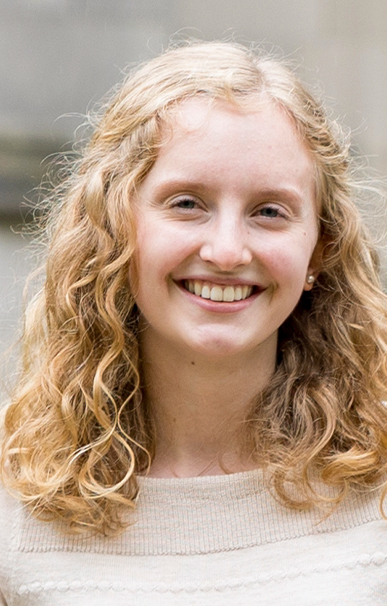 PROJECT
PROJECTAssessing the Impact of Large Carnivore Reintroduction on Community Structure and Functioning in a Recovering African Savanna
ORGANIZATION / LOCATIONPringle Lab, Department of Ecology and Evolutionary Biology, Princeton University - Gorongosa National Park
MENTOR(S)Robert Pringle, Professor of Ecology and Evolutionary Biology; Erin Philips, Ph.D. candidate, Ecology and Evolutionary Biology
SEE PRESENTATIONCertificate(s): Statistics and Machine Learning
I studied the ecology of mesocarnivores in Gorongosa National Park, Mozambique. Mesocarnivores are midsized carnivores; in Mozambique they include species such as civets, genets, and mongooses. These mammals are abundant in Gorongosa but are relatively understudied and my work contributed to our knowledge of mesocarnivore diet and behavior in savanna ecosystems. Gorongosa is an especially good location in which to conduct this research, because the larger predator populations (lions, leopards, etc.,) were almost entirely destroyed during the Mozambican Civil War (1977-1992). This absence of large carnivores allows us to study mesocarnivore behavior without the potential competition from larger predators. Additionally, mesocarnivore behavior can be studied continuously over time as conservation and reintroduction efforts reintroduce top predators to the park. We collected civet, genet, and mongoose fecal samples for diet analysis and comparison. We also used camera traps, which take pictures or videos when a sensor detects motion, to study mesocarnivore behavior and movement across the park. The main experiment we did was a carcass study, where we observed scavenging behavior and nutrient distribution at sites of dead animals. Overall, I learned new field research techniques and had the privilege of working in a beautiful and dynamic ecosystem.
-
Lausted, Madeleine ’24
Ecology and Evolutionary Biology
 PROJECT
PROJECTHealth and Conservation at the Human-Domestic Animal-Wildlife Interface in Madagascar
ORGANIZATION / LOCATIONMetcalf Lab, Department of Ecology and Evolutionary Biology, Princeton University - Antananarivo, Madagascar; Betampona Natural Reserve, Madagascar
MENTOR(S)C. Jessica Metcalf, Associate Professor of Ecology and Evolutionary Biology and Public Affairs; Fidisoa Rasambainarivo, Postdoctoral Research Associate, High Meadows Environmental Institute; Benjamin Rice, Associate Research Scholar, High Meadows Environmental Institute
SEE PRESENTATIONCertificate(s): French Language and Culture, Global Health and Health Policy
Toxoplasma gondii is a zoonotic parasite that relies on felid hosts for sexual reproduction but has been highly effective at infecting a wide range of warm-blooded hosts across the world. The parasite can be acquired through environmental contact or consuming infected meat. Research indicates that T. gondii arrived more recently to Madagascar, and that endemic species are increasingly coming into contact with T. gondii through intermediate hosts such as black rats and domestic chickens. I assisted the Metcalf Lab in characterizing the spread of T. gondii in Madagascar. My co-interns and I took biological samples from a range of endemic carnivores and invasive species. This included hands-on work to safely trap the subjects, take samples, and release them. We also set and monitored camera traps to gather behavioral data. We extracted DNA from the samples and completed other processing in a molecular laboratory. We were able to estimate the prevalence of T. gondii among endemic and invasive species, which provides a strong foundation for the continuation of the project in future years. We hope these results will give valuable insights to conservation and public health efforts.
* This internship is connected to the HMEI Biodiversity Grand Challenges project, “Biodiversity Conservation and Health at the Human-Domestic Animal-Wildlife Interface in Madagascar.”
-
Madsen, Heather ’24
Geosciences
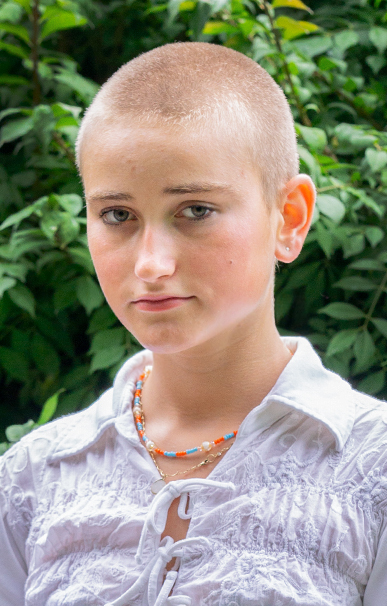 PROJECT
PROJECTHydroponic Investigation of Isotopic Fractionation in Arabidopsis
ORGANIZATION / LOCATIONHiggins Lab, Department of Geosciences, Princeton University - Princeton, New Jersey
MENTOR(S)John Higgins, Associate Professor of Geosciences; Mason Scher, Ph.D. candidate, Geosciences
SEE PRESENTATIONCertificate(s): Archaeology
I aimed to determine the role of nutrient availability in the selective incorporation of nutrient isotopes into the corpus of Arabidopsis plants. Metal fractionation is a trophic trend that allows researchers to use isotopic composition to place different species in their respective niches within ecological systems past and present. This provides an advanced understanding of ecological interconnectivity that deepens our understanding of past trophic relationships, underscoring the evolution of specific niches over time. This has not only profound geological implications but also offers insight into conservation potential. Trophic cascades are one of the major side effects of resource depletion, and the identification of these cascades would be aided by advancements in scientific research on isotopic fractionation up the trophic pyramid. The trends observed in the Arabidopsis I grew will ultimately provide a baseline of autotrophic fractionation to demonstrate the significance of the selective physiological uptake of calcium, magnesium, and potassium isotopes. My initial research functioned to isolate and address unforeseen issues to streamline future growth, but repetition of this experimental model will undoubtedly be required to provide optimal results. I plan to continue this research for independent work this fall.
-
Martinez, Daniela ’24
Civil and Environmental Engineering
 PROJECT
PROJECTReserve and Forest Stewardship
ORGANIZATION / LOCATIONThe Watershed Institute - Pennington, New Jersey
MENTOR(S)Allison Jackson, Stewardship Coordinator, The Watershed Institute; Erin Stretz, Assistant Director of Science and Stewardship, The Watershed Institute
SEE PRESENTATIONThe Watershed Institute consists of approximately 950 acres of preserved land in Mercer County, New Jersey. I aided the stewardship and conservation team in restoring forest health through nonnative invasive species removal and repopulating these areas with native plants. I learned about two different management strategies that reduce damage from deer activity. We removed nonnative invasive species and repopulated native plants inside two established deer enclosures — fenced-off areas that keep deer out — and we installed tree tubes to protect new plantings outside of the deer enclosures. Another of our restoration efforts involved removing dead ash trees impacted by the emerald ash borer, an invasive species of beetle. In wetland habitats, I helped create a floating wetland, which is an artificial platform that floats on the lake’s surface to support native aquatic plant growth. I also helped manage existing floating wetlands by removing invasive species and replanting native species. Through woodworking, I created bird boxes to create habitats for eastern bluebirds and red headed woodpeckers. Overall, I gained insight and experience in various habitat restoration and forest management strategies, and learned how these strategies change based on the final goal.
-
McGonigle, Evelyn ’25
Operations Research and Financial Engineering
 PROJECT
PROJECTAnalysis of Climate-driven Body Size Changes in the Marine Fossil Record
ORGANIZATION / LOCATIONDeutsch Research Group, Department of Geosciences, Princeton University - Princeton, New Jersey
MENTOR(S)Curtis Deutsch, Professor of Geosciences and the High Meadows Environmental Institute
SEE PRESENTATIONI worked on a project that aims to determine the driving environmental components behind the temperature size effect, the negative correlation between temperature and animal body size. My specific role was to collect and analyze data on ostracods, which are tiny marine crustaceans that have existed for millions of years. At the start of the internship, I focused on learning how to use the program MATLAB to compare the modern laboratory model correlating ostracod body size with temperature to the same relationship within the fossil record. My analysis showed that changes in paleo-ostracod body size were more significant than could be accounted for by the modern model. I spent the second half of the internship analyzing ostracod metabolism. This involved a lot of literature review to find metabolic parameters in published studies, and helped determine the missing factor behind these body size changes. Before this summer, I had never been involved in research, and I am looking forward to applying my newfound data analysis skills in both my studies and my future career.
-
McLaughlin, Katherine ’25
Undeclared
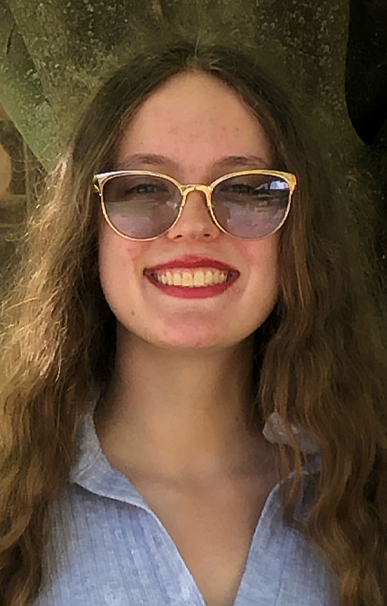 PROJECT
PROJECTDeveloping Metrics for Community-scale Biodiversity Restoration and Management
ORGANIZATION / LOCATIONFriends of Princeton Open Spaces (FOPOS) - Princeton, New Jersey
MENTOR(S)Anna Corichi, Director, Natural Resources and Stewardship, FOPOS; Andy Dobson, Professor of Ecology and Evolutionary Biology, Princeton University; Annarie Lyles, Trustee, FOPOS
I studied the survival rates of native flora species in Princeton, New Jersey. This research furthered the efforts of Friends of Princeton Open Spaces (FOPOS) to create a local healthy and biodiverse ecosystem. My co-intern and I developed a protocol for determining the survival of planted native species. We considered factors such as method of planting, canopy cover, environmental pressures, and other species present. Cataloging the species in this way allowed us to gauge the site’s ecological health in a Floristic Quality Assessment. This research and protocol will enable FOPOS, and other such organizations to achieve greater success in restoring healthy forest ecosystems. I also acted as a land steward by removing invasive species, planting native flowers, and coordinating volunteer sessions. Additionally, I assisted with turtle and insect surveys and a carbon storage survey. I learned much about how field research considers the broad workings of a forest site and how to include many elements while still developing useful data. This internship further illuminated the important intersection between community engagement, local protected spaces, and greater biodiversity on a larger scale. I look forward to continuing to research forest stewardship.
-
Morris, Jahir ’24
Ecology and Evolutionary Biology
 PROJECT
PROJECTEvolution and Species Diversity Maintenance of Orchard Flies
ORGANIZATION / LOCATIONLevine Lab, Department of Ecology and Evolutionary Biology, Princeton University - Princeton, New Jersey
MENTOR(S)Jonathan Levine, Professor of Ecology and Evolutionary Biology
SEE PRESENTATIONI studied North American fruit flies and the extent to which the rapid evolution of competitive ability can facilitate their coexistence. Ecological theory supports the prediction that rapid evolutionary changes amongst populations of competing species will stabilize their competitive interactions, thus allowing for their coexistence. However, there have been a limited number of studies that systematically test this conclusion to prove its prevalence in natural systems. The three focal species of our research were Drosophila melanogaster, Drosophila hydei, and Zaprionus indianus. Our first experiment assessed the potential for the evolution of competitive ability to impact coexistence. We placed fly populations with varied adaptive potentials in competition with one another over several generations. The second experiment measured the mechanism by which evolution affects competitive interactions by placing a single pair of species in competition over several generations, but with populations of varied relative abundance. We also routinely captured and identified samples of flies from a local orchard to examine how the evolution of competitive ability impacts coexistence amongst more diverse fly communities in nature. I’ve gained invaluable experience in designing experimental research and an understanding of how ecological processes and evolutionary mechanisms cofunction to sustain diverse communities of organisms.
* This internship is connected to the HMEI Biodiversity Grand Challenges project, “The Maintenance of Species Diversity through the Rapid Evolution of Competitive Ability.”
-
Nguyen, Tobias ’24
Ecology and Evolutionary Biology
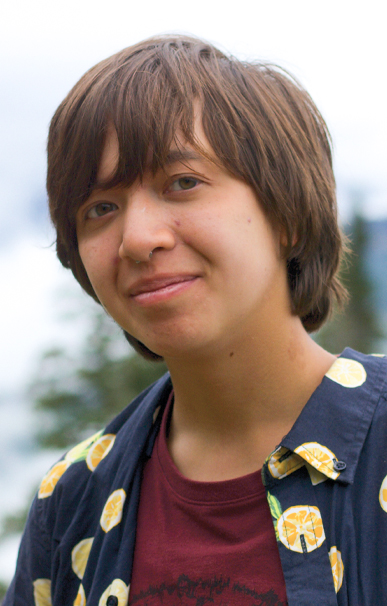 PROJECT
PROJECTClimate Change and Hummingbird Sensory Ecology in the Rocky Mountains
ORGANIZATION / LOCATIONStoddard Lab, Department of Ecology and Evolutionary Biology, Princeton University - Rocky Mountain Biological Laboratory
MENTOR(S)Mary Caswell Stoddard, Associate Professor of Ecology and Evolutionary Biology
SEE PRESENTATIONI helped collect data for a long-term study on the phenology of broad-tailed hummingbirds and the wildflowers they pollinate. The aim of this project is to observe the shifting visitation rates for various flower species as climate change progresses. To that end, our team placed camera traps on wildflowers of interest to record feeding events; this data will be processed throughout the coming year. We also collected flower specimens to create a database of their anatomy and exact color values using a spectrophotometer. Lastly, we conducted weekly wildflower surveys using transects to determine the changing abundance of each species of interest. This was my first look into real-world research and fieldwork. I gained experience not only with the equipment and methods used by the lab group but also with the nature of research and professional collaboration. I worked as part of a team that, for the first time in this study, fully undertook the tasks of spectrophotometry and transect data collection. In all, this was an exciting look into the world of fieldwork and ecological research, and I am left feeling more confident about what a future in ecology may look like.
* This internship is connected to the HMEI Climate and Energy Grand Challenges project, “Investigating the Effects of Climate Change on Hummingbird Sensory Landscapes.”
-
Pinkerton, Anna ’24
Geosciences



 PROJECT
PROJECTSeed Preferences, Predation, and Dispersal in Kenya by Messor Harvester Ants
ORGANIZATION / LOCATIONMpala Research Centre - Nanyuki, Kenya
MENTOR(S)Dino Martins, Chief Executive Officer, Turkana Basin Institute; Ivy Ng’iru, Project Manager and Scientific Researcher, Mpala Research Centre
SEE PRESENTATIONCertificate(s): Environmental Studies, French Language and Culture
I worked with the Harvester Ant Project to examine the nest location and diet of the harvester ant Messor cephalotes. Our primary objectives were to determine whether Messor cephalotes show any preference for nest building in the three known soil types at Mpala Research Centre, to assess whether there is any relationship between nest longevity and soil type, and to observe the diet constituent of Messor cephalotes as a function of food availability. I collected GPS data of dozens of nests across Mpala’s diverse landscape, took measurements of the physical characteristics of the nests, and observed the collection behaviors of the ants. Through this experience, I have gained valuable insight into fieldwork and research. I learned how to collect, organize, and subsequently analyze data, as well as make maps using GPS coordinates. My time working on the Harvester Ant Project has taught me how to conduct fieldwork, which will be relevant to my geosciences concentration, as well as any future work in environmental science.
-
Sanders, Felicia ’25
Undeclared
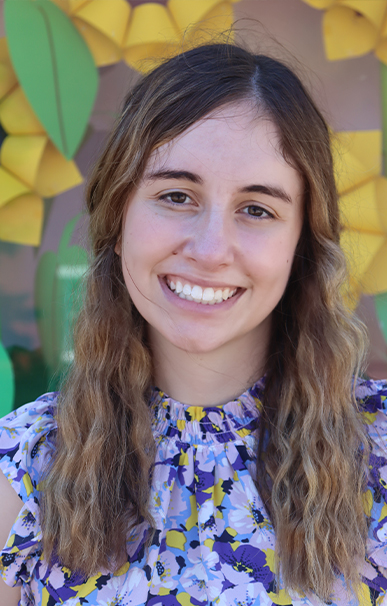 PROJECT
PROJECTDeveloping Metrics for Community-scale Biodiversity Restoration and Management
ORGANIZATION / LOCATIONFriends of Princeton Open Spaces (FOPOS) - Princeton, New Jersey
MENTOR(S)Anna Corichi, Director, Natural Resources and Stewardship, FOPOS; Andy Dobson, Professor of Ecology and Evolutionary Biology, Princeton University; Annarie Lyles, Trustee, FOPOS
I collaborated with Friends of Princeton Open Spaces (FOPOS), which oversees land stewardship projects at the Billy Johnson Mountain Lakes Nature Preserve. This work includes the removal of invasive plants and the planting of native plants to help restore biodiversity and ecosystem health to a heavily degraded area. Because FOPOS’ work is supported by donations and grants, it is critical to understand which management techniques are most successful so that resources can be used effectively. I conducted surveys throughout the preserve’s 18-acre forest restoration site to monitor and compare restoration outcomes. I divided the site into four regions based on how they had been managed, and then studied randomly selected meter by meter plots within each region by analyzing the plants present and their respective concentrations. I then used the identities and proportions of plants present to complete Floristic Quality Assessments (FQA) for each plot and region. These assessments can be used to determine how important it is to manage the land, as regions with high FQA scores contribute more to ecosystem health. This internship inspired me to investigate the intersection of academic research and service, and I hope to focus my future independent work on community-based needs.
-
Williams, Bracklinn ’25
Mathematics
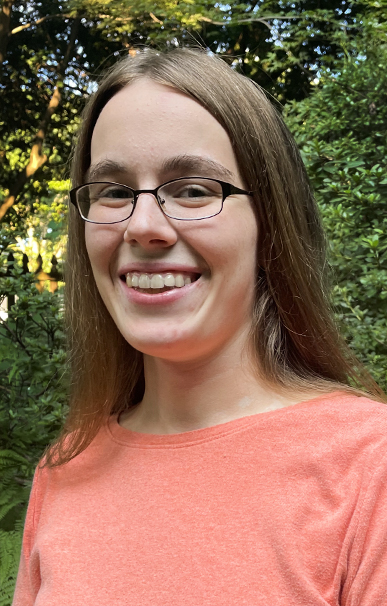 PROJECT
PROJECTPredicting Energy Expenditure of Migratory Land Birds at Stopover Sites
ORGANIZATION / LOCATIONWilcove Lab, Department of Ecology and Evolutionary Biology, Princeton University - Princeton, New Jersey
MENTOR(S)David Wilcove, Professor of Ecology and Evolutionary Biology and Public Affairs and the High Meadows Environmental Institute; Liang Ma, Associate Research Scholar, School of Public and International Affairs
I studied how changes in North American bird populations correlate with different species’ physiological responses to climate. This correlation can be used to estimate what proportion of population decline in these species can be directly attributed to heat stress from climate change, how much is due to indirect effects of climate change, and how much is attributable to non-climate factors. The main focus of my work was in model validation, which involved gathering data, running model code, and plotting the results for our habitat microclimate model and our species metabolism model so that we can be confident they are both reasonably accurate. In addition, I ran regressions and visualized data to better understand and communicate our intermediate results. As well as gaining experience in modeling and in using the program R, I learned a lot from the more creative side of the research. I also enjoyed combining my interests in conservation and the environment with my skills in data science. It was an enjoyable introduction to academic research, and I would love to do similar work in the future.
- Climate and Environmental Science
-
Azmi, Farah ’24
Geosciences



 PROJECT
PROJECTObserving Ocean Ecosystems From Autonomous Floats
ORGANIZATION / LOCATIONScripps Institution of Oceanography, University of California–San Diego - La Jolla, California
MENTOR(S)Sarah Gille, Professor, Scripps Institution of Oceanography; Mara Freilich, Postdoctoral Fellow, Scripps Institution of Oceanography
SEE PRESENTATIONI studied phytoplankton community composition in the Indian sector of the Southern Ocean. I studied differences in community composition between the northern and southern regions of the polar front by using the program MATLAB to analyze biogeochemical float data. There has been some previous work done on phytoplankton growth from a physical perspective, and on phytoplankton community composition from a biological perspective, but there has not been a lot of work done to connect the two pespectives. My project helped to bridge the gap between physical and biological processes and identified an area that should be further explored. Understanding the differences in community composition between these regions helps us to improve phytoplankton growth models, which subsequently helps us to better understand the global carbon cycle. My coding and research skills drastically improved throughout the eight weeks that I worked on this project. I also had the opportunity to meet many wonderful scientists at Scripps who inspired and motivated me to continue doing work in oceanography and climate science.
-
Dani, Sessina ’23
Ecology and Evolutionary Biology
 PROJECT
PROJECTWhat Controls the Biodiversity and Function of Cryptogam Microbiomes?
ORGANIZATION / LOCATIONZhang Lab, Department of Geosciences, Princeton University - Highlands, North Carolina; Princeton, New Jersey; Sherbrooke, Québec, Canada
MENTOR(S)Xinning Zhang, Assistant Professor of Geosciences and the High Meadows Environmental Institute, Romain Darnajoux, Associate Research Scholar, Geosciences
I investigated the biotic and abiotic factors affecting cryptogam biodiversity and function. We studied their roles in biological nitrogen availability by measuring different aspects of cryptogam function, like biological nitrogen fixation, production of greenhouse gas nitrous oxide, and component bacteria communities. My co-interns and I collected field samples across latitudes and altitudes in Québec, Canada, and in North Carolina. I had the opportunity to familiarize myself with various species of mosses, lichens, and liverwort in the field and learned about their biome-specific, ecosystem-specific, and microenvironment-specific differences. We visited and met researchers and colleagues at the Université de Sherbrooke, Highlands Biological Station, and The Watershed Institute. Back in the lab, we performed chemical and biological analyses, which we then processed into quantitative measurements of cryptogam function. I enjoyed many firsts, like short-term and long-term project planning and implementation, a glimpse into highly interdisciplinary environmental research, and I developed important critical thinking and problem-solving skills. I also gained exposure to environmental research and increased my knowledge of botany and geochemistry. Now, I notice cryptogams everywhere, noting all the same patterns we learned about and observed this summer.
* This internship is connected to the HMEI Biodiversity Grand Challenges project, “What Controls the Biodiversity and Function of Cryptogram Microbiomes.”
-
Grant, Leila ’24
Civil and Environmental Engineering
 PROJECT
PROJECTSouthern Ocean Diatom Nutrient Consumption in the Western Atlantic
ORGANIZATION / LOCATIONSigman Research Laboratory, Department of Geosciences, Princeton University - Princeton, New Jersey
MENTOR(S)Daniel Sigman, Dusenbury Professor of Geological and Geophysical Sciences, Professor of Geosciences; Matthew Lacerra, Ph.D. candidate, Geosciences
Certificate(s): Applications of Computing, Geological Engineering
I worked with sediment samples from a core in the Western Atlantic Antarctic Zone to isolate and clean material from diatoms and to measure the nitrogen isotopes bound within their opal structures. Measuring the nitrogen isotopes bound within fossilized diatoms gives us insight into past nutrient availability and consumption in the Antarctic Zone. Diatoms within the Southern Ocean’s Antarctic Zone consume upwelled nitrate with a preference for lighter isotopes. Records from the Indo-Pacific Antarctic Zone follow a consistent pattern of glacial-interglacial changes in isotope weight. The East Atlantic Antarctic Zone, however, shows a nearly opposite pattern of isotopic change. This new analysis of the Western Atlantic Antarctic Zone gives us more insight into the unique environmental behavior of this sector as well as the opportunity to explore new theories about nitrate transfer. My work this summer familiarized me with the process of research and gave me confidence in pursuing lab-based projects.
-
Huelskamp, Lucy ’24
Neuroscience
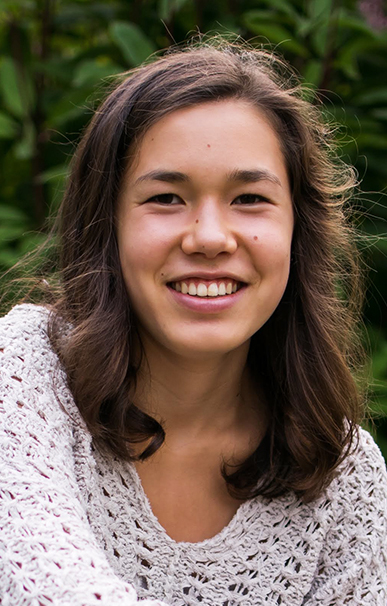 PROJECT
PROJECTMolecular Biological Investigation of the Marine Nitrogen Cycle
ORGANIZATION / LOCATIONThe Ward Lab, Department of Geosciences, Princeton University - Princeton, New Jersey
MENTOR(S)Bess Ward, William J. Sinclair Professor of Geosciences and the High Meadows Environmental Institute; Samantha Fortin, Postdoctoral Research Associate, Geosciences; Amal Jayakumar, Senior Professional Specialist, Geosciences
SEE PRESENTATIONI researched genes involved in denitrification, nitrogen fixation, nitrate reduction, and nitrite oxidation — nosZ, nifH, nxrB, and narG, respectively — as part of the Ward Lab, which studies nitrogen cycling in oxygen minimum zones (OMZs). I contributed to a project studying nitrogen fixation in OMZs by working to understand the diversity and activity of the microbes involved. I amplified nifH, a gene encoding dinitrogenase reductase, by polymerase chain reaction (PCR) using barcoded primer pairs from DNA and RNA extracted from the eastern tropical North and South Pacific OMZs’ water columns. After amplification, I purified the PCR products using a gel extraction protocol and quantified the clean products. Equal quantities of these products will be pooled and sequenced at the Genomics Core Facility. The resulting sequence data is expected to reveal the identities and relative abundances of the dominant nitrogen-fixing microbes present at different depths in the OMZs’ water columns. This can be correlated with rate data to offer insights into the diversity and activity of prokaryotic nitrogen fixers present in these OMZs. Through this project, I gained valuable microbiology research experience through and I enjoyed learning about the adaptations nitrite oxidizing bacteria possess that allow them to operate in OMZs.
-
Ingemi, India ’24
Molecular Biology
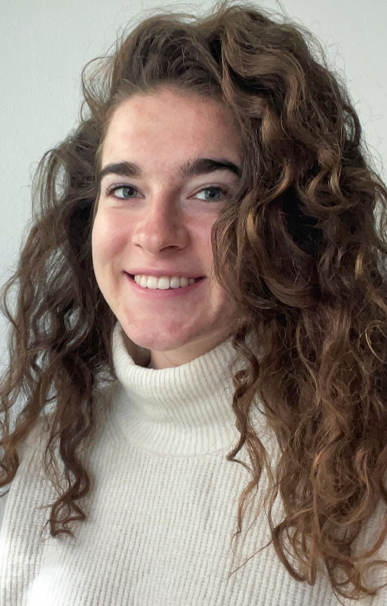 PROJECT
PROJECTFish Ecology From Ear Stones (Otoliths) and Coral Skeletal Material Past and Present
ORGANIZATION / LOCATIONSigman Research Laboratory and The Ward Lab, Department of Geosciences, Princeton University - Princeton, New Jersey
MENTOR(S)Daniel Sigman, Dusenbury Professor of Geological and Geophysical Sciences, Professor of Geosciences; Bess Ward, William J. Sinclair Professor of Geosciences and the High Meadows Environmental Institute; Jessica Lueders-Dumont, Postdoctoral Research Fellow, Geosciences
SEE PRESENTATIONMy goal was to determine the nitrogen isotopic baseline (δN 15 / δN 14 ratio) in the Caribbean and Pacific Ocean across the Miocene, Pliocene, and Modern epochs. I accomplished this by performing nitrogen isotope analysis on otoliths, or ear bones, from myctophids, a family of fish that live in the ocean below the zone where sunlight can reach. Otoliths contain small amounts of protein that serve as great indicators of a fish’s δN 15 / δN 14 ratio. Measuring the nitrogen content of the otoliths involved a 7-day long procedure: I first cleaned the samples using chemical reduction and oxidation to remove nonorganic bound matter, then I oxidized the organic material using persulfate and sodium hydroxide, before pH adjusting and sparging the samples, and finally performed N2O nitrogen isotope ratio spectroscopy. I found it fascinating how so much paleontological history can be garnered by comparing the δN 15 / δN 14 ratio of modern and fossil myctophid otoliths; for example, this method helps to narrow the estimated time frame of the formation of the Isthmus of Panama. Additionally, I gained valuable lab skills, including how to use a mass spectrometer and centrifuge, which are greatly applicable to my future career.
-
Koonin, Spencer ’24
Chemistry
 PROJECT
PROJECTWhat Controls the Biodiversity and Function of Cryptogam Microbiomes?
ORGANIZATION / LOCATIONZhang Lab, Department of Geosciences, Princeton University - Highlands, North Carolina; Princeton, New Jersey; Sherbrooke, Québec, Canada
MENTOR(S)Xinning Zhang, Assistant Professor of Geosciences and the High Meadows Environmental Institute, Romain Darnajoux, Associate Research Scholar, Geosciences
Certificate(s): Environmental Studies
I studied plant life on a smaller scale by investigating mosses, liverworts, and lichens. Known as cryptogams, these small plants provide necessary macronutrients like nitrogen to their surroundings. We focused on a process known as biological nitrogen fixation, where nitrogen gas in the air around us is made available for organisms to use. I collected specimens of moss and lichen in the boreal forests of northern Québec and the Appalachian Mountains of North Carolina. These samples were selected in areas with varying levels of deposited nutrients and pollution from human activity. Back in the lab, I analyzed the samples to investigate how nitrogen and various metals influence biological nitrogen fixation activity and nitrogenase enzymes, with the goal of gaining a better understanding of the nitrogen cycle. This internship introduced me to the extraordinarily complex world of cryptogams, which our world could not exist without. My future can only benefit from the invaluable knowledge I gained, in particular the insight into how to create and address meaningful biogeochemical research questions about the world around me.
* This internship is connected to the HMEI Biodiversity Grand Challenges project, “What Controls the Biodiversity and Function of Cryptogram Microbiomes.”
-
Malik, Saumya ’24
Computer Science
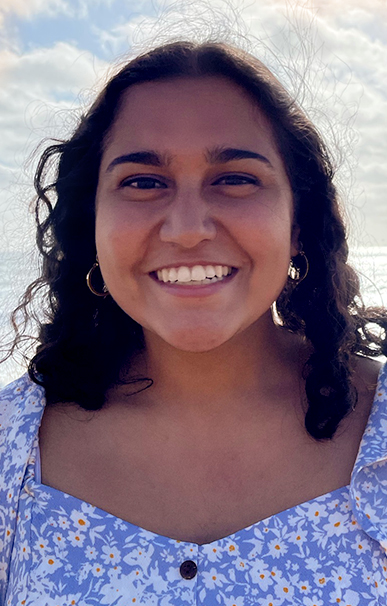 PROJECT
PROJECTCan We Predict Primary Production in the Ocean?
ORGANIZATION / LOCATIONDeutsch Research Group, Department of Geosciences, Princeton University - Princeton, New Jersey
MENTOR(S)Curtis Deutsch, Professor of Geosciences and the High Meadows Environmental Institute; Graeme MacGilchrist, Postdoctoral Research Associate, Program in Atmospheric and Oceanic Sciences
SEE PRESENTATIONMy project aimed to quantify the predictability of multiple biogeochemical drivers of the ocean ecosystem. One driver that I focused on is net primary production, which is the amount of biomass or carbon produced by primary producers per unit area and time; this is estimated by subtracting plant respiratory costs from gross primary productivity or total photosynthesis. Quantifying the predictability of these drivers allows stakeholders like fisheries to have a better understanding of forecasting capabilities and thus improve their management. My work involved analyzing the data from a new set of simulation experiments run on the Geophysical Fluid Dynamics Laboratory’s Earth System Model. I wrote code in the program Python to perform calculations of metrics like prognostic potential predictability (PPP) on 300 years’ worth of simulation data. I produced many plots that visualize the PPP of multiple variables in different ways — taking averages over regions and globally, looking at individual grid points over time, and making animations of global maps over time. By the end of the project, I was able to quantify the predictability of many variables and I gained an understanding of the many interesting ways of looking at predictability, which was a fascinating realization for me.
-
Moosbrugger, Alex ’24
Civil and Environmental Engineering
 PROJECT
PROJECTNature-based Climate Solutions, Blue Carbon
ORGANIZATION / LOCATIONEnvironmental Defense Fund (EDF) - San Francisco, California; Santa Barbara, California
MENTOR(S)Rod Fujita, Senior Scientist and Director, Research and Development, Oceans Program, EDF
SEE PRESENTATIONCertificate(s): Geological Engineering
I worked with the Environmental Defense Fund to research and analyze different methods of seaweed aquaculture. I evaluated these methods based on adherence to carbon-capture criteria, scientific rigor, co-benefits provided, contributions to environmental justice, and near-term feasibility. I contributed to a manuscript (soon to be submitted for publication) on the potential and readiness of seaweed as a major contributor to blue carbon, which is carbon sequestered in marine systems. I also contributed to an internal comparison study to help my team create a roadmap for including seaweed in countries’ blue carbon plans. Additionally, I researched various specific questions relating to seaweed blue carbon, such as possible halocarbon emissions from seaweed, how to incorporate seaweed into cattle feed to reduce enteric methane emissions, and investigated the appetite for seaweed as food. My work involved collaboration and interviewing experts, and I learned how to work well in a research-focused team: asking questions to both learn what I needed to, taking advantage of the expertise of my colleagues, and sharing information in the most helpful and effective ways. Because of this internship, I anticipate that ocean- and nature-based climate solutions will play a large role in my future study and career.
-
Murphy-Braunstein, Celia ’25
Geosciences
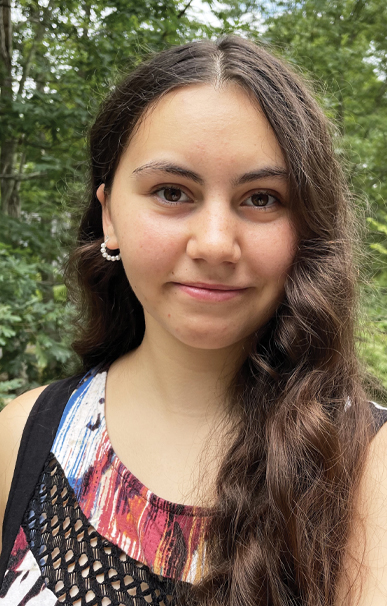 PROJECT
PROJECTGlimpses of Late-Cretaceous Ocean: Reconstructing Marine Environment From Foraminifera
ORGANIZATION / LOCATIONSigman Research Laboratory, Department of Geosciences, Princeton University - Princeton, New Jersey
MENTOR(S)Daniel Sigman, Dusenbury Professor of Geological and Geophysical Sciences, Professor of Geosciences; Crystal Rao, Ph.D. candidate, Geosciences
SEE PRESENTATIONMy internship centered on collecting and processing foraminifera fossils from sediment core samples from the North Atlantic. Foraminifera are single-celled zooplankton that form a calcium carbonate shell. These shells incorporate nutrients from their surroundings, where the isotopic composition of such organic matter acts as a record that can educate us on past marine environments. The central samples in my project are foraminifera from the late Cretaceous period between 82-66 million years ago. I helped to collect foraminera fossils from sediment core samples, washed away clay and fine particles to separate the fossils by different size fractions, and prepared them for analysis on a mass spectrometer. Through this internship, I’ve learned more about the mechanisms within ocean productivity and nutrient cycling, and in particular the nitrogen cycle. I now further value paleoceanography for helping us better understand how ocean environments are associated with climate changes. This internship has provided me with invaluable lab experience and introduced me to the process of independent research, which I hope to pursue in the future within the field of geochemistry.
-
Ripley-Dunlap, Kenya ’24
Ecology and Evolutionary Biology
 PROJECT
PROJECTFish Ecology From Ear Stones (Otoliths) and Coral Skeletal Material Past and Present
ORGANIZATION / LOCATIONSigman Research Laboratory and The Ward Lab, Department of Geosciences, Princeton University - Princeton, New Jersey
MENTOR(S)Daniel Sigman, Dusenbury Professor of Geological and Geophysical Sciences, Professor of Geosciences; Bess Ward, William J. Sinclair Professor of Geosciences and the High Meadows Environmental Institute; Jessica Lueders-Dumont, Postdoctoral Research Fellow, Geosciences
SEE PRESENTATIONCertificate(s): Chinese Language and Culture, Gender and Sexuality Studies
I focused on two topics in marine ecology: cod trophic level changes over the past few centuries and humpback whale migration patterns. Nitrogen isotope contents can relay information about an individual’s place in the food web, with a higher concentration of nitrogen-15 signifying a higher trophic level. To understand changes in cod trophic levels, I analyzed modern and archeological cod otoliths — fish ear bones — using a denitrifier method. This method converts organic bound nitrogen to nitrous oxide using processes including oxidation, pH adjustments, and bacteria sparging, which is quantified by nitrous oxide spectroscopy. I used the same method to analyze coronulid barnacles, which grow on humpback whales. The nitrogen isotopic content of the coronulid at different locations is related to where the humpback whale was at the coronulid’s time of growth, which allows the whale’s migration pattern to be mapped. I am thankful to have had the opportunity to carry out the method from the first step of drilling samples all the way to the last step of spectroscopy data retrieval. Working with so many amazing people and understanding the interconnectedness of research has inspired me to seek out more environmental research opportunities in the future.
-
Yang, Emily ’25
Undeclared
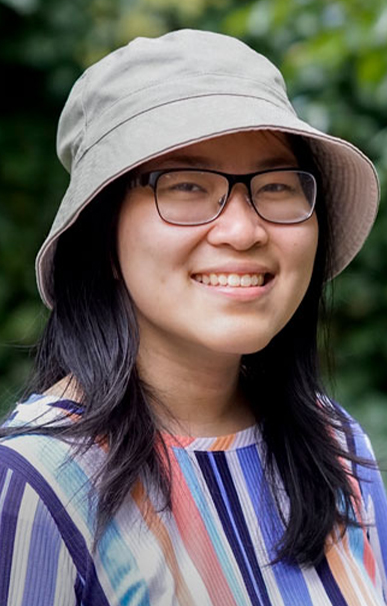 PROJECT
PROJECTThe Wonderfully Diverse World of Cryptogams
ORGANIZATION / LOCATIONZhang Lab, Department of Geosciences, Princeton University - Highlands, North Carolina; Princeton, New Jersey; Sherbrooke, Québec, Canada
MENTOR(S)Xinning Zhang, Assistant Professor of Geosciences and the High Meadows Environmental Institute, Romain Darnajoux, Associate Research Scholar, Geosciences
I studied the effects of different environmental factors on the diversity and function of lichens, mosses, and liverworts. My project involved developing an artistic representation of the research our group was doing, including recording footage and field recordings of our travels to the boreal forest in Quebec and the Appalachian Mountains in North Carolina, and creating a proposal for a booklet introducing environmental microbes to elementary grade students. Through this internship, I developed skills in multimedia communication and science outreach while gaining further perspectives on environmental research in biogeochemistry, which will be useful as I move forward in my undergraduate studies and future work.
* This internship is connected to the HMEI Biodiversity Grand Challenges project, “What Controls the Biodiversity and Function of Cryptogram Microbiomes.”
- Extreme Weather and Impacts
-
Ban, David ’24
Geosciences
 PROJECT
PROJECTThe Climate Footprint on Sea Surface Temperatures and Tropical Cyclones
ORGANIZATION / LOCATIONClimate Central - Princeton, New Jersey
MENTOR(S)Andrew Pershing, Director of Climate Science, Climate Central; Daniel Gilford, Climate Scientist, Climate Central
SEE PRESENTATIONI studied the influence of climate change on Atlantic Ocean sea surface temperature (SST) and its relation to tropical cyclones. Warm water is a key factor for tropical cyclones, and the impact of warmer SSTs on cyclones is a significant topic in climate science and meteorology. I aimed to better quantify global warming’s footprint on SST and to highlight this footprint for cyclones. Climate Central created a Climate Shift Index (CSI) scale that compares the likelihood of a given land temperature in the current climate and in a warming-free climate. I used the program Python to apply the underlying method of the CSI project to SSTs to obtain climate factor (CF) values, which measure the change in probability of a certain SST at a location and time. Then, I used tropical cyclone data to obtain CF values along a storm’s track at the corresponding time and location to find relationships between the storms and the CF. I gained experience with Python and learned to analyse large meteorological datasets. I always wanted a future in severe weather research, but never thought that I would engage with climate issues. I now have an appreciation for how intertwined climate science and meteorology are.
-
Boyd, Bryan ’24
Civil and Environmental Engineering
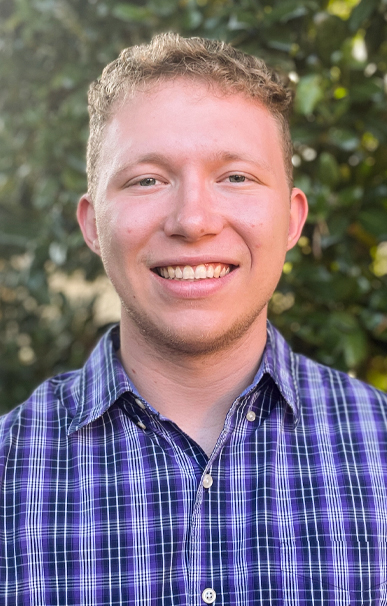 PROJECT
PROJECTExtreme Wind Effects on Kinetic Umbrellas
ORGANIZATION / LOCATIONCreative and Resilient Urban Engineering (CRUE) Research Group and Structural Health Monitoring (SHM) Research Group, Department of Civil and Environmental Engineering, Princeton University - Princeton, New Jersey
MENTOR(S)Maria Garlock, Professor of Civil and Environmental Engineering; Branko Glisic, Professor of Civil and Environmental Engineering
SEE PRESENTATIONI studied kinetic umbrellas: a new form of adaptable “aquatecture” that is being developed to help mitigate damage to coastal towns during hurricanes and other extreme weather events. These umbrellas provide shade and shelter from rain while undeployed, but when deployed they form a makeshift wall that prevents large waves from flooding the shoreline. The first part of my research involved building a wind tunnel to analyze the effects of extreme winds on models of the umbrellas. The second part of my research focused on creating a prototype umbrella that will be placed in the Princeton Garden Project. This involved modeling the umbrella using finite-element software known as SAP2000, calculating pressure values for varying precipitation and wind load cases, and analyzing stress and deformation results. These results allowed us to gauge the model’s feasibility and to create a layout of where sensors should be placed on the model. I learned how to read the American Society of Civil Engineers’ codes, use structural engineering software to model geometries and loadings, and apply construction methods. This experience has both expanded my knowledge in structural engineering and fueled my passion for developing natural disaster resilient infrastructure.
-
Buchovecky, Ben ’23
Geosciences
 PROJECT
PROJECTImpacts of High-latitude Land-Climate Interactions on Arctic Climate Change
ORGANIZATION / LOCATIONDepartment of Atmospheric Sciences, University of Washington - Seattle, Washington
MENTOR(S)Kyle Armour, Associate Professor of Atmospheric Sciences and Oceanography, University of Washington; Abigail Swann, Associate Professor of Atmospheric Sciences and Biology, University of Washington; Lily Hahn, Ph.D. candidate, University of Washington; Claire Zarakas, Ph.D. candidate, University of Washington
SEE PRESENTATIONI studied how the plant response to increasing CO2 impacts Arctic warming via heat transport. I did this by analyzing the output of six climate models from the Coupled Model Intercomparison Project (phase 6). As CO2 concentrations increase, plants respond via multiple physiological changes that can warm land surface temperatures. Climate models simulate plants to varying degrees of complexity, but their impact on global warming has remained unclear. My team and I first analyzed spatial maps and histograms, from which we found that the Arctic warming contribution driven by plant physiology was significant and distinct from natural variability. We then calculated atmospheric and implied oceanic heat transports into the Arctic from surface and top-of-atmosphere heat fluxes. From this analysis, we found that there is a multi-model mean increase in northward heat transport, but significant inter-model spread prevents a clear conclusion and necessitates further analysis. This internship provided me valuable experience in the fields of atmospheric science and climate dynamics and taught me new analysis techniques in the programs Python and NCL that are readily applicable in other research contexts. Working closely with my mentors on this project reinforced my interest in pursuing a research career in climate science.
-
Burns, Madeleine ’24
Civil and Environmental Engineering
 PROJECT
PROJECTImpacts of High-latitude Land-Climate Interactions on Arctic Climate Change
ORGANIZATION / LOCATIONDepartment of Atmospheric Sciences, University of Washington - Seattle, Washington
MENTOR(S)Kyle Armour, Associate Professor of Atmospheric Sciences and Oceanography, University of Washington; Abigail Swann, Associate Professor of Atmospheric Sciences and Biology, University of Washington; Lily Hahn, Ph.D. candidate, University of Washington; Claire Zarakas, Ph.D. candidate, University of Washington
SEE PRESENTATIONCertificate(s): Applications of Computing
I analyzed how plant responses to increased CO2 concentrations impact polar amplification, the observed pattern that warming occurs at a faster rate at northern latitudes. Because plant reactions to increased CO2 concentrations have not been thoroughly studied, narrowing uncertainty in this area will enable more accurate predictions of future warming. I focused on the albedo feedback response, in which a decrease in surface reflectiveness (for instance, a reduction in snow cover) results in an increase in absorbed heat, contributing to an increase in global temperatures. I used Earth system models from the Coupled Model Intercomparison Project to isolate plant physiological changes due to increased CO2 concentrations. Then, I quantified the physiologically driven albedo feedback contributions and analyzed the contributing mechanisms. This project provided a valuable opportunity to expand my data analysis and visualization skills while working with large sets of climate model data. The experience furthered my interest in climate modeling and instilled a curiosity about atmospheric and geological sciences, leaving me inspired to pursue these subjects further at Princeton.
-
Crnkovic-Rubsamen, Laeo ’24
Geosciences
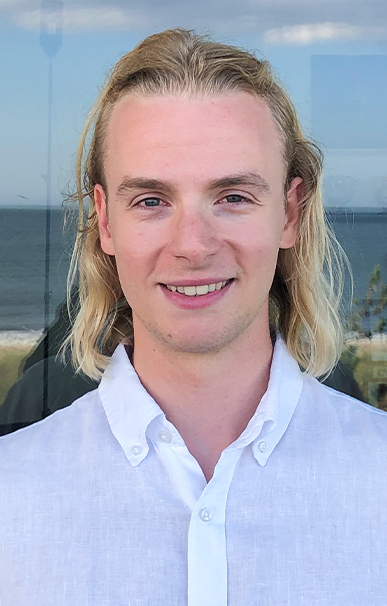 PROJECT
PROJECTModeling Interacting Tipping Elements in the Earth System
ORGANIZATION / LOCATIONEarth System Resilience Group, Potsdam Institute for Climate Impact Research (PIK) - Potsdam, Germany
MENTOR(S)Jonathan Donges, Visiting Research Collaborator, High Meadows Environmental Institute, Princeton University, and FutureLab Co-Leader and Working Group Leader, PIK; Niklas Kitzmann, Ph.D. candidate, PIK; Ann Kristin Klose, Ph.D. candidate, PIK; Nico Wunderling, Ph.D. candidate, PIK
SEE PRESENTATIONCertificate(s): Applications of Computing, Statistics and Machine Learning
I studied the effects of early warning signals on human investment in clean energy. My research involved coupling a model of the natural system with a social model. The social model describes human investment in clean energy based on the perceived economic damage of current CO2 levels and the social acceptance of clean energy investment. The natural system model consisted of tipping elements, i.e., elements that could potentially be pushed into a different state by rising global temperatures or interactions with each other. I focused on four tipping elements: the Greenland ice sheet, Amazon rainforest, West Antarctic ice sheet, and the Atlantic Meridional Overturning Circulation (AMOC). The tipped states are a melted state for the ice sheets, a stalled state for AMOC, or a large scale die-off for the Amazon, and there are discernable early warning signals for each. I used these warning signals to inform the social acceptance of investing in clean energy and thus create a more robust model of human interaction with the natural system. I gained invaluable experience in developing models and researching climate systems and am inspired to continue researching the rich field of human interaction with the climate system during the Anthropocene.
-
Jacobs, Ruby ’24
Civil and Environmental Engineering
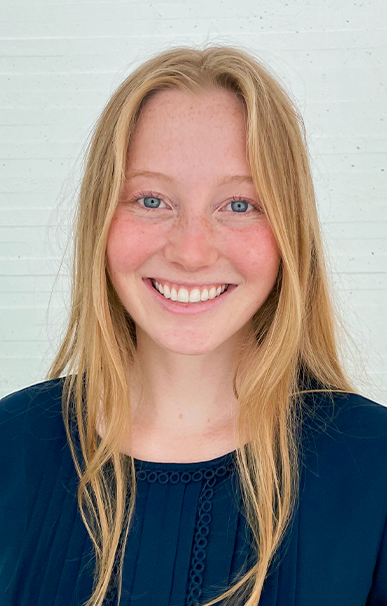 PROJECT
PROJECTExtreme Wind Effects on Kinetic Umbrellas
ORGANIZATION / LOCATIONCreative and Resilient Urban Engineering (CRUE) Research Group and Structural Health Monitoring (SHM) Research Group, Department of Civil and Environmental Engineering, Princeton University - Princeton, New Jersey
MENTOR(S)Maria Garlock, Professor of Civil and Environmental Engineering; Branko Glisic, Professor of Civil and Environmental Engineering
SEE PRESENTATIONI studied the structural behavior of kinetic umbrellas, which are four-sided concrete hyperbolic paraboloid shells. Kinetic umbrellas are an innovative flood barrier structure that can defend against nearshore hazards; when lined by the shore and tilted to a deployed position, they can combat the threat of flooding during severe weather. I analyzed the effects of various wind and gravity load combinations on the structural behavior of a prototype umbrella to be built in the Princeton Garden Project. We used ASCE 7-16 design codes to determine a value for static surface pressure due to wind, rain, and snow based on the risk category, geographic location, and geometry of the umbrella. Then, we used SAP2000 to build finite element models of the umbrella in its undeployed and deployed positions. We used these models to analyze stresses and deformations in the umbrella under loading, which provides insight into the design’s safety and feasibility. Finally, we designed layouts for strain and wind pressure sensors that will collect data on the umbrella once built. I gained valuable experience in finite element modeling, the structural engineering design process, and construction methods. This internship has made me even more excited to continue my studies in structural engineering.
-
Kinch, Shelby ’23
Anthropology
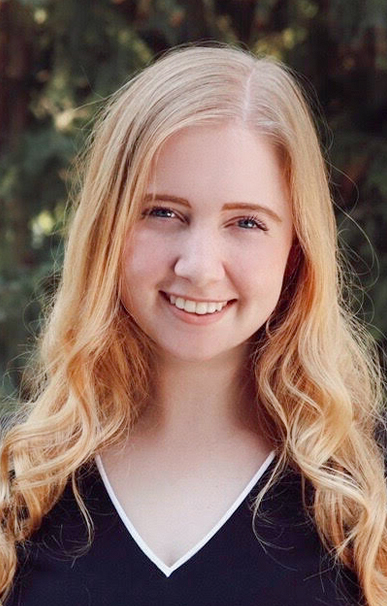 PROJECT
PROJECTHigh Water Mark: Rain Gardens as a Tool for Flood Mitigation
ORGANIZATION / LOCATIONVizE Lab for Ethnographic Data Visualization, Department of Anthropology, Princeton University - Princeton, New Jersey; Trenton, New Jersey
MENTOR(S)Jeffrey Himpele, Director, VizE Lab for Ethnographic Data Visualization and Lecturer in Anthropology; Carolyn Rouse, Ritter Professor of Anthropology
SEE PRESENTATIONCertificate(s): Linguistics
My project focused on the use of rain gardens as tools for mitigating floods and improving water quality. Rain gardens are an example of green infrastructure, a type of infrastructure that utilizes natural processes to manage flooding. The benefits of rain gardens include flood mitigation, the restoration of native plant ecosystems, and improvements to water quality. However, many resources on rain gardens are difficult to access and are often highly technical. My goal was to learn more about rain gardens and the specific resources available related to them, and to then translate this knowledge into a deliverable guide for local residents. I researched local plants and compiled a list of local experts who had worked on rain gardens previously, who I then interviewed. I used this information to design a Princeton rain garden guide, poster, and website to market information on rain gardens in an accessible way. I gained experience with ethnographic research, filmmaking, design, and data visualization. The challenge of this project was to market environmental concepts in a way that was both engaging and widely accessible. This project has inspired me to look into careers in environmental marketing that explore the intersection of public affairs, communications, and environmental science.
-
Kohler, Wiley ’25
Mathematics
 PROJECT
PROJECTPredicting Antarctic Melt Rates Using Physics-informed Deep Learning
ORGANIZATION / LOCATIONLai Group, Department of Geosciences, Princeton University - Princeton, New Jersey
MENTOR(S)Ching-Yao Lai, Assistant Professor of Geosciences
SEE PRESENTATIONI studied the behavior of Antarctic ice shelves using various machine learning techniques. Understanding the role of ice shelves, the floating outlets of ice sheets into the ocean, is key to understanding global sea level rise as a result of climate change. In Antarctica in particular, ice shelves form an important buffer that stabilizes the continent’s substantial ice mass. However, many of their attributes are difficult to measure accurately, which makes predictions of future sea level change more difficult. I used neural networks to develop less noisy, continuous, and infinitely differentiable models of ice velocity, thickness, and other factors, which can be used to better understand and predict the future behavior of ice shelves. Beyond actually developing this model, I studied the properties of some of these neural networks and the effectiveness of various machine learning techniques in the context of fluid dynamics problems. I learned a lot about implementing machine learning algorithms in the context of climate science and had the opportunity to independently explore new questions. As a result of these experiences, I plan to continue to pursue coursework and independent work at the intersection of computer and climate sciences.
-
Lee, Kyung Eun ’25
Undeclared
 PROJECT
PROJECTHigh Water Mark: Rain Gardens as a Tool for Flood Mitigation
ORGANIZATION / LOCATIONVizE Lab for Ethnographic Data Visualization, Department of Anthropology, Princeton University - Princeton, New Jersey; Trenton, New Jersey
MENTOR(S)Jeffrey Himpele, Director, VizE Lab for Ethnographic Data Visualization and Lecturer in Anthropology; Carolyn Rouse, Ritter Professor of Anthropology
SEE PRESENTATIONHigh Water Mark is an ongoing research project dedicated to studying flooding issues in Princeton and Trenton, New Jersey. I conducted ethnographic interviews with local residents, Princeton affiliates, and local environmental organizations to learn more about the processes and relationships between local policy, environmental science and engineering, urban planning, and communal life as it relates to water. The goal of the project is to learn about residents’ perspectives on matters ranging from rainwater and flooding in their own houses, to local government participation, as well as more general ideas of sustainability, climate change, and the intersectionality of policy and nature. This project aims to provide more accessible education and information on the complexities of environmental science as it pertains to the individual via different methods, including creating rain garden brochures and documentary films to spread awareness. I found talking to local residents and learning about the local community to be extremely important, and a gratifying complement to other, more formal research; it is a grounding experience and motivates me to work harder toward meaningful goals. I look forward to continuing this research in the coming academic year, and hope to also include my experience from this project in my independent work.
-
Melton, Sam ’23
Civil and Environmental Engineering
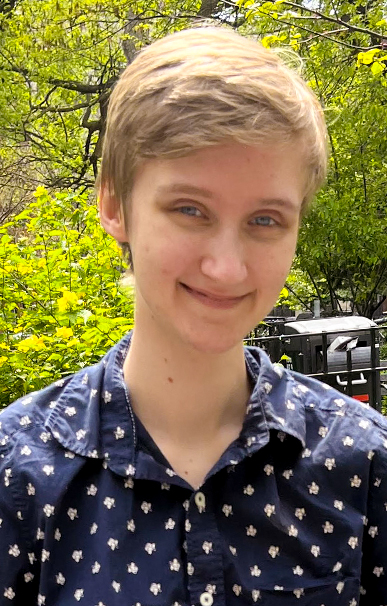 PROJECT
PROJECTGeospatial Data Collection and Mapping
ORGANIZATION / LOCATIONClimate Central - Princeton, New Jersey
MENTOR(S)Jennifer Brady, Manager, Analysis and Production, Climate Central; Andrew Pershing, Director of Climate Science, Climate Central; Kaitlyn Trudeau, Data Analyst, Climate Central
Certificate(s): Urban Studies
I worked with Climate Central’s Climate Matters program to perform data analysis related to urban heat island intensity and how far people in urban areas live from substantial green spaces on nearly 500 cities across the United States. I performed these analyses using ArcGIS Pro, a software program that aids in geospatial analysis and mapmaking. I combined census data and recent land cover data to create maps revealing concentrations of heat or lack of green space in the cities. I also created charts to demonstrate correlations between distance to green space with race and income; these findings may be developed further for a future release from Climate Matters. This work highlighted the environmental inequities present in cities, which will only be worsened by climate change. Through this internship, I was able to develop my geospatial analysis and mapping skills, which I plan to utilize in my senior thesis. Working with Climate Central also gave me the opportunity to conduct data analysis related to environmentalism and urbanism for a nonprofit organization, which I now hope to do in my future career.
-
Toh, Yi Jin ’25
Undeclared
 PROJECT
PROJECTMarine Heat Waves and Their Impact on Ocean Biology
ORGANIZATION / LOCATIONDeutsch Research Group, Department of Geosciences, Princeton University - Princeton, New Jersey
MENTOR(S)Curtis Deutsch, Professor of Geosciences and the High Meadows Environmental Institute; Graeme MacGilchrist, Postdoctoral Research Associate, Program in Atmospheric and Oceanic Sciences; Marion Alberty, Postdoctoral Research Associate, Program in Atmospheric and Oceanic Sciences
SEE PRESENTATIONMarine heat waves are prolonged periods of anomalously warm water that can impact regional climate and ecosystems. These impacts are partially mediated by changes to phytoplankton growth, the base of the oceanic food chain. Existing literature estimates the impact of marine heat waves on phytoplankton growth by averaging phytoplankton responses. However, it could be helpful to observe how phytoplankton responses evolve in conjunction with other biogeochemical processes in the ocean. I used simulation data from the Geophysical Fluid Dynamics Laboratory’s Earth System Model to explore the characteristics of marine heat waves in several regions of interest. Then, I calculated the climatologies for nutrients, phytoplankton, and other variables and investigated how they are impacted by marine heat waves. We found that phytoplankton in the same region can respond differently to marine heat waves depending on factors including season, phytoplankton species, and marine heat wave intensity. Many further questions arose from these results, and I am excited to continue working with my mentors to answer them. Overall, this internship was an inspiring experience for me – it solidified my passion for coding and, as a result, I’ve decided to take more applications-based coding classes and possibly even major in Computer Science.
-
Zelikman, Brendan ’23
Computer Science
 PROJECT
PROJECTReal-time Forecasting System for Hurricane Hazards and Risk
ORGANIZATION / LOCATIONHurricane Hazards and Risk Analysis Group, Department of Civil and Environmental Engineering, Princeton University
MENTOR(S)Ning Lin, Associate Professor of Civil and Environmental Engineering, Princeton University; Christine Blackshaw, Ph.D. candidate, Civil and Environmental Engineering, Princeton University; Avantika Gori, Ph.D. candidate, Civil and Environmental Engineering, Princeton University
SEE PRESENTATIONCertificate(s): Music Performance
I developed a website for predicting hurricane risk in counties across the United States using weather data sourced from the National Hurricane Center. Tropical cyclones pose a significant danger to coastal communities, so creating forecasting systems that support real-time decision-making is crucial for evacuation, recovery, and resilience. My work focused on designing and coding the website from scratch. This process included building a user-friendly layout in the design tool Figma, implementing an interactive county map in React – the free and open-source JavaScript library – and setting up a hosted database on the software cPanel. I researched design philosophy to make the website usable by everybody, and I practiced professional coding etiquette to ensure the project is maintainable in the future. This internship gave me a chance to apply and refine my skills in web development, and it taught me a lot about hurricanes and climate science in general. It also reignited my passion for conservation, and I am inspired to pursue a career in environmental computer science.
-
Zhang, Edward ’24
Civil and Environmental Engineering
 PROJECT
PROJECTA Biologically-based Analysis of Climatic Trends in Marine Heat Waves
ORGANIZATION / LOCATIONDeutsch Research Group, Department of Geosciences, Princeton University - Princeton, New Jersey
MENTOR(S)Curtis Deutsch, Professor of Geosciences and the High Meadows Environmental Institute
SEE PRESENTATIONCertificate(s): Environmental Studies
I investigated how trends in the oxygen levels of subtropical oceans change with increasing temperatures. Increased variance in oxygen levels with increasing temperature was first observed in the shallow waters of the Caribbean. This is a concerning trend as severe increased oxygen variance may profoundly impact the survival of marine species. I investigated trends in oxygen levels along the Australian coastline using ocean datasets from over 20 years. I first extracted and cleaned the data. I then performed a statistical regression analysis, and found six locations that exhibited this same concerning pattern of increasing oxygen variance with increased temperatures. Then, I performed the same analysis on outputs from the Geophysical Fluid Dynamics Laboratory Earth System Model version 4, a climate simulation model. I found it interesting to compare the results from real-world data to model data, and learned that they require different methods of analysis and often produce different results. Through my project, I learned to analyze data using MATLAB and Python, and explored the strengths and limitations of both programs. These skills will be invaluable for my future research projects, and have given me the confidence to pursue research that involves analyzing large amounts of data.
-
Zhang , Jasmine ’24
Computer Science
 PROJECT
PROJECTModeling Interacting Tipping Elements in the Earth System
ORGANIZATION / LOCATIONEarth System Resilience Group, Potsdam Institute for Climate Impact Research (PIK) - Potsdam, Germany
MENTOR(S)Jonathan Donges, Visiting Research Collaborator, High Meadows Environmental Institute, Princeton University, and FutureLab Co-Leader and Working Group Leader, PIK; Niklas Kitzmann, Ph.D. candidate, PIK; Ann Kristin Klose, Ph.D. candidate, PIK; Nico Wunderling, Ph.D. candidate, PIK
SEE PRESENTATIONCertificate(s): Applied and Computational Mathematics, Statistics and Machine Learning
I studied climate tipping elements, elements in our Earth system that can “tip” into different states upon meeting a certain threshold. There are heavy environmental repercussions when an element tips, and it is difficult for it to return to the original state. Examples of tipping elements include the Amazon rainforest and the Atlantic Meridional Overturning Circulation. Tipping elements also interact with each other through different feedback mechanisms. Once an element tips, it could lead to a domino effect, with other elements subsequently tipping. My project involved modeling interacting tipping elements to determine how they affect and are affected by social activism. The tipping elements are modeled by the PyCascades model developed by one of my mentors, Nico Wunderling, and social activism is modeled by an extension of the Granovetter model developed by Marc Wiedermann. I first coded this social model, then coupled the environmental and social models together, such that they influenced each other through time. I coded this coupled model iteratively while continuously brainstorming and updating it to make the coupling more realistic. I learned an incredible amount about the power of developing models and I am inspired to pursue future classes and research in climate modeling.
- Innovation and a New Energy Future
-
Ateyeh, Ahmad ’25
Electrical and Computer Engineering
 PROJECT
PROJECTSmall Clean Fusion Reactors
ORGANIZATION / LOCATIONPrinceton Plasma Physics Laboratory - Princeton, New Jersey
MENTOR(S)Samuel Cohen, Director, Program in Plasma Science and Technology, Princeton Plasma Physics Laboratory
SEE PRESENTATIONI worked with the Princeton Field Reversed Configuration (PFRC) group on an ongoing experiment to construct a small, clean fusion reactor. My specific focus was on the PFRC’s radio frequency (RF) heating system, which is the part of the reactor that allows the plasma to reach a temperature sufficient to generate power. In the current form of the PFRC, the power efficiency of the RF system is very low. I helped construct a model of the RF system on a circuit analysis software known as Pspice, and then used this model’s output to provide insights on how to increase the system’s power efficiency. Throughout this project, I was able to gain experience with software and languages that are ubiquitous in the electrical engineering field, such as Pspice and MATLAB. I also gained hands-on experience in a laboratory setting. Overall, I loved that this project expanded my knowledge of the possibilities of renewable energy, and I am looking forward to expanding my horizon even more in future endeavors.
-
Boniface, Kennedy ’24
Chemical and Biological Engineering
 PROJECT
PROJECTIncreasing Foreign Renewable Investments: Bilateral Financing for Power Generation Technologies in Africa
ORGANIZATION / LOCATIONCenter for Policy Research on Energy and the Environment (C-PREE), School of Public and International Affairs, Princeton University - Princeton, New Jersey
MENTOR(S)Denise Mauzerall, Professor of Civil and Environmental Engineering and Public and International Affairs; Jing Liang, Postdoctoral Research Associate, School of Public and International Affairs
SEE PRESENTATIONAfrica is home to 17% of the world’s population but only accounts for 4% of global power supply investment. This disproportion, though dire, presents a great opportunity for African countries. Instead of addressing their energy needs through fossil fuels, these countries have the opportunity to leapfrog these energy sources and build clean and sustainable energy systems. Our project focused on increasing Chinese investment into renewable technologies because China has been the biggest financier for the energy sector in Africa for the past 20 years. I examined existing databases and publications to better understand Chinese investment patterns in select African countries. We also contacted and interviewed more than 20 experts from select countries and organizations to flesh out and address the factors affecting the level of renewable energy investment on the continent. Through these interviews, I not only gained a richer appreciation for the potential of renewable technologies in developing economies, I also learned more about academic communication. Moreover, working with visualization tools and handling large quantitative datasets greatly improved my data analysis and presentation skills. I plan to continue researching and taking courses about renewable energy policies and financing, in addition to my current engineering interests in renewable technologies.
-
Chen, Hyaline ’25
Undeclared
 PROJECT
PROJECTSmall Clean Fusion Reactors
ORGANIZATION / LOCATIONPrinceton Plasma Physics Laboratory - Princeton, New Jersey
MENTOR(S)Samuel Cohen, Director, Program in Plasma Science and Technology, Princeton Plasma Physics Laboratory
SEE PRESENTATIONOur research aimed to develop a compact fusion reactor that produces less contamination in the experiments happening in the Princeton Field Reversed Configurations (PFRC) program. I primarily ran simulations of single ion trajectories inside the PFRC magnetic field and observed the heating and confinement of the particles when started with different initial conditions. I then sought to explain the observed behaviors using more analytical models.
-
Fontani Herreros, Daria ’24
Civil and Environmental Engineering
 PROJECT
PROJECTCultivation of Sulfolobus acidocaldarius to Enhance Olivine Dissolution Rates in Bio-Cement
ORGANIZATION / LOCATIONSustainable Cements Group, Department of Civil and Environmental Engineering and the Andlinger Center for Energy and the Environment, Princeton University - Princeton, New Jersey
MENTOR(S)Claire White, Associate Professor of Civil and Environmental Engineering and the Andlinger Center for Energy and the Environment
SEE PRESENTATIONCertificate(s): Applications of Computing, Architecture and Engineering
The production of cement contributes to 7% of anthropogenic carbon emissions and thus requires immediate attention in the face of our global climate crisis. I worked with the Sustainable Cements Group to begin the process of creating a bio-cement. This bio-cement uses bacteria to enhance a reaction that turns olivine, a magnesium-rich silicate mineral abundant on the Earth’s crust, into a magnesium carbonate cement substitute. I studied the growth of a species of thermoacidophilic archaea, Sulfolobus acidocaldarius, to learn about its sulfur-oxidizing capabilities and the extent to which it could be used in this novel approach to cement production. My work consisted of inoculating and monitoring the bacteria’s growth in different media by taking optical density readings at 600nm. These meaurements inform on the extent to which the bacteria are able to oxidize elemental sulfur without added carbon sources. My research helped the group confirm that Sulfolobus acidocaldarius is not an appropriate bacteria for this research, and the next steps for the group involve testing a different species, Acidianus brierleyi. This experience taught me much about the breadth of civil engineering and the innovative ways different fields of study can come together to produce solutions to the world’s most pressing issues.
-
Jung, Seyi ’24
Chemical and Biological Engineering
 PROJECT
PROJECTLight-controlled Selective Protein Degradation
ORGANIZATION / LOCATIONAvalos Group, Department of Chemical and Biological Engineering and the Andlinger Center for Energy and the Environment, Princeton University - Princeton, New Jersey
MENTOR(S)José Avalos, Associate Professor of Chemical and Biological Engineering and the Andlinger Center for Energy and the Environment; Allison Tang, Ph.D. candidate, Chemical and Biological Engineering
SEE PRESENTATIONThe Avalos Group aims to develop more efficient methods to produce biofuel such as isobutanol from yeast. I helped to develop and test optogenetic circuits, which can be used to control genetic and metabolic pathways via light-controlled protein degradation. I implemented and tested the pairing of protein to degron, a portion of a protein that is important in regulation of protein degradation rates, using the ALFA nanobody system for selective protein degradation. The system was later placed under light-controlled promoters. I also analyzed and organized the experimental results that tested the effectiveness of the ALFA nanobody system and the optogenetic circuits. I gained hands-on experience in yeast engineering, cloning, plasmid construction, and data analysis. It was a great pleasure to design and successfully construct plasmids, which are genetic structures in a cell that replicate independently of the chromosomes. I also enjoyed theorizing about the possible applications of optogenetic circuits for not only isobutanol production, but also for multiple other metabolic pathways in yeast. This has been a great learning experience, and I plan to continue exploring the kinetics and application of optogenetic circuits throughout my junior independent research project.
-
Kehoe, Brendan ’24
Electrical and Computer Engineering
 PROJECT
PROJECTThe Materials Science of Sustainable Cements
ORGANIZATION / LOCATIONSustainable Cements Group, Department of Civil and Environmental Engineering and the Andlinger Center for Energy and the Environment, Princeton University - Princeton, New Jersey
MENTOR(S)Claire White, Associate Professor of Civil and Environmental Engineering and the Andlinger Center for Energy and the Environment; Jordan Hamel, Ph.D. candidate, Civil and Environmental Engineering
SEE PRESENTATIONI had the pleasure of working on two distinct projects. The first was to mathematically modify hundreds of datasets collected by neutron beams at Oak Ridge National Laboratory. I used background subtraction, which took a “background function” of the data, and Fourier transformation to put the data in a form that can provide information about the properties of materials measured. My second project was to develop a process to make a mineral powder known as forsterite. Forsterite is commercially available with some percentage of iron, but other researchers in my group required pure forsterite to determine what effect, if any, the iron has. This internship allowed me to engage in independent research for the first time, and gave me a much better appreciation for the many steps taken and setbacks faced by scientific researchers before they come to publishable conclusions. My dual projects, one more hands-on and one done entirely on a computer, have not only furthered my interest in doing hands-on research, but helped me understand the important role that computational work and computer programs can play. I’m also inspired to continue engaging in environmental research.
-
Kramer, Sijbren ’24
Chemical and Biological Engineering
 PROJECT
PROJECTCO2 Capture Materials
ORGANIZATION / LOCATIONSustainable Cements Group, Department of Civil and Environmental Engineering and the Andlinger Center for Energy and the Environment, Princeton University - Princeton, New Jersey
MENTOR(S)Claire White, Associate Professor of Civil and Environmental Engineering and the Andlinger Center for Energy and the Environment; Sunxiang (Sean) Zheng, Postdoctoral Research Associate, Andlinger Center for Energy and the Environment
SEE PRESENTATIONMy work centered around the analysis of calcium-based layered double hydroxides (LDHs) as materials for carbon capture. LDHs are composed of layers of positively charged metal hydroxide sheets balanced out by interlayer anions and water. I specifically focused on how exchanging these anions affects the carbon capture and regeneration process of the material. I worked to optimize the synthesis of the material, refined the anion exchange process, and analyzed the carbon capture process of various anions. My work helped isolate the most effective anions and direct future research toward an exploration of the importance of water absorption in the choice of anion. I’ve learned various analytical tools that I can employ in future materials research. Furthermore, I’ve learned the importance of thorough technical understanding combined with creative problem solving to advance scientific frontiers. This project has helped me realize that I want to pursue further sustainable scientific research.
-
Lemay, Amélie ’24
Civil and Environmental Engineering
 PROJECT
PROJECTEnergy Efficient Photocatalysis
ORGANIZATION / LOCATIONRandLab, Department of Electrical and Computer Engineering, Princeton University - Princeton, New Jersey
MENTOR(S)Barry Rand, Associate Professor of Electrical and Computer Engineering and the Andlinger Center for Energy and the Environment; Jesse Wisch, Ph.D. candidate, Electrical and Computer Engineering
SEE PRESENTATIONCertificate(s): Sustainable Energy
In photoredox catalysis, visible light is used to power chemical reactions that were traditionally powered by more energy-intensive methods, like shining ultraviolet light or heating to high temperatures. The RandLab and their collaborators have been working on a novel photoreactor design that relies on near-field energy transfer. This design has the potential to further improve the energy efficiency of processes powered by photoredox catalysis. My role was to aid in optimizing the component of this photoreactor that produces the light-emitting excitons: the organic light-emitting diode (OLED). Our aim was to make the brightest OLED possible. We used a variety of organic semiconducting materials and optimized the thicknesses of different layers. After each optimization, we measured the device’s current, efficiency, and stability. I learned to operate the spin coater, thermal evaporator, and characterization equipment used in the fabrication and performance evaluation of OLEDs. Our final structure was 60% brighter and 40% more efficient than the initial one, which represents a significant improvement to the near-field photoreactor.
-
Lunsford, Caleb ’23
Civil and Environmental Engineering
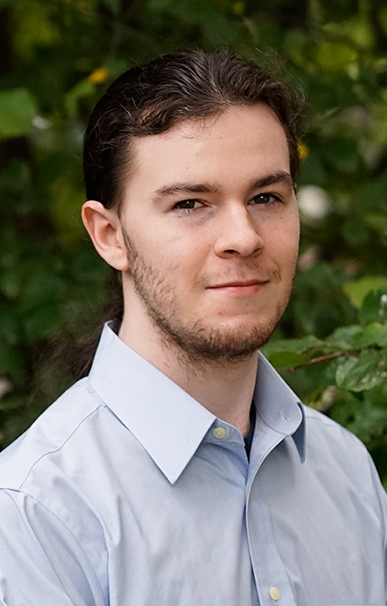 PROJECT
PROJECTComposition and Properties of Alkali-activated Metakaolin
ORGANIZATION / LOCATIONSustainable Cements Group, Department of Civil and Environmental Engineering and the Andlinger Center for Energy and the Environment, Princeton University - Princeton, New Jersey
MENTOR(S)Claire White, Associate Professor of Civil and Environmental Engineering and the Andlinger Center for Energy and the Environment
SEE PRESENTATIONCertificate(s): Architecture and Engineering
Currently, the production and use of concrete and cement accounts for 8% of yearly global carbon emissions. My internship studied alkali-activated metakaolin (AAMK), a potential replacement for traditional ordinary portland cement (OPC). The physical properties and emissions of a batch of AAMK depend greatly on the mix of chemicals used to make the alkaline solution that activates the metakaolin clay. I compiled previous research data and analyzed the AAMK cement mixes that were tested. By comparing the recorded compressive strength with known carbon emissions, I was able to identify potential cements that would have similar or better performance than OPC. With this information, I selected three potential alkali solutions and created cylindrical samples for testing in the lab. While all samples produced less emissions than an OPC sample, the AAMK cement paste was much stickier. This made it difficult to remove all of the air bubbles before the cylinders fully set. These air voids acted as flaws, reducing the compressive strength of the cement below the preferred level. Further tests and adjustments need to be performed to adjust the AAMK cement mixes to remove all air voids before they will be suitable for use.
-
Memon, Leena ’25
Operations Research and Financial Engineering
 PROJECT
PROJECTIncreasing Chinese Renewable-energy Finance in Africa
ORGANIZATION / LOCATIONCenter for Policy Research on Energy and the Environment (C-PREE), School of Public and International Affairs, Princeton University - Princeton, New Jersey
MENTOR(S)Denise Mauzerall, Professor of Civil and Environmental Engineering and Public and International Affairs; Jing Liang, Postdoctoral Research Associate, School of Public and International Affairs
SEE PRESENTATIONCertificate(s): Applications of Computing, Technology and Society
I studied the drivers and barriers for Chinese finance to renewable energy projects in Africa in collaboration with C-PREE at Princeton. We reviewed thousands of data entries from various databases to examine loans and investments from Chinese policy banks and foreign direct investment. After identifying gaps and limitations in current research, we interviewed 24 experts from the United States, China, and multiple African nations. We compiled a report on the state of renewable energy and electrification in specific African countries and connected information from these interviews to existing literature. Our findings helped identify factors that push and pull finance for renewable energy in Africa. Through this experience, I improved my data analysis and visualization skills by using the programs Python, R, and Tableau to create diagrams from databases. I also refined my communication and qualitative analysis skills by contacting experts, conducting interviews, and summarizing findings. I hope to continue learning and working in this intersection of technology, public policy, and finance to advance renewable energy technology and access to electricity.
-
Singh, Dave ’24
Mechanical and Aerospace Engineering
 PROJECT
PROJECTCalibrating the Charge-exchange Ion Energy Analyzer for the PFRC-2
ORGANIZATION / LOCATIONPrinceton Plasma Physics Laboratory - Princeton, New Jersey
MENTOR(S)Samuel Cohen, Director, Program in Plasma Science and Technology, Princeton Plasma Physics Laboratory
SEE PRESENTATIONCertificate(s): Applications of Computing, Engineering Physics, Robotics and Intelligent Systems
I helped calibrate the charge-exchange stripping-cell ion energy analyzer (SC-IEA) designed for the Princeton Field Reverse Configuration 2 (PFRC-2) plasma device. Plasma diagnostics that measure the energy distribution of confined ions enable a better understanding of the working principles of the PFRC-2. However, since ions experience forces during their exit from the plasma, they lose crucial information of their original state. The SC-IEA foregoes this problem by first neutralizing ions and then analyzing the energy of these neutrals. To calibrate SC-IEA, each component must be individually tested to ensure every step of the diagnostic is well understood. I employed image analysis to measure the profile of the curved-plate energy analyzer and created a computer-aided design model to micron-level accuracy. Then, I applied the finite element method to simulate the electrostatic field and programmed a single particle simulation for the path of ions through the energy analyzer. After automating the code to sweep the possible ion energies, I compiled predictions for the output of the energy analyzer. Experimentally, I used a calibrated ion gun to test sample input conditions for the SC-IEA. The unique experience provided me with practical insights into how physics research and engineering projects complement each other.
-
Zheng, Callie ’24
Chemical and Biological Engineering
 PROJECT
PROJECTInvestigating Structure-Property Relations in Next-generation Chemically Recyclable Polyolefins
ORGANIZATION / LOCATIONDavidson Research Group, Department of Chemical and Biological Engineering, Princeton University - Princeton, New Jersey
MENTOR(S)Emily Davidson, Assistant Professor of Chemical and Biological Engineering; Shawn Maguire, Postdoctoral Research Associate, Chemical and Biological Engineering
SEE PRESENTATIONCertificate(s): Materials Science and Engineering, Sustainable Energy
I focused on understanding the material properties of a chemically recyclable polymer —poly(oligocyclobutane) (pDVOCB). Most chemically recyclable polymers require specialized synthesis methods and have inferior material properties compared to everyday plastics. In contrast, pDVOCB is derived from butadiene, which is a cheap, abundant commodity hydrocarbon feedstock, as well as a common hazardous emission from motor vehicles. My research focused on analyzing the fundamental material properties of pDVOCB and understanding its stability under harsh environmental conditions (e.g., elevated temperatures, high humidity, etc.). A deeper understanding of the material characteristics of pDVOCB should lead to the determination of appropriate processing conditions, which would allow for commercial applications with the added benefit of chemical recyclability. During this internship, I gained valuable experimental skills and insight into academic research and learned and utilized a multitude of complementary experimental techniques, including polarized optical microscopy, differential scanning calorimetry, dynamic mechanical analysis, and thermogravimetric analysis. This positive experience has impelled me to continue research in the form of a junior independent research project, and to look for further opportunities in materials science with the ultimate goal of helping to create a more sustainable world.
- Sustainable Food Systems
-
Blake, Kalena ’24
School of Public and International Affairs



 PROJECT
PROJECTReducing Livestock Methane Emissions: A look at the Low Carbon Fuel Standard
ORGANIZATION / LOCATIONEnvironmental Defense Fund (EDF)
MENTOR(S)Joe Rudek, Lead Senior Scientist, EDF
SEE PRESENTATIONCertificate(s): Environmental Studies
I researched California’s Low Carbon Fuel Standard (LCFS), which is a state policy designed to accelerate the transition to using fuels with lower carbon intensity in California’s transportation fuel pool. I studied the scientific literature on harnessing methane emissions and biofuels for energy. In addition, I researched the interaction between state and federal policies designed to reduce greenhouse gas emissions such as the LCFS and the Renewable Fuel Standard. Finally, I examined the shortcomings of these policies and the validity of criticisms that have been leveraged by various stakeholders. My research provided insight into the future of the LCFS and fuel standards more broadly. This internship provided an invaluable experience to work with some of the foremost scientists, environmental lawyers, and climate activists in the field. The interdisciplinary nature of EDF’s approach to environmental issues introduced me to knowledge and skills that I will be able to apply throughout my studies at Princeton and beyond.
-
Chang, David ’25
Electrical and Computer Engineering
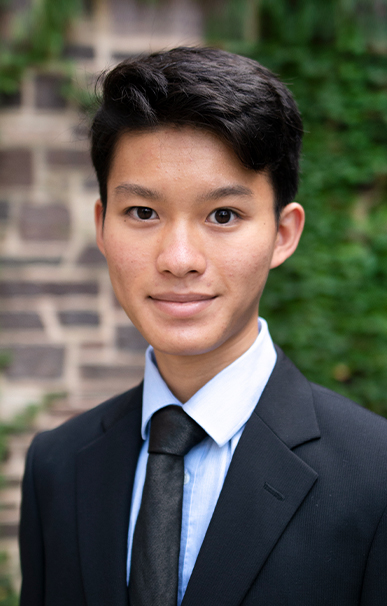 PROJECT
PROJECTFarm Project Field Assistant
ORGANIZATION / LOCATIONRubenstein Lab, Department of Ecology and Evolutionary Biology, Princeton University - Princeton, New Jersey
MENTOR(S)Daniel Rubenstein, Class of 1877 Professor of Zoology, Professor of Ecology and Evolutionary Biology; Gina Talt, Food Systems Project Specialist, Office of Sustainability
SEE PRESENTATIONCertificate(s): Applied and Computational Mathematics
I studied how to optimize operations and agricultural output across five farms and an urban garden in New Jersey. Alongside three other interns, I collected daily crop measurements for various vegetables, monitored bug populations through insect traps, took soil samples, and measured plant height and diversity on a livestock farm. We took a high-tech approach to our agricultural research by deploying Arable sensors containing multi-band spectrometers, infrared thermometers, and other technology. I helped analyze these data to assess growing conditions, crop coverage, and plant health. I also had the opportunity to fly a drone to take images of several grazing pastures, which I then analyzed using satellite data and geographic information system software QGIS and Sentera FieldAgent. These analyses provided information on the performance of pastures under different applied treatments. My most memorable – and favorite – part of the summer was collecting a dozen cow fecal samples to investigate their stomach microbiomes following their grazing of each pasture. This internship has inspired me to continue working toward a better and more sustainable world through research. I hope to continue applying high-tech and innovative ideas in critical fields of research, even when they may initially sound out of place.
-
Fitzgerald, Lillian ’25
Ecology and Evolutionary Biology
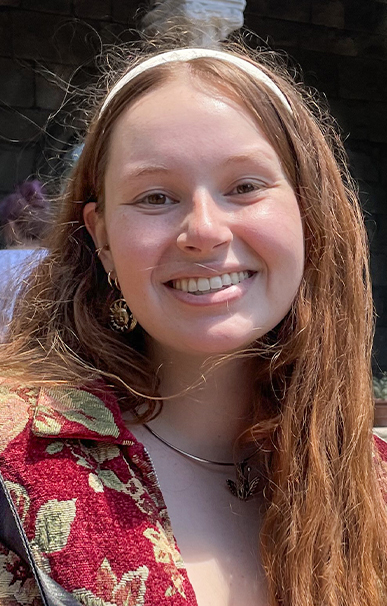 PROJECT
PROJECTFarm Project Field Assistant
ORGANIZATION / LOCATIONRubenstein Lab, Department of Ecology and Evolutionary Biology, Princeton University - Princeton, New Jersey
MENTOR(S)Daniel Rubenstein, Class of 1877 Professor of Zoology, Professor of Ecology and Evolutionary Biology; Gina Talt, Food Systems Project Specialist, Office of Sustainability
SEE PRESENTATIONI investigated agricultural issues within New Jersey farms. My team and I focused on three main projects: the affect of different farming practices on agricultural productivity; how soil amendments affect a field’s health, thus impacting the microbiome and weight of cattle that graze upon it; and the mutualistic relationships between the traditional Lenape “Three Sisters” mounding method – when three plants are grown together in one mound – and relationships in the community. My co-interns and I collected data for these projects by setting up insect traps, measuring crop yields, and monitoring plants using Arable sensors and drone footage. We also took measurements of the height and species diversity of different fields over time, and collected and weighed cow manure from cattle that grazed on different fields. We partnered with the Turtle Clan of the Lenape Tribe and prepared land to plant corn, beans, and squash in the traditional Three Sisters mounding method in order to study their mutualistic interactions. I gained valuable knowledge and skills pertaining to ecological fieldwork, data collection, and statistical analysis. My enjoyment doing fieldwork has solidified my desire to pursue ecology in my academic study and to major in Ecology and Evolutionary Biology.
-
Goldman, Jo ’25
Ecology and Evolutionary Biology
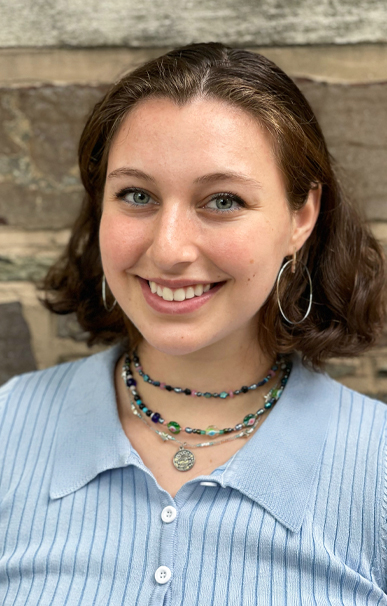 PROJECT
PROJECTSmall-scale Fisheries Hub
ORGANIZATION / LOCATIONEnvironmental Defense Fund (EDF) - San Francisco, California
MENTOR(S)Carlito Turner, Manager, Small-Scale Fisheries Initiatives, EDF
SEE PRESENTATIONThe overall goal of my internship was to support ongoing projects for the Small-Scale Fishery Resource and Collaboration Hub (SSF Hub). My main responsibilities were to assist with social media management, design policy action toolkits, and to create an interview highlight. To help with social media promotion, I created many templates for the SSF Hub’s Instagram account and used them to advertise the photo contest held in honor of the International Year of Artisanal Fisheries and Aquaculture 2022. I also designed a policy action toolkit based on the SSF Hub’s women and gender webinar, and made templates for future toolkits. My third main project was to interview a younger fisherman from Costa Rica about his experience at the United Nations Oceans Conference in Portugal and post the interview as an article on the SSF Hub website. Through this internship, I had the opportunity to practice my graphic design skills as well as my skills in collaborating with a team. This experience has solidified my desire to pursue future academic studies in ecology and to pursue a career in ecological conservation.
-
Pickering, Matthew ’24
School of Public and International Affairs
 PROJECT
PROJECTIntegrating Fisheries Into the Blue Economy
ORGANIZATION / LOCATIONEnvironmental Defense Fund (EDF) - San Francisco, California
MENTOR(S)Christopher Cusack, Director, Oceans Technology Solutions, EDF
SEE PRESENTATIONCertificate(s): History and the Practice of Diplomacy
I worked on a new project to outfit fishing vessels with sensors to collect oceanographic and meteorological data for a global ocean observing network. This was part of a larger effort to integrate fisheries into the blue economy (i.e., the sustainable use of ocean resources) and make sure that small-scale fisheries in particular do not fall behind modern technological standards. I spearheaded this project from EDF’s side. Much of my time was spent working on a white paper with other international oceanographers to detail the project’s history and goals. I also outlined terms of reference for the project. Lastly, I helped organize a series of three international workshops to bring together scientists, ocean-observing systems administrators, and industry stakeholders to craft a longer term strategy. I learned firsthand how collaborative the field of oceanography is, and I gained experience in research, scientific writing, and event organization. This internship has crystallized my desire to pursue a career in sustainability.
-
Pirone, Alec ’24
Civil and Environmental Engineering
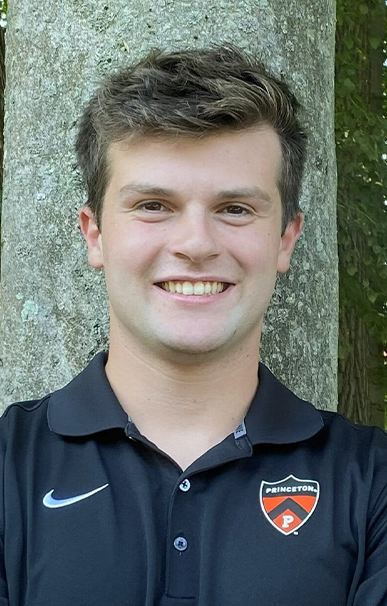 PROJECT
PROJECTFarm Project Field Assistant
ORGANIZATION / LOCATIONRubenstein Lab, Department of Ecology and Evolutionary Biology, Princeton University - Princeton, New Jersey
MENTOR(S)Daniel Rubenstein, Class of 1877 Professor of Zoology, Professor of Ecology and Evolutionary Biology; Gina Talt, Food Systems Project Specialist, Office of Sustainability
SEE PRESENTATIONCertificate(s): Applied and Computational Mathematics
As the population of the Earth increases rapidly, we are required to find ways to increase the amount of food that we are producing through agriculture. We collected data from various farms to determine the efficacy of various farming methods. Our data collection was part of a multiyear project that involved using Arable sensors, devices that provide measures of plant health, temperature, precipitation, and more. We also took measurements of vegetation on a cattle farm to determine the extent to which a certain soil amendment improves vegetation growth; this amendment may help us optimize the production of beef by reducing the amount of land needed for its production. We also used a drone to fly over the fields and collect data on overall plant health. I learned to use a statistical software called JMP to produce graphs of plant growth over time, while also considering factors such as rainfall and temperature. This internship made it clear to me that I am interested in conservation and sustainability related to food production, and I hope to study this further in the future.
-
Reddy, Ash ’25
Molecular Biology
 PROJECT
PROJECTgineering Auxin Plant Hormone Degrading Bacteria for Improved Plant Growth and Productivity
ORGANIZATION / LOCATIONConway Lab, Department of Chemical and Biological Engineering, Princeton University - Princeton, New Jersey
MENTOR(S)Jonathan Conway, Assistant Professor of Chemical and Biological Engineering
SEE PRESENTATIONI studied Variovorax, a bacterial genus that is part of a synthetic microbiome used to model the plant microbiome of natural soil. My project focused on the role of Variovorax in auxin degradation. Auxins are plant hormones that are produced and degraded by members of this synthetic microbial community. They can have various effects on plant development and immunity. Variovorax has been demonstrated to have a role in maintaining plant development by preventing root growth inhibition. I set up and maintained a plant assay to measure phenotypic differences with active and inactive versions of Variovorax along with the rest of the 35-member synthetic microbial community. I started the assay from the point of germination and replicated it for three plant species. I learned about the vital role that the plant microbiome plays in plant development and immunity and gained experience in the specialized laboratory techniques required to manipulate the plant microbiome. I experienced the trial and error of research firsthand and gained a deep appreciation for the pursuit of knowledge.
* This internship is connected to the HMEI Water and the Environment Grand Challenges project, “Probing Microbial Colonization of Plants During Drought to Enable Microbiome-Mediated Resilience in Crops.”
-
Silverstein, Paige ’24
Civil and Environmental Engineering
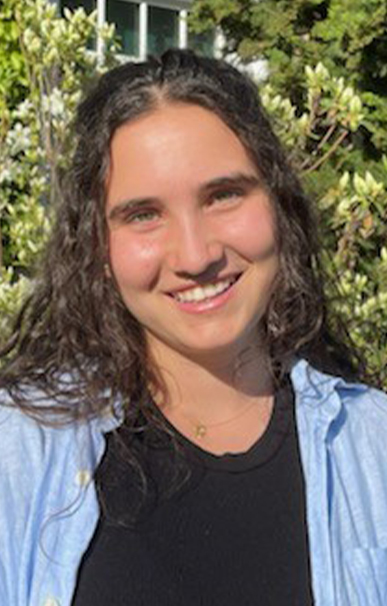 PROJECT
PROJECTClimate-resilient Food Systems
ORGANIZATION / LOCATIONClimate Resilient Food Systems, Environmental Defense Fund (EDF) - Austin, Texas
MENTOR(S)Karly Kelso, Director, Climate Resilient Food Systems, EDF
SEE PRESENTATIONCertificate(s): Applied and Computational Mathematics, French Language and Culture
I worked on developing an accessible systems mapping toolkit for the Environmental Defense Fund’s (EDF) Climate Resilient Food Systems team. Food systems refer to all the elements involved in bringing food from the land and sea onto people’s plates. The global food system produces 33% of the world’s emissions, and, though we are currently producing 1.5 times the global dietary needs, there are still around 750 million people around the globe that face hunger every day. For this reason, it is important to take a holistic approach to food challenges. Every food system is unique, and I hope the toolkit I developed will provide an easy-to-use tool that points people toward meaningful food system interventions and encourages community participation in the discussion of food system transformation. I also had the opportunity to support the team’s work to bring blue and aquatic food dialogue to high-level events such as the United Nations Ocean Conference. I learned so much and honed my research, writing, and communication skills through literature reviews, facilitating meetings, writing for a general audience, developing media cards and communication packets, and more. I am excited to continue my work with EDF throughout the fall.
-
Stewart, Sophia ’24
School of Public and International Affairs
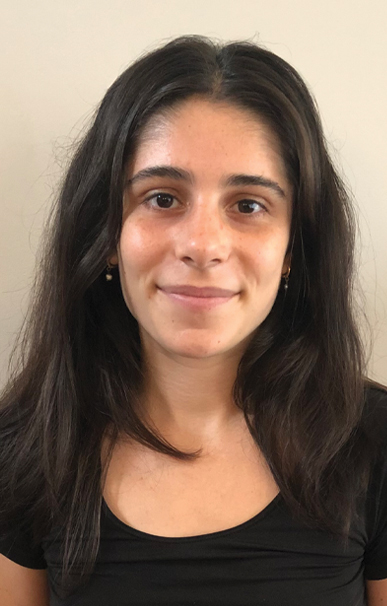 PROJECT
PROJECTFarm Project Field Assistant
ORGANIZATION / LOCATIONRubenstein Lab, Department of Ecology and Evolutionary Biology, Princeton University - Princeton, New Jersey
MENTOR(S)Daniel Rubenstein, Class of 1877 Professor of Zoology, Professor of Ecology and Evolutionary Biology; Gina Talt, Food Systems Project Specialist, Office of Sustainability
SEE PRESENTATIONAgricultural practices have a substantial impact on productivity and the environment. Developing agricultural practices that maximize productivity while minimizing environmental destruction is key to meeting the rapidly increasing global demand for food. Along with my co-interns, I studied five different organic New Jersey farms, and collected data about the growing conditions (e.g., solar radiation, insects, and precipitation) and the agricultural practices (e.g., no-till farming, cover cropping). In addition, we began an experiment to test the efficacy of a fertilizer in increasing productivity. We were able to draw conclusions about how some factors affected the crops and our data will be used to support the undergraduate course “Agriculture, Human Diets, and the Environment.”
- Urban Sustainability
-
Ahn, Jongnam ’25
Undeclared
 PROJECT
PROJECTComputational Approaches in Norm Dynamics Analysis
ORGANIZATION / LOCATIONBehavioral Science for Policy Lab, Princeton University - Princeton, New Jersey
MENTOR(S)Elke Weber, Gerhard R. Andlinger Professor in Energy and the Environment, Professor of Psychology and Public Affairs; Jordana Composto, Ph.D candidate, Psychology
SEE PRESENTATIONI developed and assessed computational approaches for norm identification in texts. Norms are informal rules and practices that guide the behavior of individuals, groups, and societies. Until now, the process of identifying norms in texts has been done manually by researchers, which limits the scope of norms that are identified and can therefore be studied. Our project’s end goal was to use computational tools to find a data-driven method that decreases the bias in labeling normative information in texts; this method could be widely applicable in the fields of psychology and public policy. My first responsibility was to scrape texts that dealt with the environment, as such texts were likely to contain norms. I familiarized myself with environmental, social, and governance reports and Task Force on Climate-Related Financial Disclosures documents from major companies and stakeholders. Our computational approaches were focused on supervised learning (training algorithms using labeled data), so I utilized crowdsourcing techniques to identify which of the collected texts were normative in order to build a training dataset. I gained substantial experience in the program R, and developed a newfound interest in data science and statistics.
-
Batdorff, Delia ’23
Mechanical and Aerospace Engineering
 PROJECT
PROJECTAnalyzing Resilient Net-zero Energy Pathways Using Structured Risk Assessment
ORGANIZATION / LOCATIONEnergy Systems Analysis Group, Andlinger Center for Energy and the Environment, Princeton University - Princeton, New Jersey
MENTOR(S)Chris Greig, Theodora D. ’78 & William H. Walton III ’74 Senior Research Scientist, Andlinger Center for Energy and the Environment; Richard Moss, Visiting Research Collaborator, Andlinger Center for Energy and the Environment
SEE PRESENTATIONCertificate(s): Robotics and Intelligent Systems, Sustainable Energy
I worked to identify, evaluate, and research mitigation strategies for the risks associated with Net-Zero America, which is an effort to reach net-zero emissions in the United States by 2050. Our internship group performed a risk assessment on two of the four pathways associated with Net-Zero America. We researched the various risks associated with a number of potential energy sources (e.g., solar, wind, nuclear, carbon capture and sequestration, and biomass). We then used a framework developed by the International Organization for Standardization to quantify and manage the risks associated with the two different pathways in order to identify which pathway had more extreme risks. I focused on researching the techno-industrial risks associated with each energy source. This included researching safety, mechanical, and construction risks.
-
Blohm, Emeline ’25
Civil and Environmental Engineering
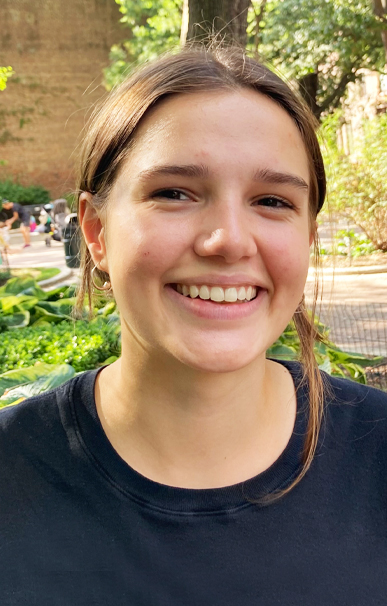 PROJECT
PROJECTAssessing Coastal Resiliency of New York City’s Urban Forest
ORGANIZATION / LOCATIONNew York City Department of Parks and Recreation (NYC Parks) - New York City, New York
MENTOR(S)Tyler Gibson, Senior Forestor, NYC Parks; Ravneet Kaur, Senior Forestor, NYC Parks
SEE PRESENTATIONI studied the vulnerability of New York City’s urban forests to coastal factors such as high-speed winds, saltwater intrusion, and wind-driven salt spray. I assisted in collecting tree health assessment data for 21 planted species in order to assess their suitability for planting in coastal areas. We randomly selected 10 trees of each species in areas along the coastline that are most at risk for saltwater flooding, and then designed a control group of 10 trees for each species further inland where they are at low risk of salt exposure. I performed over 500 individual tree assessments to collect data on the health and environmental tolerance of different tree species. From this, I gained substantial experience in tree identification, most particularly for the species we were studying directly. I participated in fieldwork planning, implementation, data collection, and data management. I cherished the opportunity to conduct well-focused field research that will directly inform species selection for tree planting. As I continue to study climate resiliency in an urban setting, I’m excited to explore how we can draw on a variety of resources and harness both engineering tools and nature-based solutions.
-
Brubaker, Katherine ’24
School of Public and International Affairs
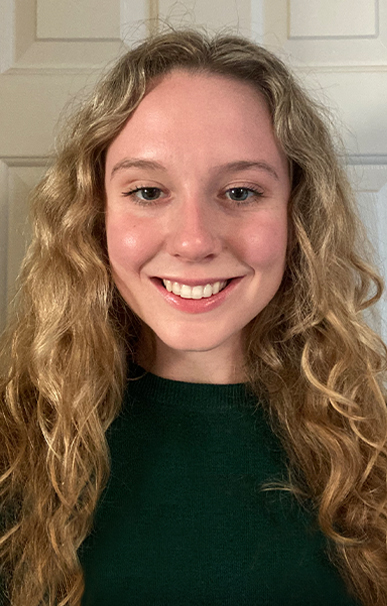 PROJECT
PROJECTPower Industry Decision Making Processes Amid India's Energy Transition
ORGANIZATION / LOCATIONBehavioral Science for Policy Lab, Princeton University - Princeton, New Jersey
MENTOR(S)Elke Weber, Gerhard R. Andlinger Professor in Energy and the Environment, Professor of Psychology and Public Affairs; Pooja Ramamurthi, Ph.D. candidate, School of Public and International Affairs
SEE PRESENTATIONCertificate(s): Journalism
I aimed to understand organizational decision-making processes for India’s energy transition to renewable energy. I studied various organizations that are either part of civil society, the government, or private companies. Additionally, I focused on investigating the current role and status of coal within India. I interviewed 90 individuals from various companies and asked questions about their company goals, their perceptions of the Indian power sector goals, and who they saw as power sector decision-makers. I transcribed these interviews into a final codebook, which encompasses a set of 33 themes divided into three overarching categories: drivers of coal phaseout, drivers for coal to remain, and moderating factors. A team of coders then analyzed the interviews to qualitatively identify them. The coders also documented interviewees’ perceptions of government, industry, civil society, and consumers. This research opportunity provided me with insight into how power industry companies view India’s energy transition, as well as how this transition is actively taking place. My experience has compelled me to pursue my own research on environmental topics, and to continue working with the Behavioral Science for Policy Lab this fall.
-
Finch, Benjamin ’23
Electrical and Computer Engineering
 PROJECT
PROJECTAnalyzing Resilient Net-zero Energy Pathways Using Structured Risk Assessment
ORGANIZATION / LOCATIONEnergy Systems Analysis Group, Andlinger Center for Energy and the Environment, Princeton University - Princeton, New Jersey
MENTOR(S)Chris Greig, Theodora D. ’78 & William H. Walton III ’74 Senior Research Scientist, Andlinger Center for Energy and the Environment; Richard Moss, Visiting Research Collaborator, Andlinger Center for Energy and the Environment
SEE PRESENTATIONI contributed to two energy transition research projects. Firstly, I conducted a systematic risk assessment of two of the energy transition pathways modeled by the Net-Zero America (NZA) study. I determined criteria for the consequence and likelihood of different risk types by combing the literature for different risks, and then evaluated these risks. I also modeled the copper, lithium, and rare earth metal energy related demand for all of the NZA pathways. In my second research project, I examined potential capital shortages of an energy transition in the United States. This work involved determining the total and high-risk (pre-financial investment decision) annual capital requirements for each of the NZA project modeled pathways. Then, I compared these annual quantities of total capital and high-risk capital to current and projected clean technology capital expenditure in the United States by banks, conventional energy companies, utilities, and renewable energy companies. I honed my data-processing skills by building a computer program to process large sets of expenditure data, and also deepened my understanding of the mechanics of efficient energy transition pathways and the unprecedented capital requirements of these pathways.
-
Greenspan, Noa ’23
English
 PROJECT
PROJECTClimate Story Incubator: Coastal Futures
ORGANIZATION / LOCATIONEnvironmental Media Lab, Effron Center for the Study of America and the High Meadows Environmental Institute, Princeton University - Princeton, New Jersey; Virginia Beach, Virginia
MENTOR(S)Allison Carruth, Professor of American Studies and the High Meadows Environmental Institute; Diana Little, Ph.D. candidate, English; Kyra Morris, Ph.D. candidate, English; Gemma Sahwell, Ph.D. candidate, Geosciences
SEE PRESENTATIONCertificate(s): Creative Writing, Environmental Studies
The Coastal Futures project aims to tell audio stories about the impacts of sea level rise and flooding in East Coast communities, and more broadly, to relate how community members view their coastal identities and futures. I worked from my home region of southeastern Virginia, where I wrote and produced two stories for the project. The first examined the city’s history of displacement through the story of a public housing unit in Norfolk that is currently being replaced by flood-resilient, mixed-income housing. The second explored clashing perspectives of Virginia Beach’s nonnative palm trees and the city’s identity as a tourist town.
-
Ho, Celine ’25
Molecular Biology
 PROJECT
PROJECTClimate Story Incubator: Coastal Futures
ORGANIZATION / LOCATIONEnvironmental Media Lab, Effron Center for the Study of America and the High Meadows Environmental Institute, Princeton University - Calcasieu Parish, Louisiana; Princeton, New Jersey
MENTOR(S)Allison Carruth, Professor of American Studies and the High Meadows Environmental Institute; Diana Little, Ph.D. candidate, English; Kyra Morris, Ph.D. candidate, English; Gemma Sahwell, Ph.D. candidate, Geosciences
SEE PRESENTATIONCertificate(s): Global Health and Health Policy
I studied the health implications of hurricanes and floods along the Eastern Seaboard. I focused on Hepatitis A, a viral infection that attacks the liver. Hepatitis A is commonly transmitted via the consumption of contaminated food or water, and such transmission often spikes after flooding events and other natural disasters. The high development of agricultural areas across the Eastern Seaboard followed the average trajectory of hurricanes from 2005 to 2021. The purpose of my research was to use scholarly findings of Hepatitis A patterns as a control variable for different locations, to unveil external factors of social disparities that result from a natural disaster. The goal was to identify how different communities respond to extreme weather events and environmental changes in hyper-localized areas. I worked with members of Columbia University’s Mailman School of Public Health, Massachusetts General Hospital, and residents in Calcasieu Parish, Louisiana, who have been directly devastated by hurricanes. I learned that the repercussions of hurricanes are complex and everlasting. From immediate health onsets to crowding responses in shelters, climate disasters are multilayered. These problems ask us to rethink and reconnect issues of human health and climate even at the most microscopic levels.
-
Hoplamazian, Lena ’24
History
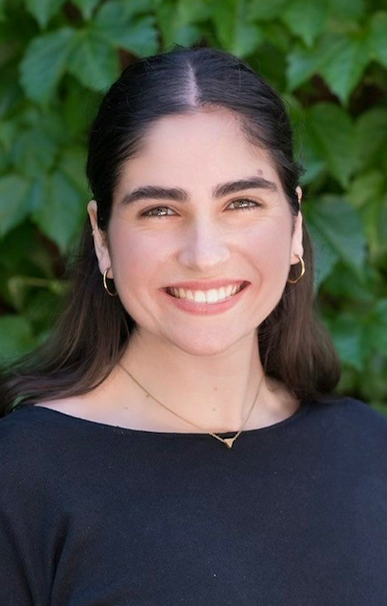 PROJECT
PROJECT“Cleaning Up”: Case Studies on Environmental Remediation in New York City
ORGANIZATION / LOCATIONThe Architectural League of New York - New York City, New York
MENTOR(S)Mariana Mogilevich, Editor-in-Chief, The Architectural League of New York; Joshua McWhirter, Managing Editor, The Architectural League of New York
SEE PRESENTATIONCertificate(s): Architecture and Engineering
I worked on the “Cleaning Up” series for the Urban Omnibus publication; a collection of features looking at toxic spaces, pollution, and environmental remediation in New York City. My project centered around researching and developing illustrated case studies, which are illustrations representing “before” and “after” stories of heavily polluted and remediated sites in the New York City area. Researching the information for the case studies helped me hone my research skills, but taking the details and deciding how to visually represent them to tell a story was the truly unique part of this internship, and the aspect that most challenged me. After years of honing my communication skills with words, it was a great opportunity to communicate with visuals. This internship enabled me to explore the intersection of urban space and the environment, and to look closely at how pollution, toxicity, and communal efforts to heal environmental damage interact in the city. It renewed my commitment to the urban environment, a long-time interest and passion of mine. I was also immersed in the architecture world, working out of The Architectural League office, which made me even more excited to continue my coursework and research in the Architecture and Engineering certificate program.
-
Jerdee, Alexandra ’25
Computer Science
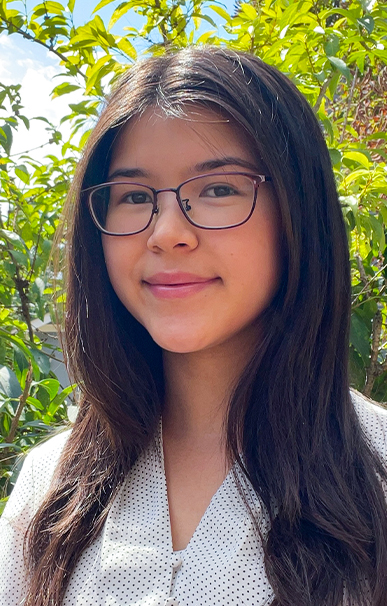 PROJECT
PROJECTUrban Tree Cover Distributions Associated With Aggregate Development and Social Hierarchies: A Case Study of the City of Pune, India
ORGANIZATION / LOCATIONUrban Nexus Lab, Department of Civil and Environmental Engineering, Princeton University - Princeton, New Jersey
MENTOR(S)Anu Ramaswami, Sanjay Swani ’87 Professor of India Studies, Professor of Civil and Environmental Engineering, Princeton Institute for International and Regional Studies and the High Meadows Environmental Institute; Bhartendu Pandey, Associate Professional Specialist, Department of Civil and Environmental Engineering
My work in examined urban tree cover disparities in relation to developmental indicators in 146 neighborhoods in the city of Pune, India. Urban tree cover refers to the area covered under a tree’s canopy in an urban area. This metric has been shown to shape environmental and human health outcomes. The topic of urban tree cover distribution disparities in the Global South has been relatively understudied. I used a random forest machine learning model and satellite images to derive a map of urban tree cover in Pune in the R programming language. I also used principal component analysis applied to public infrastructure and private assets ownership datasets to assess development levels across neighborhoods, which I examined alongside my urban tree cover data. Thanks to the guidance and encouragement from my mentors, I gained a better understanding of multidimensional inequalities in Indian cities, and I honed many technical skills that are transferable to my broader academic interests. I now have greater competency in the programs Python, R, and some GIS softwares, as well as increased confidence in my academic reading and writing.
-
Knell, Ben ’25
Operations Research and Financial Engineering
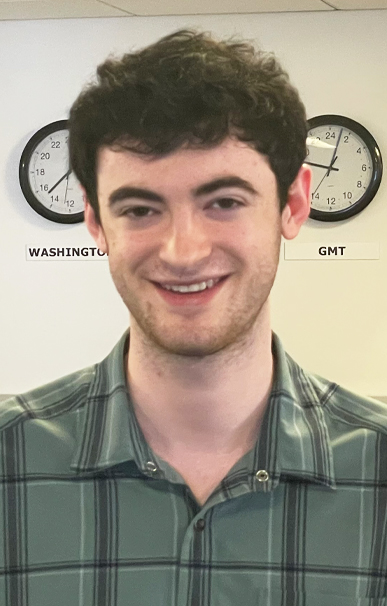 PROJECT
PROJECTClimate and Conflict: Understanding and Responding to Strategic Risk
ORGANIZATION / LOCATIONEmpirical Studies of Conflict, School of Public and International Affairs, Princeton University - New York City, New York
MENTOR(S)Jacob Shapiro, Professor of Politics and International Affairs, School of Public and International Affairs; Ulrich Eberle, Visiting Research Collaborator, School of Public and International Affairs
I analyzed the intersection of climate change and conflict in various regions of interest around the world. Climate change often exacerbates existing tensions, thus contributing to conflict via food insecurity and displacement. One of my central tasks was to assess potential climate risks. I studied the findings of the Intergovernmental Panel on Climate Change and various scientific publications to create a broader picture of the impacts of climate change in each region. I then assessed how each aspect of climate change could impact conflict and displacement based on each region’s present challenges and resources. Over the course of this internship, I learned about the process by which research and data become policy, and also had the chance to be activelt involved in this process. For instance, when Future of Conflict Director Robert Blecher was called upon as an expert in a congressional hearing on conflict and climate change, I was able to contribute to the speech and preparatory materials. This internship has taught me both the intrinsic importance of data and the importance of being able to put it into context through interdisciplinary analysis. In my future studies, I plan to explore statistics and interdisciplinary courses related to climate change.
-
Magistro, Ethan ’24
Philosophy
 PROJECT
PROJECTAnalyzing Resilient Net-zero Energy Pathways Using Structured Risk Assessment
ORGANIZATION / LOCATIONEnergy Systems Analysis Group, Andlinger Center for Energy and the Environment, Princeton University - Princeton, New Jersey
MENTOR(S)Chris Greig, Theodora D. ’78 & William H. Walton III ’74 Senior Research Scientist, Andlinger Center for Energy and the Environment; Richard Moss, Visiting Research Collaborator, Andlinger Center for Energy and the Environment
SEE PRESENTATIONCertificate(s): Environmental Studies, History and the Practice of Diplomacy
I identified and evaluated risks to the United States’ aim of attaining net-zero emissions by 2050. My team and I applied a structured risk assessment framework based on the ISO 31000 risk management standard to two pathways developed in detail by the Princeton Net-Zero America (NZA) study. We first created a research framework that divided risks into societal, techno-industrial, and environmental categories. We then identified, analyzed, and evaluated potential execution failures and climate resilience risks of technologies deployed in NZA. We identified and ranked over 700 risks facing the United States’ transition to net-zero, including risks related to climate resilience and social and political opposition. Through this project, I developed the ability to conduct robust risk assessment, and I cultivated skills in identifying political and legal challenges as well as environmental, social, and corporate governance risks. I also increased my familiarity with international trade and supply chain management. Our work has further put into perspective how extreme the challenge of mitigating climate change is for the United States. I hope our findings will serve as a call to action for business and government stakeholders on the need to mitigate key risks as they pursue the transition to net zero.
-
Parikh, Krishna
Operations Research and Financial Engineering
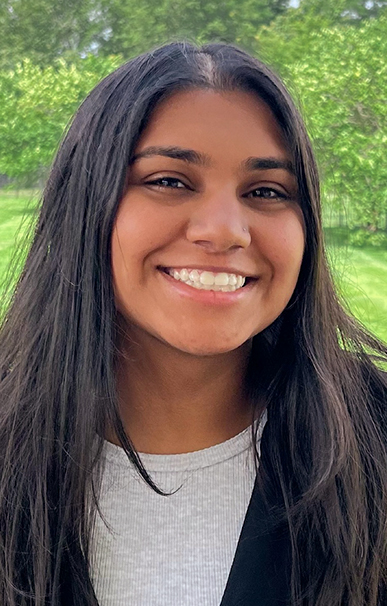 PROJECT
PROJECTGlobal Health Communications Intern
ORGANIZATION / LOCATIONOne Health Trust (OHT)
MENTOR(S)Ramanan Laxminarayan, Founder and Director, OHT, Senior Research Scholar, High Meadows Environmental Institute, Princeton University; Erta Kalanxhi, Research Fellow, OHT; Geetanjali Kapoor, Head of South Asia, OHT; Siddhi Lama, Science Communications Associate; Samantha Serrano, Science Communications Manager, OHT
SEE PRESENTATIONOne Health Trust (OHT) was previously recognized as the Center for Disease Dynamics, Economics, and Policy. The renaming emphasizes the importance of One Health and the interconnectedness between humans, animals, and the environment in solving public and global health issues. I assisted with this transition through image processing, compression, and search engine optimization. I also contributed to communications by writing weekly digest posts that provided an overview of health updates. My knowledge on antimicrobial resistance grew, as I wrote a summary on its status in Africa and helped summarize tables for a continental summary on the subject. I researched regenerative agriculture and compiled information on companies and organizations adopting the practice in Nepal and India. I reached out to these organizations to gain information on their specific agricultural techniques in order to develop a better understanding of sustainability efforts in such areas. Overall, the internship opened my eyes to the amount of behind-the-scenes work that is necessary to allow a group like OHT to function. I am now more assured of my interest in public health and policy, especially computational epidemiology.
-
Patel, Shlok ’25
Electrical and Computer Engineering
 PROJECT
PROJECTHow Happy Are People in Different Cities in the United States and India?
ORGANIZATION / LOCATIONUrban Nexus Lab, Department of Civil and Environmental Engineering, Princeton University - Princeton, New Jersey
MENTOR(S)Anu Ramaswami, Sanjay Swani ’87 Professor of India Studies, Professor of Civil and Environmental Engineering, Princeton Institute for International and Regional Studies and the High Meadows Environmental Institute; Kirti Das, Associate Professional Specialist, Civil and Environmental Engineering
I worked on three main projects related to the Urban Nexus Lab’s goal of advancing sustainable, healthy, and equitable cities via knowledge coproduction and connecting multiple sectors across spatial scales with multiple societal outcomes. First, I helped advance the process of using scalable nondestructive methods to measure tree carbon storage and sequestration in Indian cities. I worked with light detection and ranging scanning and learned the value of conserving urban greenery to offset carbon emissions. More generally, this project helped me understand the need for more foundational research related to remote sensing and geographical information in other countries due to technological limitations. Secondly, I helped create land cover datasets through ArcGIS, a geographic information system, which helped train and validate machine learning models that improve remote sensing methods in India. This was crucial to introducing me to Urban Tree Canopy research, which nourished my interest for the third project: a research proposal studying the effects of the Urban Tree Canopy on subjective well-being. I found the proposal writing process extremely fruitful, as it introduced me to independent research and informed me on the myriad of ways that environmental research can directly and immediately impact modern society.
-
Poost, Magdalena ’23
Anthropology
 PROJECT
PROJECTClimate Story Incubator: Coastal Futures
ORGANIZATION / LOCATIONEnvironmental Media Lab, Effron Center for the Study of America and the High Meadows Environmental Institute, Princeton University - Lambertville, New Jersey; Princeton, New Jersey
MENTOR(S)Allison Carruth, Professor of American Studies and the High Meadows Environmental Institute; Diana Little, Ph.D. candidate, English; Kyra Morris, Ph.D. candidate, English; Gemma Sahwell, Ph.D. candidate, Geosciences
SEE PRESENTATIONCertificate(s): Creative Writing, Environmental Studies, Theater
I conducted ethnographic research on the city of Lambertville, New Jersey, to understand how the community has experienced the recovery process from flooding caused by Hurricane Ida in fall 2021. As coastal communities across the world suffer and learn from intensifying weather events due to the climate emergency, scientists and artists are beginning to search for alternative modes of storytelling to communicate what is lost and what is learned, beyond simple disaster narratives. My project aimed to use the medium of audio narratives to investigate, document, and produce stories about lived experiences of extreme weather and changing environmental conditions in specific coastal communities in the mid-Atlantic. I interviewed residents, business owners, and medical professionals who were personally affected by Hurricane Ida. Recordings of my interviews were produced as one part in a series of such stories created by fellow interns. The experience of engaging with climate activism through an on-the-ground approach to art making has informed how I am conceiving my thesis work and future project aspirations. I plan to continue combining ethnography, ecology, and art to make pieces that help communicate the nuances of the climate nexus.
-
Singh, Riya ’23
School of Public and International Affairs
 PROJECT
PROJECTClimate Resilient Coasts and Watersheds
ORGANIZATION / LOCATIONEnvironmental Defense Fund (EDF) - New York City, New York
MENTOR(S)Kate Boicourt, Director, Climate Resilient Coasts and Watersheds, New York- New Jersey, EDF
SEE PRESENTATIONCertificate(s): Environmental Studies
My internship focused on supporting the Environmental Defense Fund’s (EDF) efforts to spread the word on the Clean Water, Clean Air, and Green Jobs Bond Act, which is on the New York general elections ballot. EDF participates in the Clean Water and Jobs Coalition, which builds voter support for the Act. I contributed by identifying and reaching out to community groups that could share materials to voters, especially in historically underserved neighborhoods. I also worked on a collaborative research project in which I examined New York’s storm recovery programs to understand how they incorporate green infrastructure. I analyzed policy documents to pinpoint barriers and opportunities to utilizing green infrastructure in making homes more resilient to natural disasters. I gained insight into not only the science of coastal resilience and green infrastructure but also into how environmental campaigns are run. I also learned how 501(c)(3) nonprofits like EDF navigate the legal restrictions surrounding their advocacy when crafting campaign language. Moving forward, I’m interested in researching the Bond Act for my senior thesis; specifically, I want to explore voter behavior for the Act across community demographics.
-
Vilna-Santos, Chiara ’24
Architecture
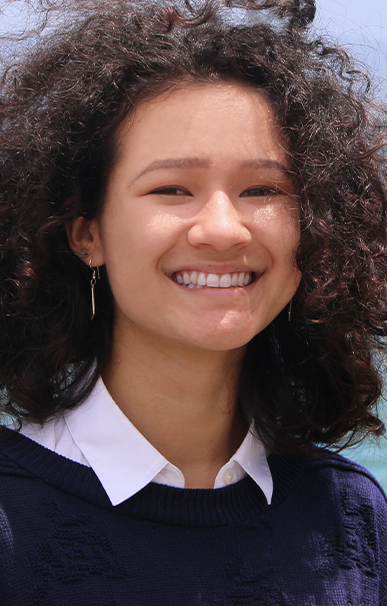 PROJECT
PROJECTBuilding Capacity for Neighborhood Sustainability in New Orleans
ORGANIZATION / LOCATIONBroad Community Connections - New Orleans, Louisiana
MENTOR(S)Dasjon Jordan, Executive Director, Broad Community Connections; Chris Daemmrich, Visiting Assistant Professor, Phyllis M. Taylor Center for Social Innovation and Design Thinking, Tulane University
SEE PRESENTATIONCertificate(s): Urban Studies
I created a series of scenes that imagined what the future of New Orleans could look like in terms of stormwater management. My co-intern and I prepared this work with the idea that it would then be compiled into a small booklet that would be distributed to the community. The goal of this project was not to prescribe a specific plan for people to follow. Rather, by creating personal stories that community members could see themselves in, readers might find inspiration and build agency when it comes to their own relationship with stormwater management. Our work was primarily collage-based, using construction paper, hand drawings, and cutouts from local magazines and newspapers. We pulled from archives and stories that centered around New Orleans history to inform our stories and ground them in reality. In addition, we regularly met with community members, artists, community organizers, and educators to learn from them, listen to their stories, and receive feedback on our work. I learned how to organize workshops and structure effective feedback sessions. I met with a number of nontraditional architects and was inspired to think differently about how architects and planners can build for or with communities.
-
Zhang, Justin ’24
Molecular Biology
 PROJECT
PROJECTBuilding Capacity for Neighborhood Sustainability in New Orleans
ORGANIZATION / LOCATIONBroad Community Connections - New Orleans, Louisiana
MENTOR(S)Dasjon Jordan, Executive Director, Broad Community Connections; Chris Daemmrich, Visiting Assistant Professor, Phyllis M. Taylor Center for Social Innovation and Design Thinking, Tulane University
SEE PRESENTATIONCertificate(s): Visual Arts
I researched the rich history, culture, and power of the historically Black neighborhoods in the Broad Community Connections (BCC) service area, as well as the socio-environmental challenges they face. My co-intern and I conducted regular meetings and led presentations and workshops with community members, organizations, leaders and educators, among others. We listened to and read countless stories that spanned the inception of New Orleans to the present day. From our research, we produced a zine — a small booklet containing artwork and stories — about an imagined future of the BCC neighborhoods. The zine is intended to be copied and circulated throughout the community and to serve as an educational tool that prompts residents to see, imagine, and invest in a sustainable future. We also hope to bring publicity to the work of BCC and various environmental, health, educational, and commercial revitalization efforts in the area. I learned about the power of grassroots organizing, trust building, and genuine investment in community spaces and assets. Learning about the tragic pitfalls of engineering, planning, and design through this hands-on experience was alarming. I found that we have a responsibility to approach these fields more holistically, critically, and with more empathy and engagement toward communities to ensure a just and equitable future.
- Water and the Environment
-
Alfaro, Bryan ’24
Mechanical and Aerospace Engineering





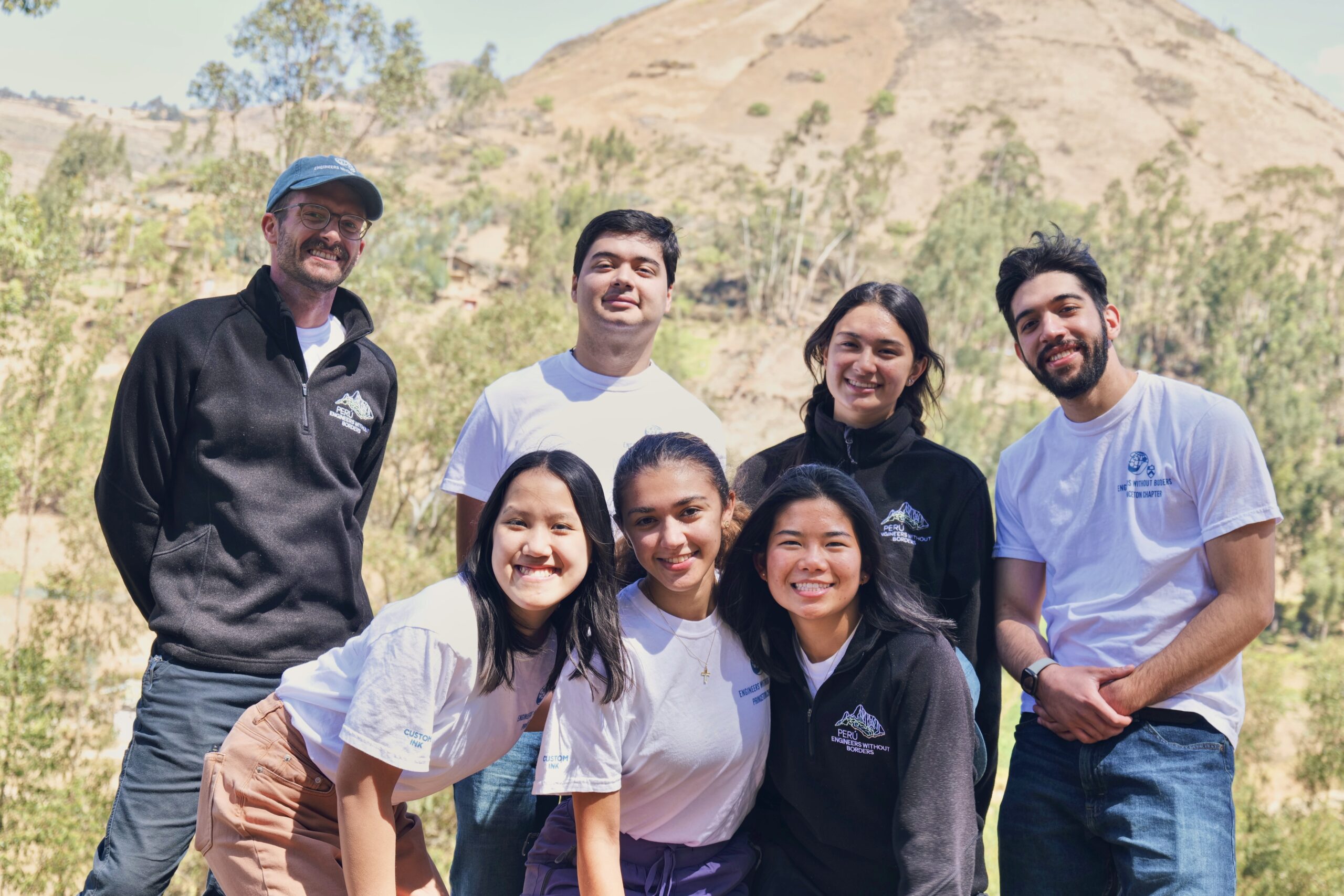 PROJECT
PROJECTMonitoring and Assessment in Peru
ORGANIZATION / LOCATIONEngineers Without Borders (EWB), Princeton Chapter, Peru - Carnachique, Peru; Pusunchás, Peru
MENTOR(S)Sigrid Adriaenssens, Professor of Civil and Environmental Engineering, Princeton University; Scott Gregory, Program Engineer, EWB
SEE PRESENTATIONCertificate(s): Applications of Computing, Robotics and Intelligent Systems
Our team traveled to La Libertad, Peru, to complete the monitoring and evaluation phase of our project in Pusunchás and to begin the assessment phase of our new project in Carnachique. We aimed to close out the Pusunchás project by gauging community satisfaction with the construction of the gravity-fed potable water system. We did this through surveys and by completing a technical evaluation, walking through the system starting from the source captures through each of the distribution lines. During our assessment in Carnachique, we walked through the irrigation canals, taking notes on GPS data points in addition to qualitative features along the length of the 1.6 km system. We gained knowledge on this trip of the issues that the Carnachique community face and the reasons it is important to them that we complete this project. We also learned many technical details that are important for us to consider when we design the new system in Carnachique. Once the construction is complete, our team will travel to Peru one last time to ensure that the system is working properly; if it is, the team will find a new community with which to work. Overall, this experience has allowed us the opportunity to incorporate scientific research with our course work.
-
Alvarado, Juan Pablo ’23
Civil and Environmental Engineering
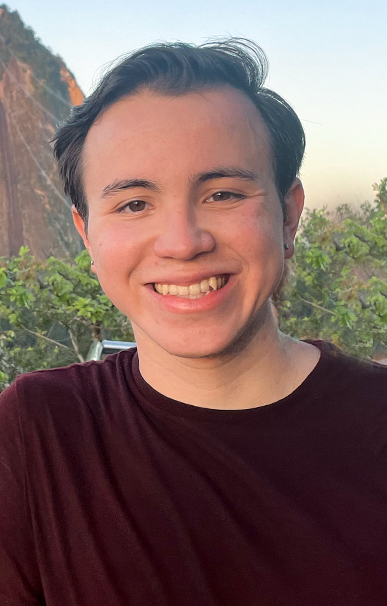 PROJECT
PROJECTClay-Aginate Mixture as a Proxy for Mineral-Oganic Interactions in Soils
ORGANIZATION / LOCATIONInterfacial Water Group, Department of Civil and Environmental Engineering, Princeton University - Princeton, New Jersey
MENTOR(S)Ian C. Bourg, Associate Professor of Civil and Environmental Engineering and the High Meadows Environmental Institute; Avery Agles, Ph.D. candidate, Chemical and Biological Engineering
SEE PRESENTATIONCertificate(s): Materials Science and Engineering
The goal of my internship was to explore the impact of the coupling of biofilms and clay on the sedimentary and rheological properties of an aqueous solution. Clay amounts to a large percentage of sediment throughout the world and there is a need to understand the fundamental properties of clay that dictate its flow. It is thought that natural organic matter impacts the properties of clay that dictate flow. The goal of my research was to provide insight and preliminary findings to better understand this phenomenon. To achieve this goal, I read relevant literature on the research surrounding the topic, created a protocol for my experimental work, and used the Anton Paar MCR 501 rheometer to perform measurements. Doing this work, however, has made me realize that I would like to transition into environmental justice and focus on a direct connection between society and the environment. Although I have been passionate about my work, I have recently been inspired to pursue an interdisciplinary approach to climate change in my future endeavors.
-
Bhandarkar, Riti ’23
Civil and Environmental Engineering





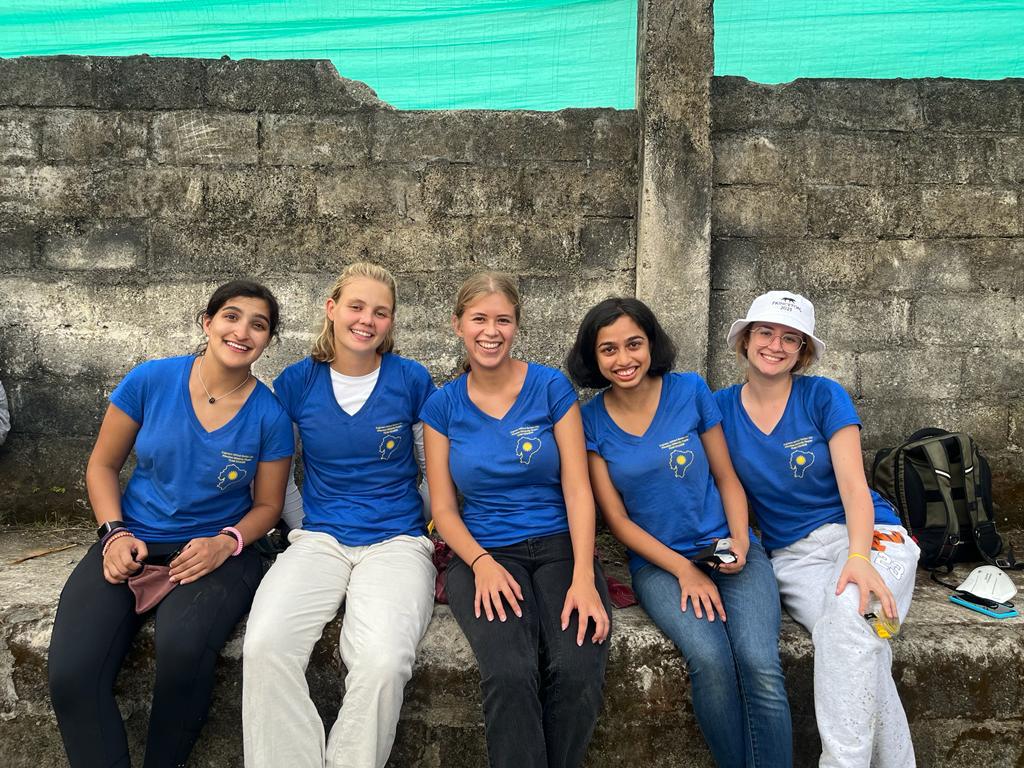 PROJECT
PROJECTPotable Water System Assessment
ORGANIZATION / LOCATIONEngineers Without Borders (EWB), Princeton Chapter, Ecuador- Manabí, Ecuador
MENTOR(S)Sigrid Adriaenssens, Professor of Civil and Environmental Engineering, Princeton University; Nolan Perreira, Project Mentor, EWB
SEE PRESENTATIONCertificate(s): Sustainable Energy
Our team conducted the assessment phase of a potable water system project for the community of Rosario Vainas in Manabí, Ecuador. The goal of this project is to design and implement a water system that will provide potable water for approximately 180 households. Rosario Vainas is a small, rural village in the rainforest lowlands of Ecuador. Currently, residents receive their water from a combination of tanks delivered from a nearby city, small hand-dug wells in the area, and a nearby river. In order to design the new water system, our team collected data on the existing water sources in the community to determine the continuity of the underground aquifer and to quantify contamination levels from agricultural surface runoff. We also surveyed members of the community to understand water and electricity access and usage, climate trends in the area, and to receive community input on our project design. Through this fieldwork, we successfully obtained the requisite geological, geographic, and demographic data to design a well for the community. We also formed relationships with community members and a local nongovernmental organization, relationships that are essential for building trust and stability in the project.
-
Cabrera Martinez, Camila ’24
Chemical and Biological Engineering
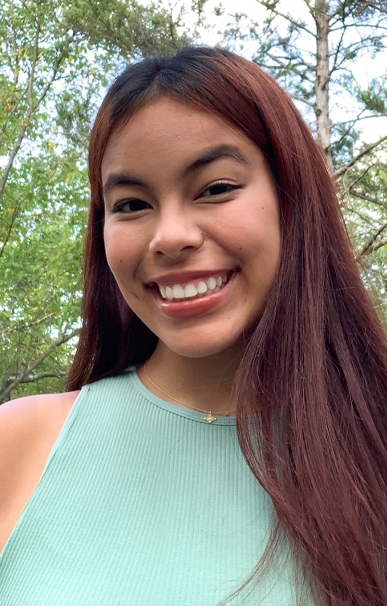 PROJECT
PROJECTAssessing Water Quality With the StreamWatch Bacterial Action Team
ORGANIZATION / LOCATIONThe Watershed Institute - Pennington, New Jersey
MENTOR(S)Jian Smith, StreamWatch Program Coordinator, The Watershed Institute; Erin Stretz, Assistant Director of Science and Stewardship, The Watershed Institute
SEE PRESENTATIONI worked to monitor and assess water quality and stream health throughout central New Jersey. I processed weekly water samples from different bodies of water, tested for E. coli and general coliform bacteria, tested nutrient levels (phosphate, nitrate, and chloride) and turbidity, and took phycocyanin readings to test for harmful algal blooms. I used the results from these tests to evaluate and score the samples for each site in three five-week sessions according to The Watershed Institute’s framework for water quality assessment and the New Jersey Department of Environmental Protection’s surface water quality standards. I used these guidelines to develop formulas in Excel to convert individual numerical results into an overall score for each parameter for every site; a process that had previously been done manually. Additionally, I used ArcGIS software to create and publish a dashboard, displaying all test results on a map, and created graphs to visualize trends in the E. coli and nutrient levels throughout the summer. I gained both field and lab experience, learned a lot about the different factors that influence the health of our waterways, and became proficient in several methods of data analysis and distribution.
-
Cao, Ashley ’23
Civil and Environmental Engineering
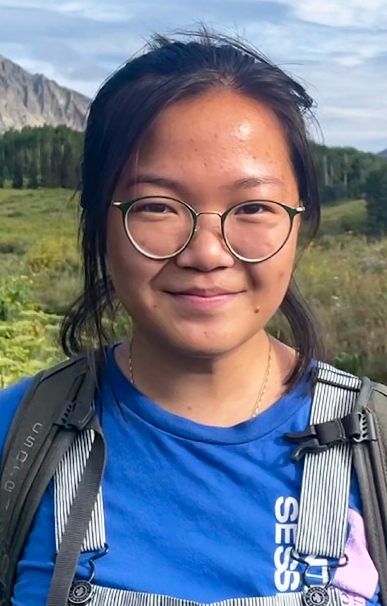 PROJECT
PROJECTUnderstanding Watershed Processes in Complex Terrain: Mountain Hydrology at Snodgrass Hillslope
ORGANIZATION / LOCATIONIntegrated GroundWater Modeling Center, Department of Civil and Environmental Engineering, Princeton University - Rocky Mountain Biological Laboratory, Gothic, Colorado
MENTOR(S)Reed Maxwell, Professor of Civil and Environmental Engineering and the High Meadows Environmental Institute; Jackson Swilley, Ph.D. candidate, Civil and Environmental Engineering
SEE PRESENTATIONCertificate(s): Environmental Studies
I studied the hydrology of Snodgrass Hillslope, a well-studied and representative headwater catchment for the Upper Colorado River Basin located within the East River Watershed. In the context of climate change, it is increasingly crucial that we understand the hydrologic processes of watersheds that feed major water sources like the Colorado River; this knowledge will help us address issues of drought in the Western United States. Through daily field work, I measured soil moisture, conducted infiltrometer tests, monitored tensiometer readings, and updated meteorological towers with new loggers. Additionally, I assisted in the installation of a weir plate onto an abandoned flume. I gained skills in vegetative identification, and improved my working-knowledge of GIS, GPS, Python, and ParFlow-CLM. I met with hydrologists studying the East River Watershed and had the opportunity to sit-in on their fieldwork, where I learned about stream gauging and water sampling. I am pursuing an extension of this research for both my senior thesis and the American Geophsyical Union. My thesis will combine this summer field data with hydrologic modeling skills to examine the effects of different climate change scenarios on the vegetative makeup of the Snodgrass Hillslope, and thereby predict potential changes to water availability downstream.
-
Castleman, Jane ’25
Computer Science
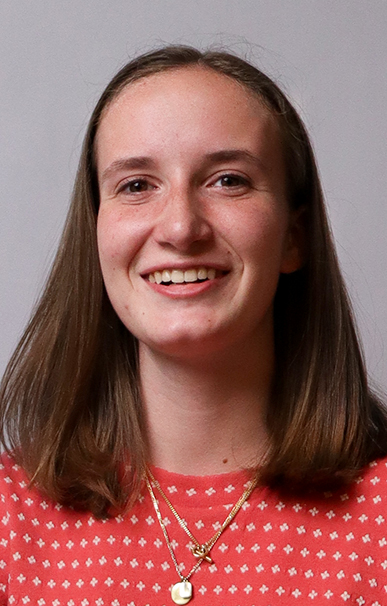 PROJECT
PROJECTThe Interface of Hydrology and Machine Learning: Generating Better Information for Decision-makers and Educating the Decision-makers of the Future
ORGANIZATION / LOCATIONIntegrated GroundWater Modeling Center, Department of Civil and Environmental Engineering, Princeton University - Princeton, New Jersey
MENTOR(S)Reed Maxwell, Professor of Civil and Environmental Engineering and the High Meadows Environmental Institute; Lisa Gallagher, Education and Outreach Manager, High Meadows Environmental Institute
Certificate(s): Environmental Studies, Technology and Society
Estimating water table depth (WTD) across the contiguous United States is important in providing reliable information to water decision-makers and producing inputs for predictive models. WTD predictions are increasingly being performed via machine learning to reduce the computational expense of using physics-based models. For my project, I compared the effectiveness of using observational data as opposed to simulated data as the input for machine learning models. I then tested the ability of the machine learning model to predict WTD with different sets of training and testing data. Each set of data consisted of averaged data from one week of observations. Overall, using observational data for the prediction of WTD could be a promising method for generating reliable information about WTD for water management and climate futures. Another project goal was to inform the water decision-makers of the future. To do this, we developed and implemented a water and climate academy for local high schoolers. In this program, we taught students the mathematical fundamentals of machine learning, its basis in pattern recognition, and the importance of good data in machine learning.
-
Chen, Vivian ’25
Electrical and Computer Engineering





 PROJECT
PROJECTMonitoring and Assessment in Peru
ORGANIZATION / LOCATIONEngineers Without Borders (EWB), Princeton Chapter, Peru - Carnachique, Peru; Pusunchás, Peru
MENTOR(S)Sigrid Adriaenssens, Professor of Civil and Environmental Engineering, Princeton University; Scott Gregory, Program Engineer, EWB
SEE PRESENTATIONOur team traveled to La Libertad, Peru, to complete the monitoring and evaluation phase of our project in Pusunchás and to begin the assessment phase of our new project in Carnachique. We aimed to close out the Pusunchás project by gauging community satisfaction with the construction of the gravity-fed potable water system. We did this through surveys and by completing a technical evaluation, walking through the system starting from the source captures through each of the distribution lines. During our assessment in Carnachique, we walked through the irrigation canals, taking notes on GPS data points in addition to qualitative features along the length of the 1.6 km system. We gained knowledge on this trip of the issues that the Carnachique community face and the reasons it is important to them that we complete this project. We also learned many technical details that are important for us to consider when we design the new system in Carnachique. Once the construction is complete, our team will travel to Peru one last time to ensure that the system is working properly; if it is, the team will find a new community with which to work. Overall, this experience has allowed us the opportunity to incorporate scientific research with our course work.
-
DiMare, Francesca ’23
Chemistry






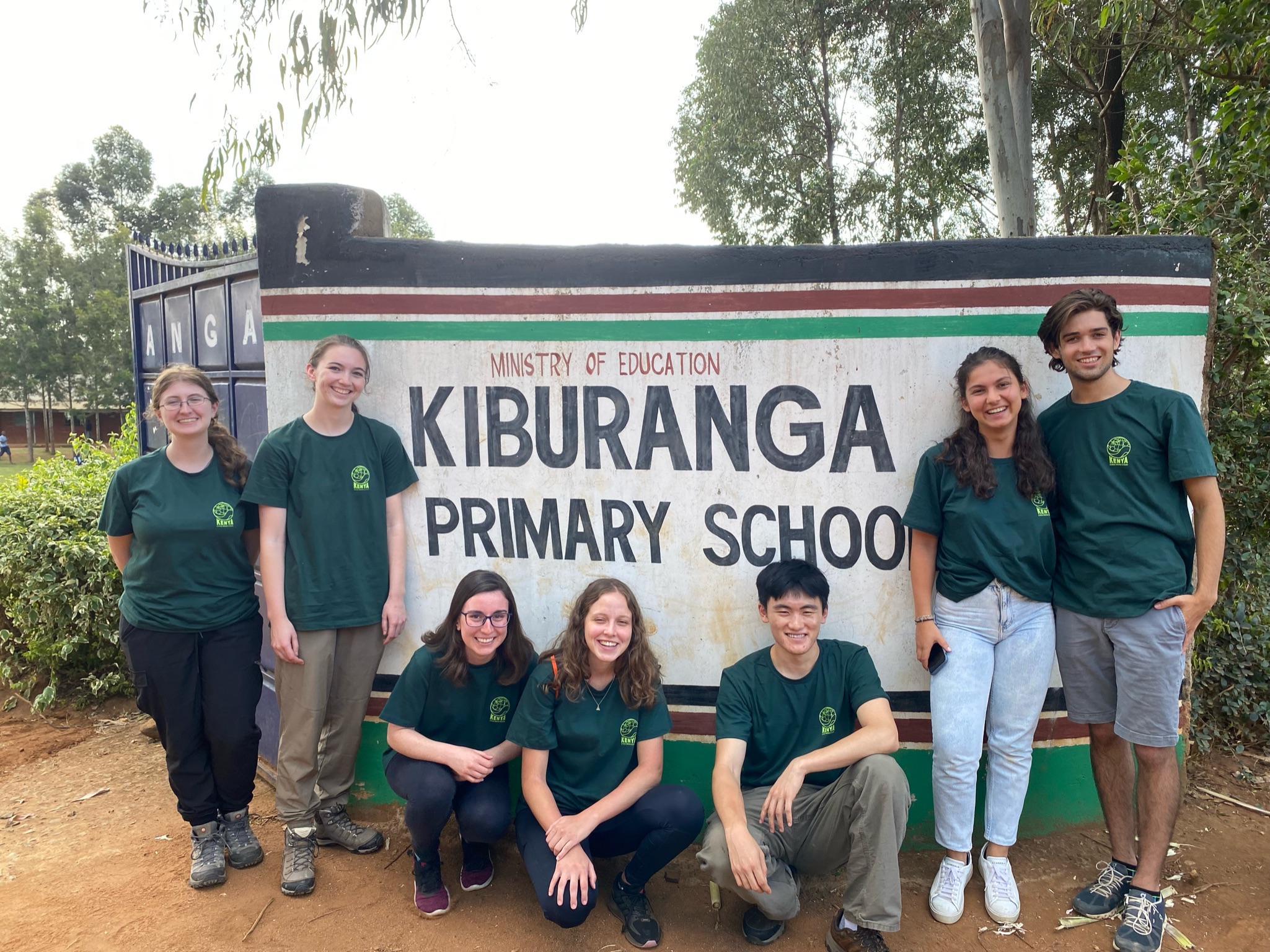 PROJECT
PROJECTMonitoring and Assessment at Kiburanga Primary School
ORGANIZATION / LOCATIONEngineers Without Borders (EWB), Princeton Chapter, Kenya - Isebania, Migori County, Kenya
MENTOR(S)Sigrid Adriaenssens, Professor of Civil and Environmental Engineering, Princeton University; Mahiri Mwita, Senior Lecturer in Princeton Institute for International and Regional Studies, Princeton University; Roger Price, Responsible Engineer in Charge, EWB
SEE PRESENTATIONWe traveled to Migori County, Kenya, as part of the Princeton Engineers Without Borders (EWB) Kenya team. This team has previously designed and implemented rainwater catchment systems in the nearby communities of Komosoko and Muchebe, as well as two solar-powered electric pumps in Kiburanga and Kubweye. During our most recent trip, we monitored and evaluated the pump at Kiburanga to assess its impacts. We addressed concerns through household surveys in the surrounding area, as well as through several meetings with stakeholders and management structures. We also had the opportunity to explore future projects, such as a larger distribution system, through meetings with potential partners and stakeholders. In addition, we were able to visit previous EWB projects and strengthen our relationships with these past partners. We found both the technical and community aspects of the project on this trip to be inspiring and rewarding, and we hope to continue increasing our impact through providing water access.
-
Frudit, Helena ’25
Mechanical and Aerospace Engineering






 PROJECT
PROJECTMonitoring and Assessment at Kiburanga Primary School
ORGANIZATION / LOCATIONEngineers Without Borders (EWB), Princeton Chapter, Kenya - Isebania, Migori County, Kenya
MENTOR(S)Sigrid Adriaenssens, Professor of Civil and Environmental Engineering, Princeton University; Mahiri Mwita, Senior Lecturer in Princeton Institute for International and Regional Studies, Princeton University; Roger Price, Responsible Engineer in Charge, EWB
SEE PRESENTATIONWe traveled to Migori County, Kenya, as part of the Princeton Engineers Without Borders (EWB) Kenya team. This team has previously designed and implemented rainwater catchment systems in the nearby communities of Komosoko and Muchebe, as well as two solar-powered electric pumps in Kiburanga and Kubweye. During our most recent trip, we monitored and evaluated the pump at Kiburanga to assess its impacts. We addressed concerns through household surveys in the surrounding area, as well as through several meetings with stakeholders and management structures. We also had the opportunity to explore future projects, such as a larger distribution system, through meetings with potential partners and stakeholders. In addition, we were able to visit previous EWB projects and strengthen our relationships with these past partners. We found both the technical and community aspects of the project on this trip to be inspiring and rewarding, and we hope to continue increasing our impact through providing water access.
-
Gallagher, Kelly ’23
Chemical and Biological Engineering






 PROJECT
PROJECTMonitoring and Assessment at Kiburanga Primary School
ORGANIZATION / LOCATIONEngineers Without Borders (EWB), Princeton Chapter, Kenya - Isebania, Migori County, Kenya
MENTOR(S)Sigrid Adriaenssens, Professor of Civil and Environmental Engineering, Princeton University; Mahiri Mwita, Senior Lecturer in Princeton Institute for International and Regional Studies, Princeton University; Roger Price, Responsible Engineer in Charge, EWB
SEE PRESENTATIONWe traveled to Migori County, Kenya, as part of the Princeton Engineers Without Borders (EWB) Kenya team. This team has previously designed and implemented rainwater catchment systems in the nearby communities of Komosoko and Muchebe, as well as two solar-powered electric pumps in Kiburanga and Kubweye. During our most recent trip, we monitored and evaluated the pump at Kiburanga to assess its impacts. We addressed concerns through household surveys in the surrounding area, as well as through several meetings with stakeholders and management structures. We also had the opportunity to explore future projects, such as a larger distribution system, through meetings with potential partners and stakeholders. In addition, we were able to visit previous EWB projects and strengthen our relationships with these past partners. We found both the technical and community aspects of the project on this trip to be inspiring and rewarding, and we hope to continue increasing our impact through providing water access.
-
Gomes, Isabella ’25
Civil and Environmental Engineering






 PROJECT
PROJECTMonitoring and Assessment at Kiburanga Primary School
ORGANIZATION / LOCATIONEngineers Without Borders (EWB), Princeton Chapter, Kenya - Isebania, Migori County, Kenya
MENTOR(S)Sigrid Adriaenssens, Professor of Civil and Environmental Engineering, Princeton University; Mahiri Mwita, Senior Lecturer in Princeton Institute for International and Regional Studies, Princeton University; Roger Price, Responsible Engineer in Charge, EWB
SEE PRESENTATIONWe traveled to Migori County, Kenya, as part of the Princeton Engineers Without Borders (EWB) Kenya team. This team has previously designed and implemented rainwater catchment systems in the nearby communities of Komosoko and Muchebe, as well as two solar-powered electric pumps in Kiburanga and Kubweye. During our most recent trip, we monitored and evaluated the pump at Kiburanga to assess its impacts. We addressed concerns through household surveys in the surrounding area, as well as through several meetings with stakeholders and management structures. We also had the opportunity to explore future projects, such as a larger distribution system, through meetings with potential partners and stakeholders. In addition, we were able to visit previous EWB projects and strengthen our relationships with these past partners. We found both the technical and community aspects of the project on this trip to be inspiring and rewarding, and we hope to continue increasing our impact through providing water access.
-
Gonzalez Saez-Diez, Max ’23
School of Public and International Affairs
 PROJECT
PROJECTData-intensive Analysis of the Climate-Water Crisis in India
ORGANIZATION / LOCATIONNITSAN Sustainable Development Lab, Tel Aviv University - Tel Aviv, Israel
MENTOR(S)Ram Fishman, Senior Lecturer (With Tenure), Public Policy, Tel Aviv University
SEE PRESENTATIONCertificate(s): Applications of Computing, Statistics and Machine Learning
My internship investigated how climate change and its consequences — water scarcity, food insecurity, etc., — are impacting the lives of many people in Karnataka, India. I worked with Ram Fishman, whose lab recently compiled a novel dataset containing detailed atmospheric information on hundreds of villages in Karnataka for the period between 2011 and 2016. The dataset also contains daily information on the number and types of crimes that were committed during that timeframe. I worked on cleaning up the dataset, which initially contained over 10 million entries. My co-intern and I also examined the interaction between food production and prices and crimes (e.g., murders, suicides, and crimes against women) in Karnataka. Beyond learning more about data scrubbing and data analysis in the programs R, Stata, and Python, this internship has convinced me that I want to pursue graduate school. I am deeply grateful for this summer’s experience: it not only gave me tools and techniques to advance my academic career, but also allowed me to develop as a person by giving me the opportunity to live in Israel and talk, debate, and collaborate with people from a completely different background.
-
Green, Kelvin ’24
Civil and Environmental Engineering
 PROJECT
PROJECTElectrophoretic and Dielectric Spectroscopy Properties of Individual Clay Nanoparticles in Liquid Water
ORGANIZATION / LOCATIONInterfacial Water Group, Department of Civil and Environmental Engineering, Princeton University - Princeton, New Jersey
MENTOR(S)Ian Bourg, Associate Professor of Civil and Environmental Engineering and the High Meadows Environmental Institute; Thomas Underwood, Postdoctoral Research Associate, Civil and Environmental Engineering; Xinyi Shen, Ph.D. candidate, Civil and Environmental Engineering
SEE PRESENTATIONCertificate(s): Engineering Physics, Sustainable Energy
I worked to tune a coarse-grained model of an aqueous clay nanoparticle surrounded by sodium counterions. Previous studies of clay nanoparticles have relied on all-atom molecular dynamics simulations, which are computationally expensive to run. In contrast, this new coarse-grained model is simpler and can run much faster, which allows us to probe physics on longer timescales. One application is the investigation of the low frequency limit of the dielectric susceptibility spectrum of clay. Dielectric susceptibility refers to the ability of a material to polarize under an applied electric field. Previous studies have been unable to examine the low frequency limit because of the relatively long timescales required. My role was to develop scripts to calculate the net current of the system (from which the dielectric susceptibility spectrum could be obtained), to tune parameters governing the diffusion of sodium ions and clay particles, and to investigate unexpected discrepancies in the sodium ion density profile. I gained experience in running molecular dynamics simulations on computer clusters, analyzing simulation data, and referencing other studies in the scientific literature. Overall, this internship has motivated me to pursue research in STEM related to sustainability.
-
Knopp , Reese ’24
Mechanical and Aerospace Engineering
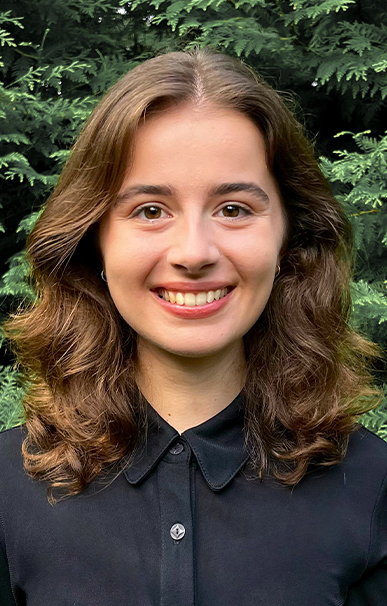 PROJECT
PROJECTMicrofluidics for Sustainability: Liquid Entrapment and Diffusiophoresis in Action
ORGANIZATION / LOCATIONComplex Fluids Group, Department of Mechanical and Aerospace Engineering, Princeton University - Princeton, New Jersey
MENTOR(S)Howard Stone, Donald R. Dixon ’69 and Elizabeth W. Dixon Professor of Mechanical and Aerospace Engineering; Samantha McBride, Postdoctoral Research Associate and Presidential Postdoctoral Research Fellow, Mechanical and Aerospace Engineering; Fernando Temprano-Coleto, Postdoctoral Research Associate, Andlinger Center for Energy and the Environment
I studied the mechanisms of liquid entrapment in a porous micro-channel for amine scrubbing carbon capture, a process that can be applied to various environmental, industrial, and research applications. Innovations in this area include using liquid-infused surfaces to decrease the footprint of carbon capture towers, though concerns persist regarding the stability of the liquid within the micro-textured surface. I used an analogous fluorinated oil/water system to evaluate the ways viscosity, velocity, and geometry affect the retention of liquid within pores in a quasi-one-dimensional system. As part of the research, I fabricated polydimethylsiloxane microfluidic devices, used a microscopic imaging system to visualize the process, and used the programs MATLAB and ImageJ to extract and visualize data. This internship provided substantial experience on collaborating in a lab space, performing analysis, and managing experiments. I had the opportunity to utilize auxiliary engineering skills such as CAD modeling and 3D printing, and to interact with professionals through workshops. I also gained exposure to other advanced scientific tools and procedures by assisting with associated experiments related to sustainable, nontoxic anti-scaling coatings. This experience has transformed my understanding of the pursuit of cutting-edge knowledge and I am excited to explore this further in future independent projects.
-
Kucukerbas, Deniz ’23
Electrical and Computer Engineering






 PROJECT
PROJECTMonitoring and Assessment at Kiburanga Primary School
ORGANIZATION / LOCATIONEngineers Without Borders (EWB), Princeton Chapter, Kenya - Isebania, Migori County, Kenya
MENTOR(S)Sigrid Adriaenssens, Professor of Civil and Environmental Engineering, Princeton University; Mahiri Mwita, Senior Lecturer in Princeton Institute for International and Regional Studies, Princeton University; Roger Price, Responsible Engineer in Charge, EWB
SEE PRESENTATIONCertificate(s): Computer Science, Finance
We traveled to Migori County, Kenya, as part of the Princeton Engineers Without Borders (EWB) Kenya team. This team has previously designed and implemented rainwater catchment systems in the nearby communities of Komosoko and Muchebe, as well as two solar-powered electric pumps in Kiburanga and Kubweye. During our most recent trip, we monitored and evaluated the pump at Kiburanga to assess its impacts. We addressed concerns through household surveys in the surrounding area, as well as through several meetings with stakeholders and management structures. We also had the opportunity to explore future projects, such as a larger distribution system, through meetings with potential partners and stakeholders. In addition, we were able to visit previous EWB projects and strengthen our relationships with these past partners. We found both the technical and community aspects of the project on this trip to be inspiring and rewarding, and we hope to continue increasing our impact through providing water access.
-
Levenson, Lucy ’25
Operations Research and Financial Engineering





 PROJECT
PROJECTMonitoring and Assessment in Peru
ORGANIZATION / LOCATIONEngineers Without Borders (EWB), Princeton Chapter, Peru - Carnachique, Peru; Pusunchás, Peru
MENTOR(S)Sigrid Adriaenssens, Professor of Civil and Environmental Engineering, Princeton University; Scott Gregory, Program Engineer, EWB
SEE PRESENTATIONCertificate(s): Archaeology, Hellenic Studies, Statistics and Machine Learning
Our team traveled to La Libertad, Peru, to complete the monitoring and evaluation phase of our project in Pusunchás and to begin the assessment phase of our new project in Carnachique. We aimed to close out the Pusunchás project by gauging community satisfaction with the construction of the gravity-fed potable water system. We did this through surveys and by completing a technical evaluation, walking through the system starting from the source captures through each of the distribution lines. During our assessment in Carnachique, we walked through the irrigation canals, taking notes on GPS data points in addition to qualitative features along the length of the 1.6 km system. We gained knowledge on this trip of the issues that the Carnachique community face and the reasons it is important to them that we complete this project. We also learned many technical details that are important for us to consider when we design the new system in Carnachique. Once the construction is complete, our team will travel to Peru one last time to ensure that the system is working properly; if it is, the team will find a new community with which to work. Overall, this experience has allowed us the opportunity to incorporate scientific research with our course work.
-
Martinez , Daniela ’24
Civil and Environmental Engineering





 PROJECT
PROJECTPotable Water System Assessment
ORGANIZATION / LOCATIONEngineers Without Borders (EWB), Princeton Chapter, Ecuador- Manabí, Ecuador
MENTOR(S)Sigrid Adriaenssens, Professor of Civil and Environmental Engineering, Princeton University; Nolan Perreira, Project Mentor, EWB
SEE PRESENTATIONOur team conducted the assessment phase of a potable water system project for the community of Rosario Vainas in Manabí, Ecuador. The goal of this project is to design and implement a water system that will provide potable water for approximately 180 households. Rosario Vainas is a small, rural village in the rainforest lowlands of Ecuador. Currently, residents receive their water from a combination of tanks delivered from a nearby city, small hand-dug wells in the area, and a nearby river. In order to design the new water system, our team collected data on the existing water sources in the community to determine the continuity of the underground aquifer and to quantify contamination levels from agricultural surface runoff. We also surveyed members of the community to understand water and electricity access and usage, climate trends in the area, and to receive community input on our project design. Through this fieldwork, we successfully obtained the requisite geological, geographic, and demographic data to design a well for the community. We also formed relationships with community members and a local nongovernmental organization, relationships that are essential for building trust and stability in the project.
-
Matthews, Aidan ’24
Civil and Environmental Engineering






 PROJECT
PROJECTMonitoring and Assessment at Kiburanga Primary School
ORGANIZATION / LOCATIONEngineers Without Borders (EWB), Princeton Chapter, Kenya - Isebania, Migori County, Kenya
MENTOR(S)Sigrid Adriaenssens, Professor of Civil and Environmental Engineering, Princeton University; Mahiri Mwita, Senior Lecturer in Princeton Institute for International and Regional Studies, Princeton University; Roger Price, Responsible Engineer in Charge, EWB
SEE PRESENTATIONWe traveled to Migori County, Kenya, as part of the Princeton Engineers Without Borders (EWB) Kenya team. This team has previously designed and implemented rainwater catchment systems in the nearby communities of Komosoko and Muchebe, as well as two solar-powered electric pumps in Kiburanga and Kubweye. During our most recent trip, we monitored and evaluated the pump at Kiburanga to assess its impacts. We addressed concerns through household surveys in the surrounding area, as well as through several meetings with stakeholders and management structures. We also had the opportunity to explore future projects, such as a larger distribution system, through meetings with potential partners and stakeholders. In addition, we were able to visit previous EWB projects and strengthen our relationships with these past partners. We found both the technical and community aspects of the project on this trip to be inspiring and rewarding, and we hope to continue increasing our impact through providing water access.
-
O'Neal, Parker ’24
Mechanical and Aerospace Engineering
 PROJECT
PROJECTPotable Water System Assessment
ORGANIZATION / LOCATIONEngineers Without Borders (EWB), Princeton Chapter, Ecuador- Manabí, Ecuador
MENTOR(S)Sigrid Adriaenssens, Professor of Civil and Environmental Engineering, Princeton University; Nolan Perreira, Project Mentor, EWB
SEE PRESENTATIONOur team conducted the assessment phase of a potable water system project for the community of Rosario Vainas in Manabí, Ecuador. The goal of this project is to design and implement a water system that will provide potable water for approximately 180 households. Rosario Vainas is a small, rural village in the rainforest lowlands of Ecuador. Currently, residents receive their water from a combination of tanks delivered from a nearby city, small hand-dug wells in the area, and a nearby river. In order to design the new water system, our team collected data on the existing water sources in the community to determine the continuity of the underground aquifer and to quantify contamination levels from agricultural surface runoff. We also surveyed members of the community to understand water and electricity access and usage, climate trends in the area, and to receive community input on our project design. Through this fieldwork, we successfully obtained the requisite geological, geographic, and demographic data to design a well for the community. We also formed relationships with community members and a local nongovernmental organization, relationships that are essential for building trust and stability in the project.
-
Olivas Biddle, Yvette ’25
Chemical and Biological Engineering





 PROJECT
PROJECTPotable Water System Assessment
ORGANIZATION / LOCATIONEngineers Without Borders (EWB), Princeton Chapter, Ecuador- Manabí, Ecuador
MENTOR(S)Sigrid Adriaenssens, Professor of Civil and Environmental Engineering, Princeton University; Nolan Perreira, Project Mentor, EWB
SEE PRESENTATIONOur team conducted the assessment phase of a potable water system project for the community of Rosario Vainas in Manabí, Ecuador. The goal of this project is to design and implement a water system that will provide potable water for approximately 180 households. Rosario Vainas is a small, rural village in the rainforest lowlands of Ecuador. Currently, residents receive their water from a combination of tanks delivered from a nearby city, small hand-dug wells in the area, and a nearby river. In order to design the new water system, our team collected data on the existing water sources in the community to determine the continuity of the underground aquifer and to quantify contamination levels from agricultural surface runoff. We also surveyed members of the community to understand water and electricity access and usage, climate trends in the area, and to receive community input on our project design. Through this fieldwork, we successfully obtained the requisite geological, geographic, and demographic data to design a well for the community. We also formed relationships with community members and a local nongovernmental organization, relationships that are essential for building trust and stability in the project.
-
Ormënaj, Loren ’23
Chemical and Biological Engineering





 PROJECT
PROJECTPotable Water System Assessment
ORGANIZATION / LOCATIONEngineers Without Borders (EWB), Princeton Chapter, Ecuador- Manabí, Ecuador
MENTOR(S)Sigrid Adriaenssens, Professor of Civil and Environmental Engineering, Princeton University; Nolan Perreira, Project Mentor, EWB
SEE PRESENTATIONOur team conducted the assessment phase of a potable water system project for the community of Rosario Vainas in Manabí, Ecuador. The goal of this project is to design and implement a water system that will provide potable water for approximately 180 households. Rosario Vainas is a small, rural village in the rainforest lowlands of Ecuador. Currently, residents receive their water from a combination of tanks delivered from a nearby city, small hand-dug wells in the area, and a nearby river. In order to design the new water system, our team collected data on the existing water sources in the community to determine the continuity of the underground aquifer and to quantify contamination levels from agricultural surface runoff. We also surveyed members of the community to understand water and electricity access and usage, climate trends in the area, and to receive community input on our project design. Through this fieldwork, we successfully obtained the requisite geological, geographic, and demographic data to design a well for the community. We also formed relationships with community members and a local nongovernmental organization, relationships that are essential for building trust and stability in the project.
-
Osofsky, Ezra ’21
Economics
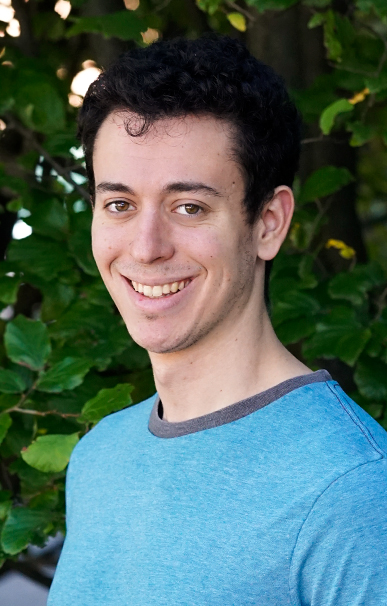 PROJECT
PROJECTData-intensive Analysis of the Climate-Water Crisis in India
ORGANIZATION / LOCATIONNITSAN Sustainable Development Lab, Tel Aviv University - Tel Aviv, Israel
MENTOR(S)Ram Fishman, Senior Lecturer (With Tenure), Public Policy, Tel Aviv University
SEE PRESENTATIONI used a detailed dataset of crimes in Karnataka, India, to determine the impact of both climate and crop prices on criminal activity. I worked with Professor Fishman, who studies issues at the intersection of the environment, agriculture, and economy of India. The theoretical basis for our research is that crop prices – which are affected by the weather – impact the incomes of both consumers and producers, and this in turn impacts incentives around criminal activity. This weather has both a direct (physiological) and an indirect impact on crime. This is particularly important in the context of global warming, as weather becomes both hotter and more volatile. My co-intern and I compiled, cleaned, analyzed, and summarized data, and then communicated our findings. The skill I developed the most through this project was how to succinctly and clearly distill ideas into simple visual and verbal formats. This increased my confidence in my research and data analysis skills and helped me narrow my interest with regard to working with data.
-
Paulraj, Akhil ’25
Computer Science
 PROJECT
PROJECTThe Interface of Hydrology and Machine Learning: Generating Better Information for Decision-makers and Educating the Decision-makers of the Future
ORGANIZATION / LOCATIONIntegrated GroundWater Modeling Center, Department of Civil and Environmental Engineering, Princeton University - Princeton, New Jersey
MENTOR(S)Reed Maxwell, Professor of Civil and Environmental Engineering and the High Meadows Environmental Institute; Lisa Gallagher, Education and Outreach Manager, High Meadows Environmental Institute
Certificate(s): Applied and Computational Mathematics, Statistics and Machine Learning
Groundwater is an increasingly important water resource, especially as drought and climate change make other sources of water more scarce. Mapping water table depth (WTD) and understanding the sensitivities of input parameters to WTD are of great use for decision-making, as well as hydrological modeling. As part of my project, I develop a deep learning emulator to predict steady-state WTD across the contiguous United States. I focused on exploring the relationships between WTD, hydraulic conductivity, and precipitation minus evapotranspiration. I created uncertainty distributions for the aforementioned variables by injecting Gaussian noise into the emulator, which enables an assessment of input parameter sensitivities. As I continue working on this project, my long-term goal is to calibrate the simulated steady-state WTD map to observation data using simulation-based inference to create an improved, continuous map of WTD that better matches field observations. Through this opportunity, I gained confidence in my practical understanding of machine learning, and I am now aware of the diverse ways in which machine learning can be applied to different scientific challenges. I also enjoyed teaching at The Watershed Institute’s Water and Climate Academy; it was a fulfilling and enriching experience that reinforced my passion for service.
-
Rausch, Ariana ’24
Mechanical and Aerospace Engineering





 PROJECT
PROJECTPotable Water System Assessment
ORGANIZATION / LOCATIONEngineers Without Borders (EWB), Princeton Chapter, Ecuador- Manabí, Ecuador
MENTOR(S)Sigrid Adriaenssens, Professor of Civil and Environmental Engineering, Princeton University; Nolan Perreira, Project Mentor, EWB
SEE PRESENTATIONCertificate(s): Robotics and Intelligent Systems
Our team conducted the assessment phase of a potable water system project for the community of Rosario Vainas in Manabí, Ecuador. The goal of this project is to design and implement a water system that will provide potable water for approximately 180 households. Rosario Vainas is a small, rural village in the rainforest lowlands of Ecuador. Currently, residents receive their water from a combination of tanks delivered from a nearby city, small hand-dug wells in the area, and a nearby river. In order to design the new water system, our team collected data on the existing water sources in the community to determine the continuity of the underground aquifer and to quantify contamination levels from agricultural surface runoff. We also surveyed members of the community to understand water and electricity access and usage, climate trends in the area, and to receive community input on our project design. Through this fieldwork, we successfully obtained the requisite geological, geographic, and demographic data to design a well for the community. We also formed relationships with community members and a local nongovernmental organization, relationships that are essential for building trust and stability in the project.
-
Rivera, Arielle ’23
Electrical and Computer Engineering





 PROJECT
PROJECTMonitoring and Assessment in Peru
ORGANIZATION / LOCATIONEngineers Without Borders (EWB), Princeton Chapter, Peru - Carnachique, Peru; Pusunchás, Peru
MENTOR(S)Sigrid Adriaenssens, Professor of Civil and Environmental Engineering, Princeton University; Scott Gregory, Program Engineer, EWB
SEE PRESENTATIONCertificate(s): Latin American Studies
Our team traveled to La Libertad, Peru, to complete the monitoring and evaluation phase of our project in Pusunchás and to begin the assessment phase of our new project in Carnachique. We aimed to close out the Pusunchás project by gauging community satisfaction with the construction of the gravity-fed potable water system. We did this through surveys and by completing a technical evaluation, walking through the system starting from the source captures through each of the distribution lines. During our assessment in Carnachique, we walked through the irrigation canals, taking notes on GPS data points in addition to qualitative features along the length of the 1.6 km system. We gained knowledge on this trip of the issues that the Carnachique community face and the reasons it is important to them that we complete this project. We also learned many technical details that are important for us to consider when we design the new system in Carnachique. Once the construction is complete, our team will travel to Peru one last time to ensure that the system is working properly; if it is, the team will find a new community with which to work. Overall, this experience has allowed us the opportunity to incorporate scientific research with our course work.
-
Rodrigues, Isabel ’23
Geosciences
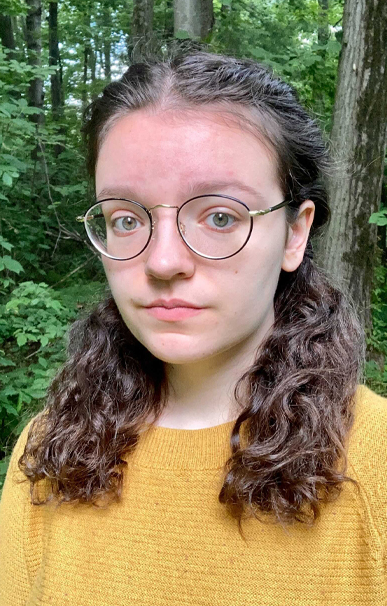 PROJECT
PROJECTUnderstanding Watershed Processes in Complex Terrain: Mountain Hydrology at Snodgrass Hillslope
ORGANIZATION / LOCATIONIntegrated GroundWater Modeling Center, Department of Civil and Environmental Engineering, Princeton University - Rocky Mountain Biological Laboratory, Gothic, Colorado
MENTOR(S)Reed Maxwell, Professor of Civil and Environmental Engineering and the High Meadows Environmental Institute; Jackson Swilley, Ph.D. candidate, Civil and Environmental Engineering
SEE PRESENTATIONCertificate(s): Environmental Studies
I studied the hydrologic characteristics of Snodgrass Hillslope, a high-altitude region in the Rocky Mountains of Colorado. This area is representative of other mountainous watersheds in the Western United States, and studying it has helped better inform models of water availability in the West. I assisted in the design and deployment of a multistep field campaign, extending a study that has been ongoing since 2018. My co-intern and I selected and mapped out two areas of study (one at higher altitude and another at lower altitude), translated the digital map we created to the physical site using a high-precision GPS, and completed a month-long, daily soil moisture study. We also applied several updates to the group’s three climate towers, including adding new sensors and solar panels. Finally, we installed a weir on a local stream, allowing us to measure changes to streamflow throughout the year. Simultaneously, I developed and proposed a long-term project that will investigate the effects of tree mortality on water circulation in this region. I’m grateful to have had this opportunity and am excited to continue working on this project in the fall.
-
Sontarp, Ethan ’24
Geosciences
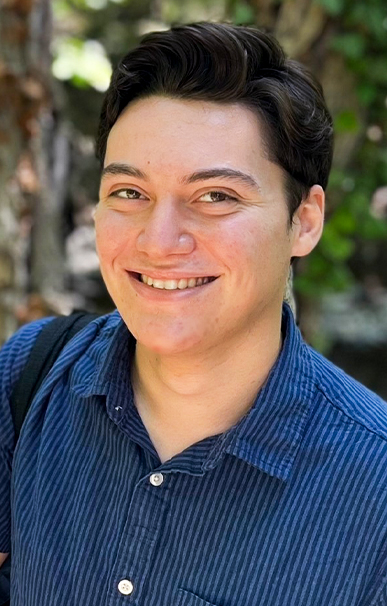 PROJECT
PROJECTAnthropogenic Impacts on Fluvial Organic-carbon Transport in Different Climates
ORGANIZATION / LOCATIONMolecular Environmental Geochemistry Group, Department of Geosciences, Princeton University - Princeton, New Jersey; Albaquerque, New Mexico; El Paso, Texas
MENTOR(S)Satish Myneni, Professor of Geosciences; Jianshu Duan, Ph.D. candidate, Geosciences
SEE PRESENTATIONCertificate(s): Environmental Studie
Dissolved organic matter (DOM) serves as a key component in the global carbon cycle: it transports organic carbon from land to ocean, while also facilitating the mobilization of toxic metals and environmental pollutants. The composition of DOM is highly variable and susceptible to alteration by microbial activity, chemical reactions caused by sunlight, and binding to minerals. Thus, anthropogenic disturbances to the surface water supply may modify the distribution and reactivity of its organic carbon. The comparison of DOM quality in varying climatic regions could improve our understanding of how human environmental manipulation and a changing climate exacerbate water quality issues. I designed a field and laboratory investigation of DOM, taking stream and irrigation water samples along rivers in temperate New Jersey and in the semi-arid Middle Rio Grande of New Mexico and Texas. I tested water samples for the amount of organic carbon present, the composition of various reactive chemical groups, and the similarity to source waters. I learned how to coordinate a successful fieldwork expedition to answer a research question, and I had the opportunity to connect with brilliant researchers at other institutions. I look forward to continue gaining firsthand experience with the complex global issues I learn about in class.
-
Storey-Matsutani, Mariko ’25
Mechanical and Aerospace Engineering
 PROJECT
PROJECTMicrofluidics for Sustainability: Liquid Entrapment and Diffusiophoresis in Action
ORGANIZATION / LOCATIONComplex Fluids Group, Department of Mechanical and Aerospace Engineering, Princeton University - Princeton, New Jersey
MENTOR(S)Howard Stone, Donald R. Dixon ’69 and Elizabeth W. Dixon Professor of Mechanical and Aerospace Engineering; Samantha McBride, Postdoctoral Research Associate and Presidential Postdoctoral Research Fellow, Mechanical and Aerospace Engineering; Fernando Temprano-Coleto, Postdoctoral Research Associate, Andlinger Center for Energy and the Environment
Certificate(s): Robotics and Intelligent Systems
My research focused on a novel method for microplastic particle separation that employs diffusiophoresis – the spontaneous migration of particles that are suspended in a solute with a concentration gradient. Diffusiophoretic particle separation offers a promising alternative to traditional filtration methods, which are hindered by energy inefficiency, high pumping costs, and membrane fouling. In my experiments, I used microfluidic channels to flow particle solutions through an induced CO2 ion concentration gradient. I then used fluorescence microscopy and image analysis programs such as ImageJ and MATLAB to investigate the maximum particle exclusion zone width as affected by variation in the solution flow rate, CO2 gas pressure, and microplastic particle diameter. Beyond this primary research objective, I contributed to microfluidic experiments investigating pore entrapment with applications in CO2 capture technology, and I proposed new ideas for microplastic particle separation that combines diffusiophoresis, inertial focusing, and pore entrapment. In addition to the further development of my technical and interpersonal skills, this internship enlightened me in how research can tackle real-world problems and has inspired me to continue to pursue my interest in sustainable innovation.
-
Su, Ellen ’23
Computer Science





 PROJECT
PROJECTMonitoring and Assessment in Peru
ORGANIZATION / LOCATIONEngineers Without Borders (EWB), Princeton Chapter, Peru - Carnachique, Peru; Pusunchás, Peru
MENTOR(S)Sigrid Adriaenssens, Professor of Civil and Environmental Engineering, Princeton University; Scott Gregory, Program Engineer, EWB
SEE PRESENTATIONCertificate(s): Applied and Computational Mathematics
Our team traveled to La Libertad, Peru, to complete the monitoring and evaluation phase of our project in Pusunchás and to begin the assessment phase of our new project in Carnachique. We aimed to close out the Pusunchás project by gauging community satisfaction with the construction of the gravity-fed potable water system. We did this through surveys and by completing a technical evaluation, walking through the system starting from the source captures through each of the distribution lines. During our assessment in Carnachique, we walked through the irrigation canals, taking notes on GPS data points in addition to qualitative features along the length of the 1.6 km system. We gained knowledge on this trip of the issues that the Carnachique community face and the reasons it is important to them that we complete this project. We also learned many technical details that are important for us to consider when we design the new system in Carnachique. Once the construction is complete, our team will travel to Peru one last time to ensure that the system is working properly; if it is, the team will find a new community with which to work. Overall, this experience has allowed us the opportunity to incorporate scientific research with our course work.
-
Swope, Natalie ’24
Economics
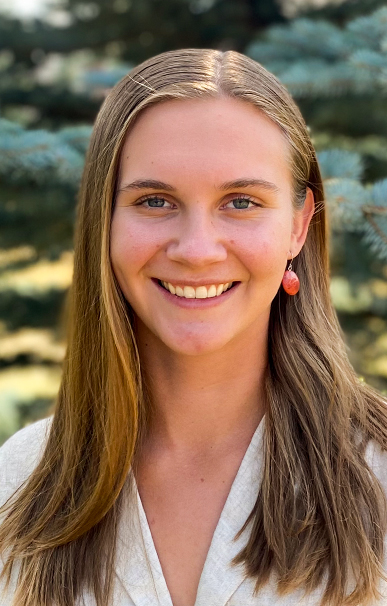 PROJECT
PROJECTWater Conservation Through Landscape Design in the Upper Gallatin River Watershed
ORGANIZATION / LOCATIONGallatin River Task Force - Big Sky, Montana
MENTOR(S)Emily O’Connor, Conservation Director, Gallatin River Task Force
SEE PRESENTATIONCertificate(s): Environmental Studies
I worked to advance Gallatin River Task Force’s (GRTF) recently developed Big Sky Water Conservation and Drought Management Plan. This plan is a community initiative to protect the streams and tributaries within the Upper Gallatin River Watershed, safeguard the community’s drinking water supply, and build resilience to climate change. I began by researching existing initiatives in similar communities and best practices around integrating water efficiency into land use planning. I compiled data from local stakeholders to document challenges and identify opportunities for further collaboration with GRTF. I drafted new landscape design guidelines for two homeowner’s associations; these guidelines incorporate principles from water wise, fire wise, and native plant land use design. GRTF will use my draft to create a set of comprehensive guidelines that any homeowner or homeowner association in Big Sky can adopt. I learned a lot about water supply and demand in a headwaters community, as well as factors that will influence both in the future. I also had the opportunity to engage with other facets of the organization, including fundraising, community outreach, and river algae monitoring. This was an amazing opportunity, and I plan to continue to study questions in water resource management in the future.
-
Taylor, Aubrey ’24
Civil and Environmental Engineering
 PROJECT
PROJECTMicrofluidics for Sustainability: Liquid Entrapment and Diffusiophoresis in Action
ORGANIZATION / LOCATIONComplex Fluids Group, Department of Mechanical and Aerospace Engineering, Princeton University - Princeton, New Jersey
MENTOR(S)Howard Stone, Donald R. Dixon ’69 and Elizabeth W. Dixon Professor of Mechanical and Aerospace Engineering; Samantha McBride, Postdoctoral Research Associate and Presidential Postdoctoral Research Fellow, Mechanical and Aerospace Engineering; Fernando Temprano-Coleto, Postdoctoral Research Associate, Andlinger Center for Energy and the Environment
I learned to manufacture microfluidic devices to replicate “solid with infused reactive liquid” (SWIRL) technology, a method to efficiently capture carbon from flue gas for sequestration. Flue gas from fossil-fuel powered generation plants contributes to a substantial portion of anthropogenic carbon dioxide emissions. SWIRL utilizes a micro-engineered surface coated in a thin layer of liquid amine that reacts with carbon dioxide. I ran experiments that measured the viscosity ratios of various oils to water, which introduced me to many advanced concepts in fluid mechanics. My experiments will be used to develop an oil-water system that can replace the amine and flue gas used in SWIRL for simplicity while we test its long-term stability. For accurate and efficient data analysis, I used ImageJ and MATLAB, to write programs that can scan through hours of videos to collect and organize relevant data. I also initiated a related microfluidics project that utilizes oil entrapment to remove microplastics for water purification. Overall, this experience has made me incredibly passionate about scientific research and the potential for combining mechanical engineering with my background in civil and environmental engineering.
-
Thiele, Klara ’27
Chemical and Biological Engineering





 PROJECT
PROJECTPotable Water System Assessment
ORGANIZATION / LOCATIONEngineers Without Borders (EWB), Princeton Chapter, Ecuador- Manabí, Ecuador
MENTOR(S)Sigrid Adriaenssens, Professor of Civil and Environmental Engineering, Princeton University; Nolan Perreira, Project Mentor, EWB
SEE PRESENTATIONCertificate(s): Engineering Biology
Our team conducted the assessment phase of a potable water system project for the community of Rosario Vainas in Manabí, Ecuador. The goal of this project is to design and implement a water system that will provide potable water for approximately 180 households. Rosario Vainas is a small, rural village in the rainforest lowlands of Ecuador. Currently, residents receive their water from a combination of tanks delivered from a nearby city, small hand-dug wells in the area, and a nearby river. In order to design the new water system, our team collected data on the existing water sources in the community to determine the continuity of the underground aquifer and to quantify contamination levels from agricultural surface runoff. We also surveyed members of the community to understand water and electricity access and usage, climate trends in the area, and to receive community input on our project design. Through this fieldwork, we successfully obtained the requisite geological, geographic, and demographic data to design a well for the community. We also formed relationships with community members and a local nongovernmental organization, relationships that are essential for building trust and stability in the project.
-
Trujillo , Daniel ’23
Civil and Environmental Engineering





 PROJECT
PROJECTMonitoring and Assessment in Peru
ORGANIZATION / LOCATIONEngineers Without Borders (EWB), Princeton Chapter, Peru - Carnachique, Peru; Pusunchás, Peru
MENTOR(S)Sigrid Adriaenssens, Professor of Civil and Environmental Engineering, Princeton University; Scott Gregory, Program Engineer, EWB
SEE PRESENTATIONOur team traveled to La Libertad, Peru, to complete the monitoring and evaluation phase of our project in Pusunchás and to begin the assessment phase of our new project in Carnachique. We aimed to close out the Pusunchás project by gauging community satisfaction with the construction of the gravity-fed potable water system. We did this through surveys and by completing a technical evaluation, walking through the system starting from the source captures through each of the distribution lines. During our assessment in Carnachique, we walked through the irrigation canals, taking notes on GPS data points in addition to qualitative features along the length of the 1.6 km system. We gained knowledge on this trip of the issues that the Carnachique community face and the reasons it is important to them that we complete this project. We also learned many technical details that are important for us to consider when we design the new system in Carnachique. Once the construction is complete, our team will travel to Peru one last time to ensure that the system is working properly; if it is, the team will find a new community with which to work. Overall, this experience has allowed us the opportunity to incorperate scientific research with our course work.
-
Zhang, Justin ’24
Civil and Environmental Engineering






 PROJECT
PROJECTMonitoring and Assessment at Kiburanga Primary School
ORGANIZATION / LOCATIONEngineers Without Borders (EWB), Princeton Chapter, Kenya - Isebania, Migori County, Kenya
MENTOR(S)Sigrid Adriaenssens, Professor of Civil and Environmental Engineering, Princeton University; Mahiri Mwita, Senior Lecturer in Princeton Institute for International and Regional Studies, Princeton University; Roger Price, Responsible Engineer in Charge, EWB
SEE PRESENTATIONCertificate(s): Visual Arts
We traveled to Migori County, Kenya, as part of the Princeton Engineers Without Borders (EWB) Kenya team. This team has previously designed and implemented rainwater catchment systems in the nearby communities of Komosoko and Muchebe, as well as two solar-powered electric pumps in Kiburanga and Kubweye. During our most recent trip, we monitored and evaluated the pump at Kiburanga to assess its impacts. We addressed concerns through household surveys in the surrounding area, as well as through several meetings with stakeholders and management structures. We also had the opportunity to explore future projects, such as a larger distribution system, through meetings with potential partners and stakeholders. In addition, we were able to visit previous EWB projects and strengthen our relationships with these past partners. We found both the technical and community aspects of the project on this trip to be inspiring and rewarding, and we hope to continue increasing our impact through providing water access.



